Gameroom Technical Walkthrough
NOTE: This document is a work in progress! We are updating the walkthrough with details for Splinter 0.4 and converting it to Markdown. For a complete version of the document, see the Gameroom Technical Walkthrough PDF.
Introduction
Distributed ledger technologies have the potential to revolutionize how businesses communicate and transact. We are leading the revolution with involvement in several open-source projects, including Sawtooth, Transact, and Splinter. This document outlines an example application, Gameroom, that uses technologies from each of these projects to demonstrate our vision of using smart contracts to enhance business and customer relationships.
Privacy and confidentiality between trading partners are important capabilities for (almost) all multi-party interactions. These capabilities are especially critical in distributed applications. As a result, the technology stack behind Gameroom differs from a common “shared-everything” blockchain design; instead, it sculpts the underlying blockchain-like distributed ledger technology into a sophisticated architecture that shares data only between the appropriate participants. Parts of this walkthrough are written as a script, in several acts, for which we recommend a dramatic reading (as if performed on stage by very amateur actors). Each act is followed by a “behind the scenes” chapter that describes the complex underlying technology and explains what really happens when running the deceptively simple Gameroom application. A glossary at the end defines the terms used by Splinter and the Gameroom application.
Note: This document is based on Splinter version 0.4. As Splinter matures, some details may change (such as the exact format of messages).
The Cast
Alice, an employee at Acme Corporation
Bob, a project leader at Bubba Bakery
Yoda, a VP at Yoyodyne Systems
Zixi, head of IT at Zymogen Industries
The Setting
Two Splinter nodes are set up, one at Acme Corporation and one at Bubba Bakery. Alice and Bob have each registered as a Gameroom user with an email address, a private key, and a password. The Prequel explains the details of node setup and user registration.
Prologue: An Initial Conversation
ALICE
Hi Bob.
Long pause. Alice rolls her eyes.ALICE
Anyway, we need to get moving on setup -- yeah -- sure, it is a bit silly, but we need to prove how our companies can use this new technology. We'll use the gameroom to play a few games of --
Another pause. Alice sighs.ALICE
Yes, we have to show that we can create a private and secure connection between our two companies. How about I send you -- right, I'll create the gameroom and you'll see my invitation in your app.
Alice logs into her Mac. Starts up the BROWSER and clicks on the ACME GAMEROOM bookmark. Browser displays a network error.ALICE
One second; I got this Mac from IT but it doesn’t have access to the corporate network -- yeah, I know. Actually, just let me know if you don't get my invitation in a few minutes -- Fine. OK, bye.
Alice hangs up the phone. Alice pushes the Macbook aside. Reaches into her bag and heaves out a Windows notebook. It looks old. Alice opens it up. Logs in. Starts up the BROWSER and clicks on the ACME GAMEROOM bookmark. The app starts to load.Act I: Alice and Bob Create a Gameroom
Scene 1: Alice logs into Acme’s Gameroom application
Alice looks at the GAMEROOM APP LOGIN SCREEN in her browser.
Alice enters her EMAIL and PASSWORD. Clicks LOG IN.
Success. The browser now displays the ACME GAMEROOM HOME SCREEN.
Scene 2: Alice creates a new gameroom
Alice sees an empty MY GAMEROOMS sidebar (no gamerooms exist yet). Alice creates a new gameroom by clicking on the + button next to My Gamerooms.
Alice sees the NEW GAMEROOM DIALOG.
Alice looks at the OTHER ORGANIZATION pulldown list. She selects BUBBA BAKERY.
Next, she enters a NAME for the new gameroom: Acme + Bubba.
Alice clicks SEND.
The New Gameroom dialog is replaced with the Acme Gameroom home screen. A TOAST NOTIFICATION tells Alice that her invitation has been sent to Bubba Bakery.
INTERMISSION
Live performances should include an intermission at this point, because there is a lot that just happened (see Behind the Scenes: A Look at Act I).
Scene 3: Bob logs into Bubba Bakery’s Gameroom application
BOB, muttering to himself, opens a BROWSER and searches for “tic tac toe”. Gets distracted by Wikipedia’s list of games. Plays Quantum Tic Tac Toe Online for 20 minutes. Eventually hunts through his email for the right link and starts the BUBBA BAKERY GAMEROOM APP.
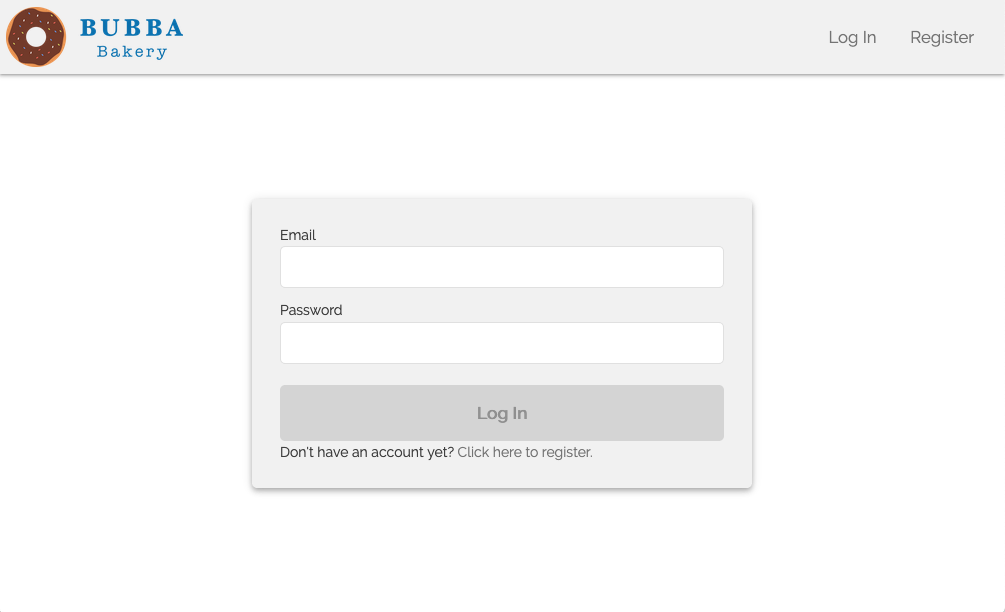
Bob logs in with his EMAIL and PASSWORD.
Success. The browser now displays the BUBBA BAKERY GAMEROOM HOME SCREEN.
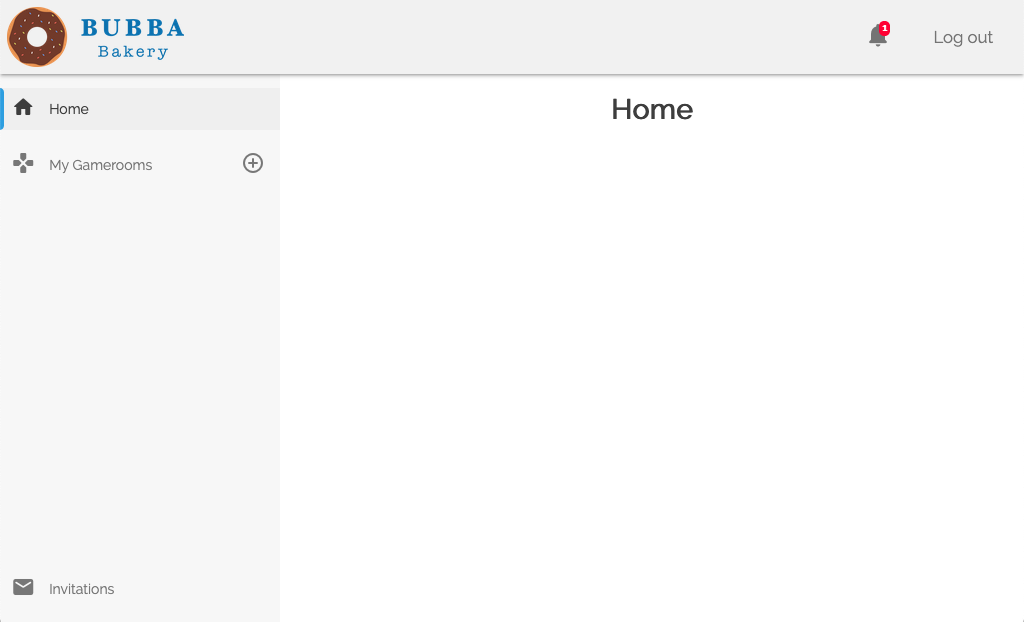
Scene 4: Bob checks his notifications
Bob sees that he has a notification and clicks on the NOTIFICATION ICON. The NOTIFICATION PANE shows an INVITATION from Alice.
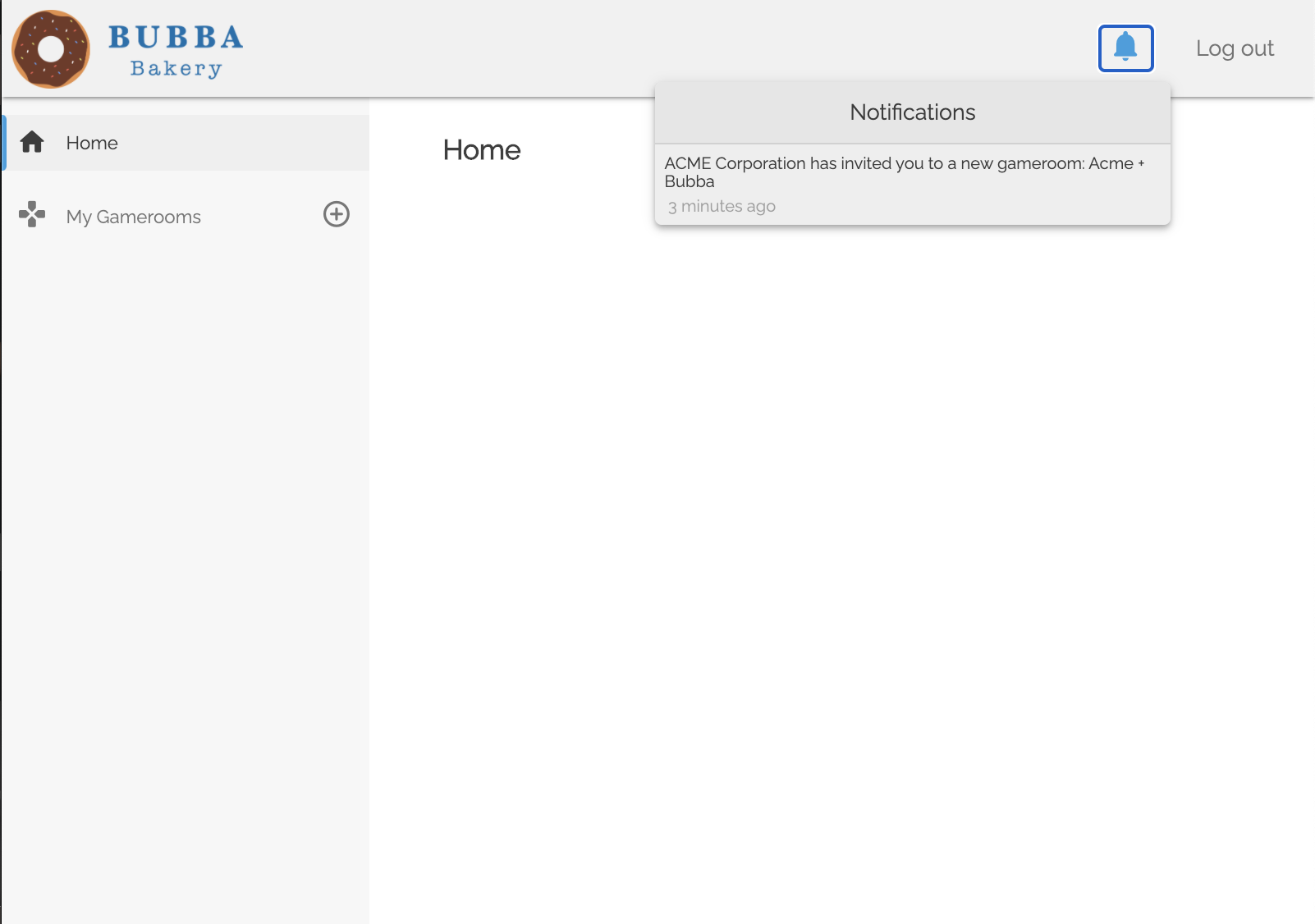
Scene 5: Bob accepts Alice’s gameroom invitation
Time passes.
Eventually, Bob clicks the notification. The notifications pane
disappears and the INVITATIONS TAB is shown. Bob clicks the
ACCEPT button on Alice’s invitation.
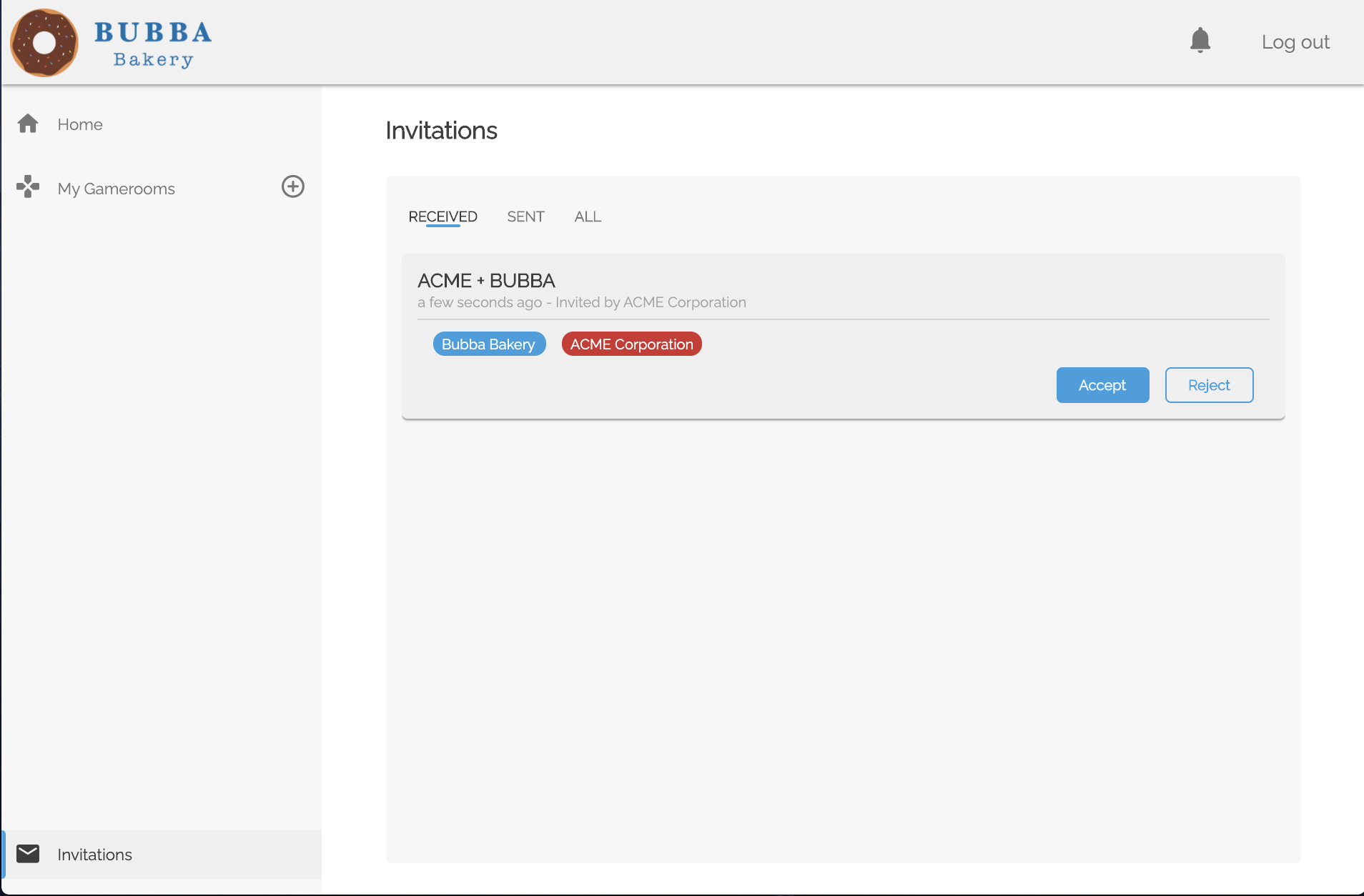
Scene 6: Alice sees that Bob accepted her invitation
Alice notices that she has a notification and clicks on the notification icon. The NOTIFICATIONS PANE appears, with the happy news that Bob has accepted her invitation and that the new Acme + Bubba gameroom has been created.
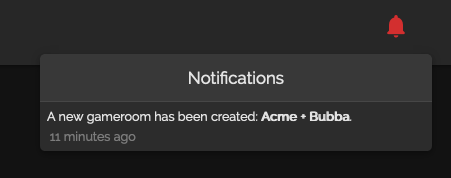
Alice clicks on the notification. The Notifications pane closes and Alice is redirected to the ACME + BUBBA GAMEROOM SCREEN.
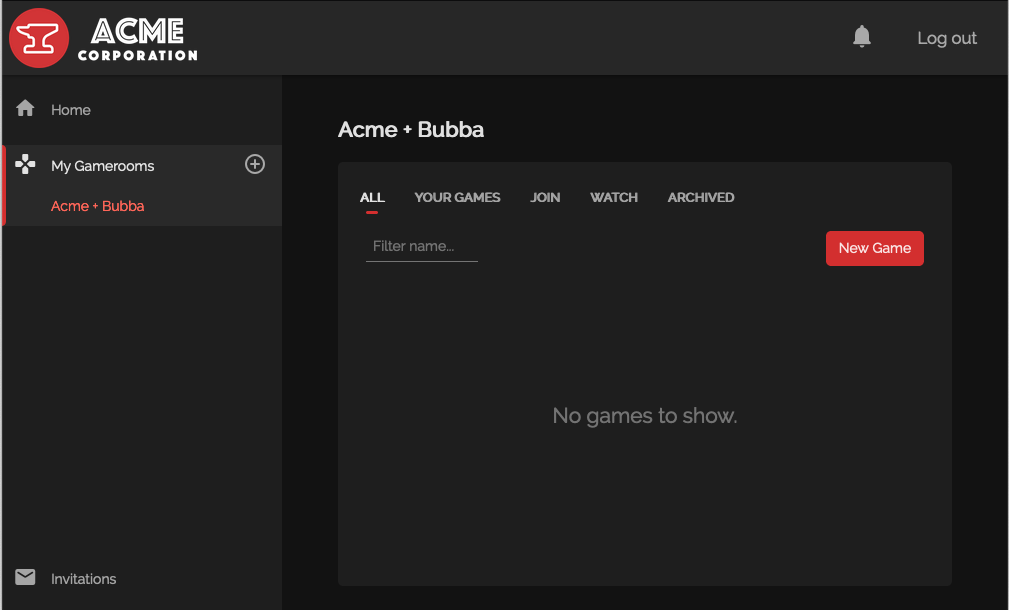
Alice and Bob’s gameroom is ready. They can now play games.
Behind the Scenes: A Look at Act I, Alice and Bob Create a Gameroom
I-1. Behind scene 1: Alice logs into Acme’s Gameroom UI
Gameroom uses Biome for user management, including authentication. For more information, check out the Biome overview.
When a user logs in, the user interface (UI) component of the Gameroom client application works with the Gameroom REST API to check the user’s email address and password and to ensure the user has a public and private key pair. Each Gameroom client communicates with a Gameroom daemon, using the Gameroom REST API in order to authenticate a Gameroom user. The Gameroom REST API uses the Biome REST API to authenticate the user credentials and to fetch key pairs associated with the user. Biome is a part of the Acme Splinter daemon. Each Splinter daemon stores the user credentials and keys in a local PostgreSQL database; user passwords are hashed by the Gameroom client so that they remain secret.
I-1.1. Acme UI sends authorization request to Gameroom REST API
When Alice clicks Log in, the Acme Gameroom UI hashes the password, then sends an authorization request to the Acme Gameroom daemon, gameroomd. The Gameroom daemon then makes several requests to the Biome REST API to verify the user.
The following request is sent to Acme’s Gameroom daemon:
POST /users/authenticate
{
"email": "alice@acme.com",
"hashedPassword": "8e066d41...d99ada0d"
}
The UI does not reveal the user’s password to the REST API because the password is used to encrypt signing keys (as described in section I-2.3, step 5).
I-1.2. Gameroom daemon uses Biome REST API to verify password
Once the Gameroom daemon receives the authentication request, the actual authentication is handled by the Biome REST API. This authentication request is sent from the Acme Gameroom daemon to the Biome REST API.
POST /biome/login
{
"username": "alice@acme.com",
"hashed_password": "56ec82cb...480cad32"
}
When the Biome REST API receives the authorization request for Alice, it fetches the entry from the Acme Splinter daemon’s local database associated with the username and verifies the hashed password sent in the request.
The user_credentials table in the Splinter database has the following schema:
CREATE TABLE IF NOT EXISTS user_credentials (
id BIGSERIAL PRIMARY KEY,
user_id TEXT NOT NULL,
username TEXT NOT NULL,
password TEXT NOT NULL,
);
The Splinter database has the following entry in the user_credentials table:
| user_id | username | password |
|---|---|---|
| 06ff2de0...9243ae2cf3 | alice@acme.com | 56ec82cb...480cad32 |
If the hashed password from the authentication request passes verification,
the Biome REST API will respond with a success response. This response includes
JSON Web Tokens, which enable the Gameroom REST API to make authorized requests
to the Biome REST API, without requiring the user to enter their password.
The refresh token included in the success response allows a new access token to
be issued, if the refresh token has not expired, when the original token issued
has expired. Each refresh token issued is saved to the refresh_tokens table in
the Splinter daemon database, with an associated user ID.
The refresh_tokens table in the Splinter database has the following schema:
CREATE TABLE IF NOT EXISTS refresh_tokens (
id BIGSERIAL PRIMARY KEY,
user_id TEXT NOT NULL,
token TEXT NOT NULL,
);
The Splinter database has the following entry in the refresh_tokens table:
| id | user_id | token |
|---|---|---|
| 1 | 06ff2de0...9243ae2cf3 | zeFgbILi...opBrt4ic |
If the credentials are verified, the Biome REST API will respond with the following success response:
{
"message": "Successful login",
"user_id": "06ff2de0...9243ae2cf3",
"token": "eyJhbGci...adQssw5c",
"refresh_token": "zeFgbILi...opBrt4ic",
}
I-1.3. Gameroom daemon uses Biome REST API to request Alice’s key pairs
Once the Gameroom daemon has verified Alice’s password, it must then verify that Alice has a public and private key pair. Alice’s public and private key pair was added to the Acme Splinter database during registration (see The Prequel, section P.2).
The request to list Alice’s associated keys is made to the Biome REST API.
GET /biome/keys
The request to the Biome REST API’s keys endpoint holds Alice’s
JSON Web Token in an Authorization header, which will enable the Splinter
daemon to authorize access to the user’s key information, as well as extract the
user ID from the token to fetch the keys from the Splinter daemon’s database.
The keys table in the Splinter database has the following schema:
CREATE TABLE IF NOT EXISTS keys (
public_key TEXT NOT NULL,
encrypted_private_key TEXT NOT NULL,
user_id TEXT NOT NULL,
display_name TEXT NOT NULL,
PRIMARY KEY(public_key, user_id)
);
Using the unique user_id from the access token, the keys associated with Alice
are fetched from the Splinter daemon’s database.
The Splinter database has the following entry in the keys table:
| display_name | user_id | public_key | encrypted_private_key |
|---|---|---|---|
| alice@acme.com | 06ff2de0...9243ae2cf3 | 0384781f...5a7e4998 | {\"iv\":...cgXrm\"} |
If the associated entry is found in the Splinter database keys table, a success
response with the list of key information is sent back to the Gameroom daemon.
{
"data": [
{
"public_key": "0384781f...5a7e4998",
"user_id": "06ff2de0...9243ae2cf3",
"display_name": "alice@acme.com",
"encrypted_private_key": "{\"iv\":\"...cgXrm\"}"
}
]
}
I-1.4. Gameroom REST API returns login success response
If the Gameroom REST API gets a successful response from both requests sent to the Biome REST API to verify the user, then the authentication was successful.
The Gameroom REST API sends a response to the Acme UI that contains Alice’s public key and encrypted private key.
{
"email": "alice@acme.com",
"public_key": "0384781f...5a7e4998",
"encrypted_private_key": "{\"iv\":\"...cgXrm\"}",
}
Next, the UI must gather the information for the Acme Gameroom home screen that Alice will see after logging in.
I-1.5. Acme UI requests a list of gamerooms
After a user has been authenticated, the UI gathers user-specific information for the home screen. First, it requests the list of existing gamerooms for that user. (At this point, no gamerooms exist.) Later, this walkthrough will describe what happens when there are gamerooms for the UI to display.
-
When Alice logs in, the Acme UI makes a call to the Gameroom REST API for the list of gamerooms.
GET /gamerooms -
This call returns an empty list, since there are no gamerooms in the Acme Gameroom’s PostgreSQL database.
{ "data": [], "paging": { "current": "/gamerooms?limit=100&offset=0", "offset": 0, "limit": 100, "total": 0, "first": "/gamerooms?limit=100&offset=0", "prev": "/gamerooms?limit=100&offset=0", "next": "/gamerooms?limit=100&offset=0", "last": "/gamerooms?limit=100&offset=0" } }
I-1.6. Acme UI requests a list of invitations
Next, the Acme Gameroom UI requests the list of gameroom invitations. In this scenario, Alice has no invitations, so the list is empty. Later, the walkthrough will show what happens when a user has unaccepted invitations.
-
When Alice logs in, the UI makes a call to the Gameroom REST API for the list of invitations (also called circuit proposals).
GET /proposals -
Because Alice has no invitations, the Gameroom REST API returns an empty list.
{ "data": [], "paging": { "current": "/proposals?limit=100&offset=0", "offset": 0, "limit": 100, "total": 0, "first": "/proposals?limit=100&offset=0", "prev": "/proposals?limit=100&offset=0", "next": "/proposals?limit=100&offset=0", "last": "/proposals?limit=100&offset=0" } }At this point, Alice sees the Acme Gameroom home screen with no existing gamerooms or invitations.
I-2. Behind scene 2: Alice creates a new gameroom
The Gameroom home screen includes a button to create a new gameroom. When a user clicks it, the UI requests the member list (possible other nodes) to use in the next dialog.
After the Acme UI has the member list, it displays the “New Gameroom” dialog, where Alice can use the members list to select her opponent (called Other organization in the dialog), and enter a name for the new gameroom. When she clicks Send, the Acme UI starts the process of sending Bob an invitation to the new gameroom.
A gameroom is enabled by a Splinter circuit that connects two or more systems,
or nodes. A registry stores a list of nodes that can participate in a
circuit; the Splinter daemon, splinterd, can provide this list of nodes upon
request. (The Gameroom example creates a registry that includes the Acme and
Bubba Bakery nodes.) Splinter uses the term members for the nodes that can be
connected (or are connected) on a circuit.
A gameroom invitation is also called a circuit proposal. Each gameroom proposal requires a vote (an approval) from each member, which is handled by two-phase commit consensus and a consensus proposal. When Alice creates a new gameroom, her action automatically includes a vote from her organization (Acme Corporation) that approves the creation of that gameroom. Her invitation to Bob, at Bubba’s Bakery, is actually a request for his organization’s vote to approve the new circuit.
I-2.1. Acme UI loads members list for New Gameroom dialog
First, the Acme Gameroom UI must load the list of members for the “New Gameroom” dialog. The general process looks like this:
-
The UI makes this REST API call to the Gameroom REST API.
GET /nodes -
The Gameroom REST API sends a GET request to the
/registry/nodesendpoint in the Splinter REST API asking for the list of nodes. -
The Splinter daemon,
splinterd, fetches the list of nodes from the registry and sends a response to the Gameroom REST API that includes the requested data. The “list of nodes” response looks like this:{ "data": [ { "identity": "bubba-node-000", "display_name": "Bubba Bakery", "endpoints": [ "tcps://splinterd-node-bubba:8044", ], "metadata": { "organization": "Bubba Bakery", }, "keys": [ "b1834871...2914a7f4", ], }, { "identity": "acme-node-000", "display_name": "ACME Corporation", "endpoints": [ "tcps://splinterd-node-acme:8044", ], "metadata": { "organization": "ACME Corporation", } "keys": [ "0384781f...5a7e4998", ], } ], "paging": { "current": "/registry/nodes?limit=100&offset=0", "offset": 0, "limit": 100, "total": 2, "first": "/registry/nodes?limit=100&offset=0", "prev": "/registry/nodes?limit=100&offset=0", "next": "/registry/nodes?limit=100&offset=0", "last": "/registry/nodes?limit=100&offset=0" } } -
The Gameroom REST API forwards the response to the Acme Gameroom UI, which uses the list of nodes to build the members list in the New Gameroom dialog.
I-2.2. Acme UI sends new Gameroom proposal to Gameroom REST API
-
In the New Gameroom dialog, Alice enters a unique name for the gameroom (Acme + Bubba) and selects Bubba Bakery from the Other Organizations list. Then she clicks Send to forward her invitation to Bob.
When Alice clicks on the Send button, the general process looks like this:
The UI sends a “create new gameroom” request to the Gameroom REST API that includes the gameroom name (also called an alias) and list of other members, besides the requesting node, in the proposed gameroom. Member entries only include the node ID, as gameroomd fetches the necessary member information from the Splinter registry.
The request (also called a proposal) looks like this:
POST /gamerooms/propose { "alias": "Acme + Bubba", "members": [ "bubba-node-000", ], } -
The Gameroom REST API sends a GET request to the
/registry/nodesendpoint in the Splinter REST API asking for the details of the proposed Gameroom member, using the node ID from the Acme UI “create new gameroom” request.This information is then used to complete the
CircuitManagementPayloadin the next step.
I-2.3. Gameroom REST API sends a CircuitManagementPayload
When the Acme Gameroom REST API receives the proposal request, it uses that
information to create a CircuitManagementPayload, which will eventually be sent
to the Acme Splinter daemon. Before sending the proposal request, the Gameroom
REST API asks the Gameroom UI to sign it with Alice’s information.
-
The Gameroom daemon uses the information from the “create new gameroom” request and the response from the
/registry/nodesendpoint to create a newCircuitManagementPayload.The following example shows a YAML representation of the
CircuitManagementPayload.Application metadata:
alias: Acme + Bubba // Gameroom name chosen by Alice scabbard_admin_keys: - <acme gameroomd public key>Circuit definition:
circuit_id: 01234-ABCDE authorization_type: Trust members: - node_id: acme-node-000 endpoints: [ - tcps://splinterd-node-acme:8044 ] - node_id: bubba-node-000 endpoints: [ - tcps://splinterd-node-bubba:8044 ] roster: - service_id: gr00 service_type: scabbard allowed_nodes: - acme-node-000 arguments: - peer_services: - gr01 admin_keys: - <acme gameroomd public key> - service_id: gr01 service_type: scabbard allowed_nodes: - bubba-node-000 arguments: - peer_services: - gr00 admin_keys: - <acme gameroomd public key> circuit_management_type: gameroom application_metadata: <bytes of the application metadata described above> persistence: Any durability: None routes: AnyHeader:
Action: CIRCUIT_CREATE_REQUEST requester: <public key of requester> // left empty by the REST API payload_sha512: <sha512 hash of the circuit definition described above> requester_node_id: acme-node-000CircuitManagementPayload:header: <bytes of header described above> circuit_create_request: <circuit definition described above> signature: <signature of bytes of the header> // left empty by the REST APINote that the Gameroom REST API does not fill in the requester field in the header or the signature in the
CircuitManagementPayload. -
Before the payload can be sent, the Acme UI must sign the bytes of the
CircuitManagementPayloadheader. The Acme Gameroom REST API serializes the payload and sends the bytes as a response to the UI.{ "data": { "payload_bytes": <bytes of the CircuitManagementPayload> } } -
After receiving the response from the Gameroom REST API, the Acme UI deserializes the
CircuitManagementPayload. It adds the requester’s public key to the header (in this case, Alice is the requester), serializes the header, signs the header bytes, and adds the signature to the payload. Finally, the UI serializes the complete payload. -
The Acme UI submits the bytes of the signed payload to the Gameroom REST API.
POST /submit Content-Type: application/octet-stream <bytes of the signed CircuitManagementPayload> -
The Acme Gameroom REST API forwards the payload to the Acme Splinter REST API.
POST /admin/submit Content-Type: application/octet-stream <bytes of the signed CircuitManagementPayload> -
The Acme Splinter REST API calls the Acme admin service to forward the proposed payload, a
CircuitManagementPayload(described in the next section).The protobuf is represented in YAML format:
CircuitManagementPayload: header: <bytes of header described above> circuit_create_request: circuit: 01234-ABCDE: auth: trust members: acme-node-000: endpoints: - tcps://splinterd-node-acme:8044 bubba-node-000: endpoints: - tcps://splinterd-node-bubba:8044 roster: gr00: service_type: scabbard allowed_nodes: - acme-node-000 arguments: - peer_services: - gr01 admin_keys: - <acme gameroomd public key> gr01: service_type: scabbard allowed_nodes: - bubba-node-000 arguments: - peer_services: - gr00 admin_keys: - <acme gameroomd public key> persistence: any durability: none routes: require_direct circuit_management_type: gameroom signature: <signature of bytes of requested circuit definition> -
The Acme admin service checks that the
CircuitManagementPayloadsignature is valid by comparing it against the header bytes and the requester public key stored in the header. -
Because the Acme and Bubba Bakery nodes are not yet peered (do not have an authorized connection on the Splinter network), the
CircuitManagementPayloadis placed in the “unpeered payloads” queue for unpeered nodes.
I-2.4. Acme node peers with Bubba Bakery node
Before the CircuitManagementPayload message can be validated, every member of
the circuit must be connected (peered).
The admin service on the Acme Splinter node (which has the service ID
admin::acme-node-000) is able to send requests using a PeerManagerConnector
to request the creation of a peer. The admin service also can use the
PeerManagerConnector to subscribe to notifications of the status of a peering
request. The PeerManagerConnector sends requests to the PeerManager. Peering
requests are counted by the PeerManager to ensure connections remain only as
long as they are needed.
-
Acme’s admin service uses the
PeerManagerConnector.add_peer_refwith the node ID and the endpoints listed in the proposed circuit to begin the peering process. -
PeerManagerConnector.add_peer_refsends a message,PeerManagerRequest::AddPeerincluding thepeer_idandendpoints, is sent to thePeerManager. APeerRefis returned to the admin service that represents the incremented count for peer requests to ensure the connection is maintained for as long as it is needed. The admin service must hold on to thisPeerReffor as long as the peer is used. -
The
PeerManagerreceives thePeerManagerRequestmessage and usesPeerManager.add_peerto create the connection. -
After the connection has been created, a message exchange starts for peer authorization (described in Appendix A).
-
If the connection is authorized, the connection is added to the Splinter network. The
PeerManagerthen sends aConnectedmessage to its subscribers. -
Once the admin service has received the
Connectedmessage, theCircuitManagementPayloadis removed from theunpeered_payloadsqueue and moved topending_protocol_payloadsqueue. Peers’ admin services with payloads in this list have yet to agree on a protocol version. Protocol versions are required to ensure the peers are running compatible versions of Splinter. This agreement must occur before any circuit management payloads can be handled. If these versions are not compatible, the payload will be dropped.The connecting admin service, Acme’s admin service, sends a request which specifies the minimum and maximum protocol versions that it can support. Bubba’s admin service responds with its highest supported version in the connecting service’s range. If the admin service’s agree on the protocol version, the admin service continues to process the payload.
-
Once Acme’s and Bubba’s admin services have agreed on a protocol version, the
CircuitManagementPayloadis moved to frompending_protocol_payloadstopending_circuit_payloads. The payload is now ready to go through consensus.
I-2.5. Splinter daemons use consensus to process the circuit request
At this point, the circuit proposal is ready to be validated and approved (voted on with two-phase commit consensus), as described in Appendix B.
During this process, the admin services on both nodes (admin::acme-node-000
and admin::bubba-node-000) must agree that the CircuitManagementPayload,
which includes CircuitCreateRequest, is a valid request. Consensus manages
each node’s approval of the proposal.
I-2.5.1. Acme node validates the CircuitManagementPayload
-
The Acme admin service verifies that the
CircuitManagementPayloadand the includedCircuitCreateRequestare valid.a. A
CircuitManagementPayloadrequest is valid if the following things are true:-
The
CircuitManagementPayloadmust contain a header and signature in bytes. -
The header in the payload must contain an action enum value, the public key of the requester, and hash of the action associated with the payload.
-
The action in the
CircuitManagementPayloadmust match the enum action in the payload. -
The signature must be valid for the bytes of the header and the requester public key stored in the header.
b. The provided payload (a
CircuitCreateRequest) is valid if the following things are true:-
The new circuit has a unique name (the node is not part of an existing circuit with that name). Circuit names do not need to be unique across all Splinter nodes. Two sets of nodes can use the same circuit name if there is no overlap in members in the circuit.
-
The circuit definition includes the node ID in the circuit member list.
-
For each service, every node in the service’s allowed node list is also present in the circuit member list.
-
There is no other pending proposal for a circuit with the same name.
-
The requester is registered for the Splinter node whose ID is in the
requester_node_idfield of theCircuitManagementPayloadheader. The requester is identified by the public key of the person who requested the new gameroom (in this example, Alice). -
The requester has permission to submit circuit proposals from that Splinter node.
To verify the node’s public key and proposal permission, the admin service checks the Splinter registry and key permissions manager.
-
The Splinter registry provides a way to look up details about a node, including registered public keys. The registry will be used to verify the public key used to sign a circuit proposal: the requester node ID, (which should be associated with the “home node” in order for the request to be valid).
-
The key permissions manager checks that a public key is authorized in a specific role. In the case of “create circuit” requests, the signing public key must be authorized for the “proposal” role.
-
-
If the request is valid, the Acme admin service creates a
CircuitProposalContextand stores it in the AdminServiceShared.pending_changesfield. TheCircuitProposalContextincludes the the proposed circuit, represented in aCircuitProposalstruct, also theCircuitManagementPayloadaction and the signer’s public key. The protobuf for theCircuitProposalis represented in YAML format.CircuitProposal: proposal_type: CREATE circuit_id: 01234-ABCDE circuit_hash: <hash of circuit> circuit_proposal: circuit: 01234-ABCDE: auth: trust members: acme-node-000: endpoints: - tcps://splinterd-node-acme:8044 bubba-node-000: endpoints: - tcps://splinterd-node-bubba:8044 roster: gr00: service_type: scabbard allowed_nodes: - acme-node-000 arguments: - peer_services: - gr01 admin_keys: - <acme gameroomd public key> gr01: service_type: scabbard allowed_nodes: - acme-node-000 arguments: - peer_services: - gr00 admin_keys: - <acme gameroomd public key> persistence: any durability: none routes: require_direct votes: [] requester: <public key of requester> requester_node_id: acme-node-000 -
The Acme admin service creates a consensus proposal (a
Proposalstruct) with the following contents:-
Proposal ID: the expected hash of the
CircuitManagementPayloadbytes -
Summary: bytes of the created
CircuitProposal -
List of required verifiers
An admin service running on a Splinter node does not have a fixed (static) list of required verifiers (services that must agree on a proposal through consensus). Instead, the admin service specifies the required verifiers as a list of admin service IDs that belong to the members of the proposed circuit, using a protobuf message called
RequiredVerifiers. This list is stored in the consensus data of the consensus proposal.The following protobuf, which is represented in YAML format, shows the consensus proposal.
required_verifiers: verifiers: - <admin::acme-node-000 as bytes> - <admin::bubba-node-000 as bytes> proposal: id: <hash of `CircuitManagementPayload` bytes> summary: <bytes of the create `CircuitProposal`> consensus_data: <bytes of required verifiers> -
I-2.5.2. Acme node sends Circuit Create request to Bubba Bakery node
After the Acme node creates the CircuitProposal, the CircuitManagementPayload
is sent to the other members defined in the circuit. In this case, the only
member is the admin service on the Bubba Bakery node.
-
First, the Acme admin service wraps
CircuitManagementPayloadin a series of messages to prepare it for sending across the Splinter network.a. The payload is wrapped in an
AdminMessage, which is a service-level message. The protobuf is represented in YAML format.admin_message: message_type: PROPOSED_CIRCUIT, propose_circuit: circuit_payload: <circuit_managment_payload> expected_hash: <expected hash of CircuitProposal generated by payload> required_verifiers: <bytes of the required verifiers from proposal>b. The
AdminMessageis then wrapped in anAdminDirectMessage, which enables the message to be sent over the Splinter network from Acme’s admin service to the Bubba Bakery admin service (which has the service IDadmin::bubba-node-000).admin_direct_message: circuit: admin sender: admin::acme-node-000 recipient: admin::bubba-node-000 payload: <serialized admin message> correlation_id: 6f04e471-f33a-4f9f-ad6f-5f80ab627133c. Next, the
AdminDirectMessageis wrapped in aCircuitMessage, which is the envelope that wraps all circuit-specific messages, such as direct messages and service connections.circuit_message: message_type: ADMIN_DIRECT_MESSAGE payload: <serialized admin_direct_message>d. In order to hide circuits from the network layer, which can be used without circuits, the
CircuitMessageis wrapped in aNetworkMessage.network_message: message_type: CIRCUIT payload: <serialized circuit_message> -
The Acme admin service sends this message over the admin circuit to the Bubba Bakery Splinter node.
I-2.5.3. Bubba Bakery node receives Circuit Create request from Acme node
The Bubba Bakery Splinter node receives the network message from the Acme node and starts the process of “unwrapping” the message with a series of dispatchers.
-
A dispatcher takes the message and passes it to the correct message handler based on the message type of the message. Each dispatcher either handles the message or forwards the message onto the next dispatcher.
a. The Bubba Bakery Splinter node passes the
NetworkMessageto the network dispatcher.b. The network dispatcher unwraps the
NetworkMessageto get theCircuitMessage, then sends it to the circuit dispatcher.c. The circuit dispatcher unwraps the
CircuitMessageto get theAdminDirectMessage, then passes it to the circuit handler for this type of message,AdminDirectMessageHandler. -
The
AdminDirectMessageHandlerchecks whether theAdminDirectMessageis valid. AnAdminDirectMessagemessage is valid if both the sender and the recipients of the message are admin services (the service ID of each is of the formadmin::<node_id>). -
If the
AdminDirectMessagemessage is valid, theAdminDirectMessageHandlerforwards it to the Bubba Bakery admin service. -
The Bubba Bakery admin service takes the
AdminMessageout of theAdminDirectMessageand inspects theAdminMessageto see if it containsAdminMessage::ProposedCircuit.If so, the admin service takes the
CircuitManagementPayloadout of theProposedCircuitmessage and passes it toAdminServiceShared.pending_circuit_payloads.
I-2.5.4. Bubba Bakery node validates CircuitManagementPayload
The Bubba Bakery admin service validates the CircuitManagementPayload using
the same steps as in
section I-2.5.1.
-
The admin service verifies that the
CircuitManagementPayloadand the includedCircuitCreateRequestare valid. (For details, see section I-2.5.1, step 1.) -
If the request is valid, the admin service creates a
CircuitProposaland stores it in theAdminServiceShared.pending_changesfield (see section I-2.5.1, step 2). -
The admin service creates a consensus proposal (a
Proposalstruct) with the proposal ID, summary, and the list of required verifiers. For more information, see section I-2.5.1, step 3.
I-2.5.5. Acme and Bubba Bakery reach consensus
When the admin services have validated the proposal and consensus has reached agreement, consensus will notify the admin services to commit the proposal. See Appendix B for more information about consensus.
I-2.6. Admin services commit pending circuit proposal
After the consensus notification, both admin services commit the
CircuitProposal. Now the new circuit is officially pending, which means that
the CircuitProposal is stored in the admin services’ state but the circuit is
not yet available for communication. A pending circuit proposal is also called
an “open circuit proposal”.
In the Gameroom example, the pending circuit ID is an 11-character string composed of two 5-character base-62 numbers separated by a dash, ‘-‘. In this walkthrough, we’ll use this example circuit ID:
01234-ABCDE
I-2.7. Admin services notify authorization handler of pending circuit proposal
-
After the circuit proposal has been committed, the admin service on each node checks if there are any registered application authorization handlers for the circuit management type in the proposed circuit (
01234-ABCDE). See The Prequel, section P.3, for more information on the registration process.An application authorization handler manages the voting strategy for the application and notifies the application of any events received from the admin service of the local Splinter node. This handler registers with an admin service for a specific circuit management type (also described in The Prequel, section P.3.
-
If there are any registered application authorization handlers for the proposed circuit management type, each admin service forwards the request to the local connected Gameroom application authorization handler.
The notification is sent on a WebSocket connection.
{
"eventType": "ProposalSubmitted",
"message": {
"proposal_type": "Create",
"circuit_id": "01234-ABCDE",
"circuit_hash": "...",
"circuit": {
"circuit_id":"01234-ABCDE",
"authorization_type": "Trust",
"members": [{
"node_id": "acme-node-000",
"endpoints": [
"tcps://splinterd-node-acme:8044",
],
},
{
"node_id": "bubba-node-000",
"endpoints": [
"tcps://splinterd-node-bubba:8044",
],
}
],
"roster": [{
"service_id": "gr00",
"service_type": "scabbard",
"allowed_nodes": [ "acme-node-000" ],
"arguments": {
"peer_services": [ "gr01" ],
"admin_keys": [
<acme gameroomd public key>
]
}
},
{
"service_id": "gr01",
"service_type": "scabbard",
"allowed_nodes": [ "bubba-node-000" ],
"arguments": {
"peer_services": [ "gr00" ],
"admin_keys": [
<acme gameroomd public key>
]
}
}
],
"circuit_management_type": "gameroom",
"application_metadata": <metadata bytes defined by the application>,
"persistence": "Any",
"durability": "None",
"routes": "Any",
},
"vote_record": [{}],
"requester": "public_key_of_requester",
"requester_node_id": "acme-node-000"
}
}
I-2.8. Gameroom daemons write notification to Gameroom database
When each Gameroom application authorization handler receives the gameroom
proposal on the WebSocket connection, it parses the information and adds it to
several tables in the Gameroom daemon’s local database: gameroom,
gameroom_member, gameroom_service, gameroom_proposal, and
gameroom_notification.
I-2.8.1. New gameroom table entry
First, the Gameroom application authorization handler adds a new entry to the gameroom table. This table contains the information about the circuit definition, including the data that was passed in the application_metadata field.
CREATE TABLE IF NOT EXISTS gameroom (
circuit_id TEXT PRIMARY KEY,
authorization_type TEXT NOT NULL,
persistence TEXT NOT NULL,
routes TEXT NOT NULL,
durability TEXT NOT NULL,
circuit_management_type TEXT NOT NULL,
alias TEXT NOT NULL,
status TEXT NOT NULL,
created_time TIMESTAMP NOT NULL,
updated_time TIMESTAMP NOT NULL,
);
-
circuit_id,authorization_type,persistence,routes,durability, andcircuit_management_typeare extracted directly from the circuit proposal message that is received from the Splinter daemon. -
aliasis extracted by deserializing the application metadata in the circuit proposal message. The alias is the gameroom name that Alice entered when creating the gameroom in the Acme UI. -
statusidentifies the current status of the gameroom. In this case, it is set to pending because the proposal to create this gameroom has not yet been accepted. -
created_timeis when the gameroom entry was introduced in the table. -
updated_timeis when the gameroom entry was last updated.
At the end of the operation, the gameroom table looks like this:
| circuit_id | authorization_type | persistence | routes | durability | circuit_management_type |
|---|---|---|---|---|---|
| 01234-ABCDE | Trust | Any | Any | None | gameroom |
| alias | status | created_time | updated_time |
|---|---|---|---|
| Acme + Bubba | pending | <time entry was created> | <time entry was updated> |
I-2.8.2. New gameroom_member table entry
Next, the Gameroom application authorization handler adds a new entry to the
gameroom_member table. This table contains the information about the members
of the circuit.
CREATE TABLE IF NOT EXISTS gameroom_member (
id BIGSERIAL PRIMARY KEY,
circuit_id TEXT NOT NULL,
node_id TEXT NOT NULL,
endpoint TEXT[] NOT NULL,
status TEXT NOT NULL,
created_time TEXT NOT NULL,
updated_time TEXT NOT NULL,
status TEXT NOT NULL,
FOREIGN KEY (circuit_id) REFERENCES gameroom(circuit_id) ON DELETE CASCADE
);
-
circuit_id,node_id, andendpointare extracted directly from the circuit proposal message received from the Splinter daemon. -
statusidentifies the current status of the member. In this case, it is set topendingbecause the proposal to create the gameroom has not yet been accepted. -
created_timeis when the gameroom member entry was introduced in the table. -
updated_timeis when the gameroom member entry was last updated.
At the end of the operation, the gameroom_member table looks like this:
| id | circuit_id | node_id | endpoint |
|---|---|---|---|
| <auto generated id> | 01234-ABCDE | acme-node-000 | tcps://splinterd-node-acme:8044 |
| <auto generated id> | 01234-ABCDE | bubba-node-000 | tcps://splinterd-node-bubba:8044 |
| status | created_time | updated_time |
|---|---|---|
| pending | <time entry was created> | <time entry was updated> |
| pending | <time entry was created> | <time entry was updated> |
I-2.8.3. New gameroom_service table entry
The Gameroom application authorization handler adds a new entry to the
gameroom_service table, which contains the information about the services of
the circuit.
CREATE TABLE IF NOT EXISTS gameroom_service (
id BIGSERIAL PRIMARY KEY,
circuit_id TEXT NOT NULL,
service_id TEXT NOT NULL,
service_type TEXT NOT NULL,
allowed_nodes TEXT[][] NOT NULL,
arguments JSON [] NOT NULL,
status TEXT NOT NULL,
last_event TEXT NOT NULL,
created_time TIMESTAMP NOT NULL,
updated_time TIMESTAMP NOT NULL,
FOREIGN KEY (circuit_id) REFERENCES gameroom(circuit_id) ON DELETE CASCADE
);
-
circuit_id,service_id,service_type,argumentsandallowed_nodesare extracted directly from the circuit proposal message received from the Splinter daemon. -
statusidentifies the current status of the service. In this case, it is set topendingbecause the proposal to create the gameroom has not yet been accepted. -
last_eventidentifies the last state change event the gameroom daemon received. This allows for the node to catch-up to current state change events if it has been stopped and restarted. -
created_timeis when the gameroom service entry was introduced in the table. -
updated_timeis when the gameroom service entry was last updated.
At the end of the operation, the gameroom_service table looks like this:
| id | circuit_id | service_type | service_id | allowed_nodes |
|---|---|---|---|---|
| <auto generated id> | 01234-ABCDE | scabbard | gr00 | {"acme-node-000"} |
| <auto generated id> | 01234-ABCDE | scabbard | gr01 | {"bubba-node-000"} |
| status | last_event | created_time | updated_time |
|---|---|---|---|
| pending | <last state change event> | <time entry was created> | <time entry was updated> |
| pending | <last state change event> | <time entry was created> | <time entry was updated> |
I-2.8.4. New gamerooom_proposal table entry
The Gameroom application authorization handler adds a new entry to the
gameroom_proposal table, which contains the information about the gameroom
proposal.
CREATE TABLE IF NOT EXISTS gameroom_proposal (
id BIGSERIAL PRIMARY KEY,
proposal_type TEXT NOT NULL,
circuit_id TEXT NOT NULL,
circuit_hash TEXT NOT NULL,
requester TEXT NOT NULL,
requester_node_id TEXT NOT NULL,
status TEXT NOT NULL,
created_time TIMESTAMP NOT NULL,
updated_time TIMESTAMP NOT NULL,
FOREIGN KEY (circuit_id) REFERENCES gameroom(circuit_id) ON DELETE CASCADE
);
-
circuit_id,proposal_type,circuit_hash,requesterandrequester_node_idare extracted directly from the circuit proposal message received from the Splinter daemon. -
statusidentifies the current status of the proposal. In this case, it is set topendingbecause the proposal to create the gameroom has not yet been accepted. -
created_timeis when the gameroom proposal entry was introduced in the table. -
updated_timeis when the gameroom proposal entry was last updated.
At the end of the operation, the gameroom_proposal table looks like this:
| id | circuit_id | proposal_type | circuit_hash |
|---|---|---|---|
| <auto generated id> | 01234-ABCDE | Create | <hash of circuit definition> |
| requester | requester_node_id | status |
|---|---|---|
| <public key of requester> | acme-node-000 | pending |
| created_time | updated_time |
|---|---|
| <time entry was created> | <time entry was updated> |
I-2.8.5. New gameroom_notification table entry
Finally, the Gameroom application authorization handler adds a new entry to the
gameroom_notification table. This table contains information about events that
the UI would like to notify the users about.
CREATE TABLE IF NOT EXISTS gameroom_notification (
id BIGSERIAL PRIMARY KEY,
notification_type TEXT NOT NULL,
requester TEXT NOT NULL,
requester_node_id TEXT NOT NULL,
target TEXT NOT NULL,
created_time TIMESTAMP NOT NULL,
read BOOLEAN NOT NULL,
);
-
notification_typeidentifies the type of event that generated this notification (in this case, agameroom_proposalevent). -
requesteridentifies the public key of the user that generated the event (in this case, Alice’s public key). -
targetis the identifier for the resource that was affected by the event (in this case, thecircuit_id). -
created_timeis when the notification entry was introduced in the table. -
updated_timeis when the notification entry was last updated.
At the end of the operation, the gameroom_notification table looks like this:
| id | notification_type | requester | requester_node_id |
|---|---|---|---|
| <auto generated id> | gameroom_proposal | <Alice's public key> | acme-node-000 |
| target | created_time | read |
|---|---|---|
| 01234-ABCDE | <time entry was created> | f |
I-2.9. Alice sees notification that gameroom invitation was sent
-
After the Acme Gameroom application authorization handler fills in the
gameroom_notificationtable, the Acme Gameroom REST API uses a WebSocket connection to tell the Acme UI about the new notification.{ "namespace": "notifications", "action": "listNotifications" } -
When the Acme UI receives that message, it sends a request to the Gameroom REST API to fetch a list of unread notifications from the database tables.
GET /notifications -
The Acme Gameroom REST API responds with the list of unread notifications.
{ "data": [ { "id": <auto generated id>, "notification_type": "gameroom_proposal", "requester": <Alice’s public key>, "node_id": "acme-node-000", "target": "01234-ABCDE", "timestamp": <time entry was created>, "read": false } ], "paging": { "current": "api/notifications?limit=100&offset=0", "offset": 0, "limit": 100, "total": 1, "first": "api/notifications?limit=100&offset=0", "prev": "api/notifications?limit=100&offset=0", "next": "api/notifications?limit=100&offset=0", "last": "api/notifications?limit=100&offset=0" } } -
The Acme UI updates its internal store with the new list of notifications. The notification that the user sees depends on whether they’re the requester or an invitee.
-
For the requester (Alice), the Acme UI displays a toast notification saying that the invitation has been sent.
-
An invitee sees a bell notification icon with number (a red badge that shows the number of unread notifications). If an invitee is not logged in, the notification will appear on the Gameroom home screen when the user logs in. For example, when Bob logs in, the Bubba Bakery UI will request the list so it can display the notification icon and the number on the home screen.
-
I-3. Behind scene 3: Bob logs into Bubba Bakery’s Gameroom application
When Bob logs in, the Bubba Bakery UI works with gameroomd, splinterd, and
both the Splinter and Gameroom REST API to check his user credentials and build
the Bubba Bakery Gameroom home page. This process is almost identical to Alice’s
login process. The only difference is that the Bubba Bakery Gameroom home page
will display a notification about his invitation from Alice.
I-3.1. Bubba Bakery UI sends authorization request to Gameroom REST API
This process is the same as the Acme process in section Ⅰ-1.1. For Bob, the general process looks like this:
When Bob clicks Log in, the Bubba Bakery Gameroom UI hashes the password,
then sends an authorization request to the Bubba Bakery Gameroom daemon,
gameroomd. Then, the Gameroom daemon makes some requests to the Biome REST
API to verify the user.
POST /users/authenticate
{
"email": "bob@bubbabakery.com",
"hashedPassword": "2b944c69...c11fcf9c"
}
As mentioned earlier, the UI does not reveal the user’s password to the REST API because the password is used to encrypt signing keys.
I-3.2. Gameroom daemon uses Biome REST API to verify password
After the Gameroom daemon has received the authentication request, the authentication is handled by the Biome REST API. The authentication request is sent from the Bubba Bakery Gameroom daemon to the Biome REST API.
POST /biome/login
{
"username": "bob@bubbabakery.com",
"hashed_password": "2b944c69...c11fcf9c",
}
When the Biome REST API receives the authorization request for Bob, it fetches the entry from the Bubba Bakery Splinter daemon’s local database associated with the username and verifies the hashed password sent in the request.
The user_credentials table in the Splinter database has the same schema as
described earlier in
section I-1.2.
For Bob, the Splinter database has the following entry in the user_credentials
table:
| user_id | username | password |
|---|---|---|
| 9g3rmce0...9823citbg5 | bob@bubbabakery.com | 2b944c69...c11fcf9c |
If the hashed password from the authentication request passes verification,
the Biome REST API will respond with a success response. This response includes
JSON Web Tokens, which enable the Gameroom REST API to make authorized requests
to the Biome REST API, without requiring the user to enter their password.
The refresh token included in the success response allows a new access token to
be issued, if the refresh token has not expired, when the original token issued
has expired. Each refresh token issued is saved to the refresh_tokens table in
the Splinter daemon database, with an associated user ID.
The refresh_tokens table in the Splinter database has the same schema as
described in section
section I-1.2.
Once Bob has logged in, the Splinter database has the following entry in the
refresh_tokens table:
| id | user_id | token |
|---|---|---|
| 1 | 9g3rmce0...9823citbg5 | gy9ubMNu...tyV87rco |
If Bob’s credentials are verified, the Biome REST API will respond with the following success response:
{
"message": "Successful login",
"user_id": "9g3rmce0...9823citbg5",
"token": "ihGhBIxc...923bby17",
"refresh_token": "gy9ubMNu...tyV87rco",
}
I-3.3. Gameroom daemon uses Biome REST API to request Bob’s key pairs
Once the Gameroom daemon has verified Bob’s password, it must then verify that Bob has an associated public and private key pair. Bob’s public and private key pair was added to the Bubba Bakery Splinter database during registration (see The Prequel, section P.2).
The request to list Bob’s associated keys is made to the Biome REST API.
GET /biome/keys
The request made to the Biome REST API holds Bob’s JSON Web Token in an
Authorization header, which enables the Splinter daemon to authorize access to
the user’s key information, as well as extract the user ID from the token to
fetch the keys from the Splinter daemon’s database.
The keys table schema in the Splinter database has the schema as described in
section
section I-1.3.
Using the unique user_id extracted from the access token, the public/private
key pair associated with Bob is fetched from the Splinter daemon’s database.
The Splinter database has the following entry in the keys table:
| display_name | user_id | public_key | encrypted_private_key |
|---|---|---|---|
| bob@bubbabakery.com | 9g3rmce0...9823citbg5 | b1834871...2914a7f4 | {\"iv\":...goPek\"} |
If Bob’s public/private key pair is found in the Splinter database keys table,
a success response with the list of key information is sent back to Bubba Bakery’s
Gameroom daemon with Bob’s associated keys.
{
"data": [
{
"public_key": "b1834871...2914a7f4",
"user_id": "9g3rmce0...9823citbg5",
"display_name": "bob@bubbabakery.com",
"encrypted_private_key": "{\"iv\":\"...goPek\"}"
}
]
}
I-3.4. Gameroom REST API returns login success response
If Bubba Bakery’s Gameroom REST API receives a successful response from the requests made to verify Bob’s credentials and keys, then the entire authentication process was successful. Therefore, the Gameroom REST API is then able to send a response to the Bubba Bakery UI that contains Bob’s public/private key pair.
{
"email": "bob@bubbabakery.com",
"public_key": "b1834871...2914a7f4",
"encrypted_private_key": "{\"iv\":\"...goPek\"}",
}
Next, the UI must gather the information for the Bubba Bakery Gameroom home screen that Bob will see after logging in.
I-3.5. Bubba Bakery UI requests list of existing gamerooms
As part of building the Bubba Bakery home screen for Bob, the UI requests the list of Bob’s gamerooms. This process is the same as the Acme process in section Ⅰ-1.4.
-
The Bubba Bakery UI makes a call to the Gameroom REST API for the list of existing gamerooms.
GET /gamerooms -
The Bubba Bakery Gameroom REST API returns an empty list, because there are no existing gamerooms in the Bubba Bakery Gameroom’s PostgreSQL database.
{ "data": [], "paging": { "current": "/gamerooms?limit=100&offset=0", "offset": 0, "limit": 100, "total": 0, "first": "/gamerooms?limit=100&offset=0", "prev": "/gamerooms?limit=100&offset=0", "next": "/gamerooms?limit=100&offset=0", "last": "/gamerooms?limit=100&offset=0" } }
I-3.6. Bubba Bakery UI requests list of gameroom invitations
As part of building the Bubba Bakery home screen for Bob, the UI requests the list of Bob’s invitations. This process is different from the Acme process in section Ⅰ-1.5, because Bob has a new invitation from Alice.
-
The Bubba Bakery UI makes a call to the Gameroom REST API for Bob’s list of invitations (also called circuit proposals).
GET /proposals -
The Bubba Bakery Gameroom REST API returns a list that includes Alice’s invitation.
{ "data": [ { "proposal_id": <auto-generated id>, "circuit_id": "01234-ABCDE", "circuit_hash": <hash of circuit definition>, "members": [ { "node_id": "acme-node-000", "endpoints": [ "tcps://splinterd-node-acme:8044", ], }, { "node_id": "bubba-node-000", "endpoints": [ "tcps://splinterd-node-bubba:8044" ] } ], "requester": <Alice's public key>, "requester_node_id": acme-node-000, "created_time": <time entry was created>, "updated_time": <time entry was updated> } ], "paging": { "current": "/proposals?limit=100&offset=0", "offset": 0, "limit": 100, "total": 1, "first": "/proposals?limit=100&offset=0", "prev": "/proposals?limit=100&offset=0", "next": "/proposals?limit=100&offset=0", "last": "/proposals?limit=100&offset=0" } }
I-3.7. Bubba Bakery UI queries for unread notifications
While building the Bubba Bakery home screen, the UI also requests the list of Bob’s unread notifications.
When the circuit proposal (Alice’s invitation) was created, the Bubba Bakery
admin service stored Bob’s notification information in the Gameroom database,
with the read field set to “false”. For the details of how the Gameroom
tables were updated during circuit creation, see section
Ⅰ-2.8
and section
Ⅰ-2.9.
-
The Bubba Bakery UI makes a call to the Bubba Bakery Gameroom REST API for the list of Bob’s unread notifications.
GET /notifications -
The Gameroom REST API queries the
gameroom_notificationtable and sends Bob’s notifications to the Bubba Bakery UI. The notification for Alice’s invitation looks like this:{ "data": [ { "id": <auto-generated id>, "notification_type": "gameroom_proposal", "org": "", "requester": <Alice's public key>, "node_id": "acme-node-000", "target": "01234-ABCDE", "timestamp": <time entry was created>, "read": <boolean; false means not read>, } ], "paging": { "current": "api/notifications?limit=100&offset=0", "offset": 0, "limit": 100, "total": 1, "first": "api/notifications?limit=100&offset=0", "prev": "api/notifications?limit=100&offset=0", "next": "api/notifications?limit=100&offset=0", "last": "api/notifications?limit=100&offset=0" }, }
At this point, the Bubba Bakery Gameroom UI has the information it needs to display Bob’s home screen.
I-4. Behind scene 4: Bob checks his notification
On Bob’s Bubba Bakery home screen, the UI displays Bob’s existing gamerooms on the left (none, at this point) and notifications in the upper right (as a bell icon). Bob’s public key is not listed as the requester on the gameroom_proposal notification, so the Bubba Bakery UI displays the notification icon with a red badge that indicates an unread notification.
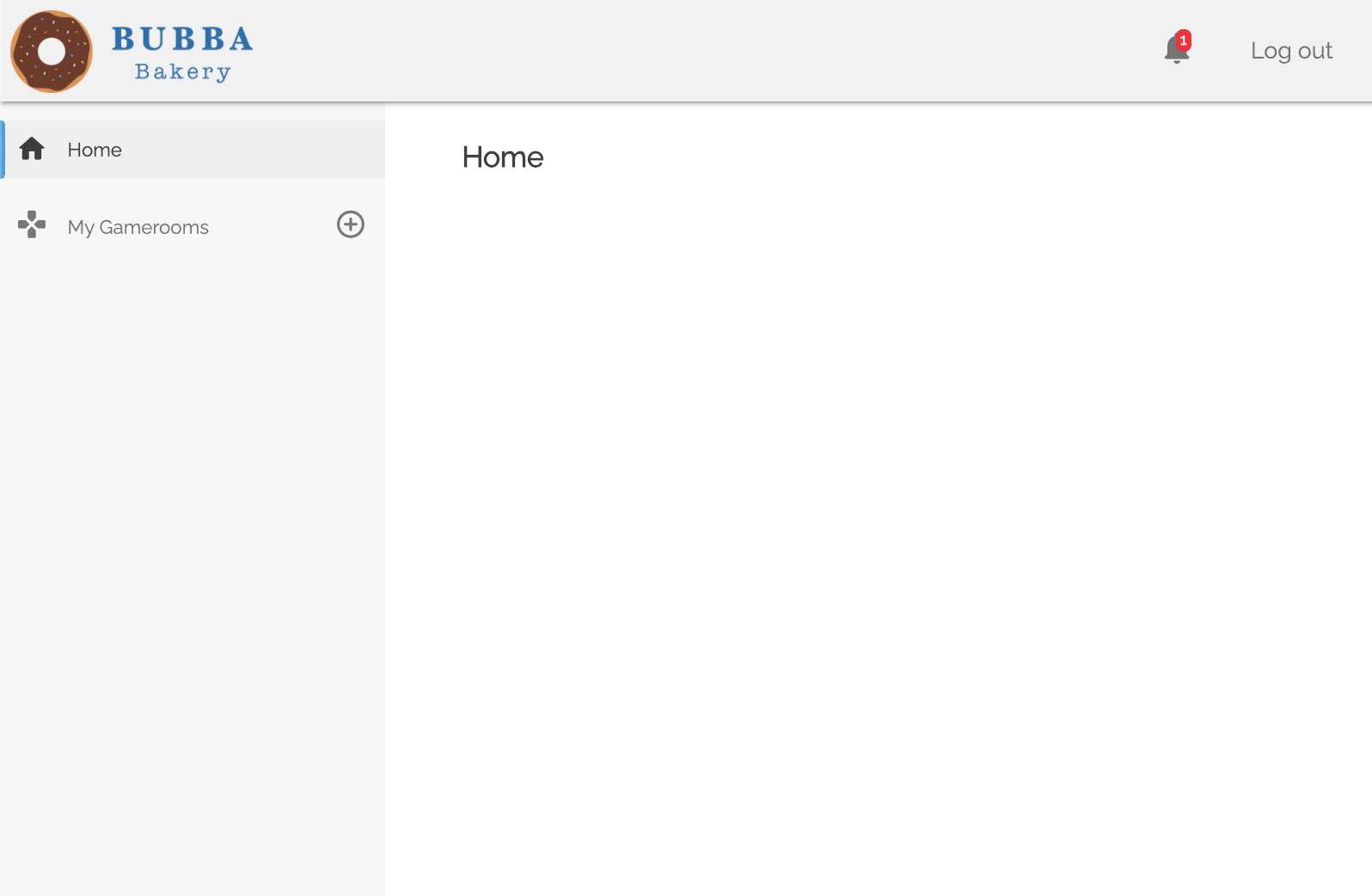
-
When Bob clicks the bell icon, the UI shows his unread notifications.

-
When Bob clicks on his notification, the Bubba Bakery UI calls the Bubba Bakery Gameroom REST API to update the selected notification (to show that Bob has read it). After the update, this notification will no longer show up as a new notification in the UI.
PATCH /notifications/{notification_id}/readThis call updates the notification’s entry read field in the Bubba Bakery database’s gameroom_notification table from false to true. For more information on this table, see section I-2.8.5.
-
After successfully updating the notification, the Bubba Bakery Gameroom REST API responds with the entire notification object.
{ "data": [ { "id": <auto generated id>, "notification_type": "gameroom_proposal", "requester": <Alice’s public key>, “requester_node_id”: “acme-node-000”, "target": "01234-ABCDE", "timestamp": <time entry was created>, "read": true } ] }
I-5. Behind scene 5: Bob accepts Alice’s invitation
When Bob accepts Alice’s invitation, the Bubba Bakery UI sends his “yes” vote to the Gameroom REST API, which forwards it to Splinter REST API. After the vote is validated, the admin service creates the circuit in Splinter state and tells the Gameroom daemon that the circuit is available.
Next, the Bubba Bakery admin service notifies the Acme node that it’s ready to create services. After the Acme node responds (described in “Behind Scene 6”), the Bubba Bakery admin service initializes its scabbard service for the new gameroom. Scabbard is the Splinter service for Gameroom that includes the Sawtooth Sabre transaction handler and Transact, using two-phase commit consensus to agree on state. Gameroom uses this service to store the XO smart contract and manage XO state. Finally, the Gameroom daemon updates the gameroom status in its local database from “Accepted” to “Ready”.
I-5.1. Bubba Bakery UI submits Accept Invitation request to Gameroom REST API
When Bob clicks on the Accept button, the Bubba Bakery Gameroom UI sends a vote (also called a “circuit vote request”) to the Gameroom REST API.
POST /proposals/vote
{
"circuit_id": "gameroom::acme-node-000::bubba-node-000::<UUIDv4>",
"circuit_hash": "8cd2bfcf3f4259b9785a723e19b4bb4d5cc0206e",
"vote": "Accept"
}
I-5.2. Gameroom REST API submits Proposal Accept request to Splinter REST API
-
When the Bubba Bakery Gameroom REST API receives the vote request, it uses that information to create a
CircuitManagementPayload, which will eventually be sent to the Bubba Bakery Splinter daemon. -
Before the payload can be sent, the Bubba Bakery UI must sign the bytes of the
CircuitManagementPayloadheader.The following example shows a YAML representation of the
CircuitManagementPayloadthat the Gameroom REST API creates.Circuit proposal vote:
circuit_id: gameroom::acme-node-000::bubba-node-000::<UUIDv4> circuit_hash: <sha256 hash of the circuit definition of the proposed circuit> vote: AcceptHeader:
Action: CIRCUIT_PROPOSAL_VOTE requester: <public key of requester> // left empty by the REST API payload_sha512: <sha512 hash of the circuit proposal vote described above> requester_id: <ID of the Splinter node that the requester is registered to>CircuitManagementPayload:header: <bytes of header described above> circuit_proposal_vote: <circuit proposal vote described above> signature: <signature of bytes of the header> // left empty by the REST APINote that the Gameroom REST API does not fill in the requester field in the header or the signature field in the
CircuitManagementPayload. -
The Bubba Bakery Gameroom REST API serializes the payload and sends the bytes as a response to the UI.
{ "data": { “payload_bytes”: <bytes of the CircuitManagementPayload> } } -
After receiving the response from the Gameroom REST API, the Bubba Bakery UI deserializes the
CircuitManagementPayload. It adds the requester’s public key to the header (in this case, Alice is the requester), serializes the header, signs the header bytes, and adds the signature to the payload. Finally, the UI serializes the complete payload. -
The Bubba Bakery UI submits the bytes of the signed payload to the Gameroom REST API.
POST /submit Content-Type: application/octet-stream <bytes of the signed CircuitManagementPayload> -
The Bubba Bakery Gameroom REST API forwards the payload to the Bubba Bakery Splinter daemon.
POST /submit Content-Type: application/octet-stream <bytes of the signed CircuitManagementPayload> -
The Splinter REST API responds with the status “202 Accepted” and the Bubba Bakery admin service processes the vote.
-
The Bubba Bakery REST API forwards the “202 Accepted” response to the Bubba Bakery UI.
I-5.3. Bubba Bakery node votes “yes” (validates the vote)
-
The Bubba Bakery admin service (
admin::bubba-node-000) receives theCircuitManagementPayloadcontaining aCircuitProposalVotefrom the Splinter REST API, and adds it to its pending circuit payloads queue.CircuitProposalVote: circuit_id: gameroom::acme-node-000::bubba-node-000::<UUIDv4> circuit_hash: <hash of circuit> vote: ACCEPT -
The Bubba Bakery admin service validates
CircuitManagementPayloadusing the same validation process described earlier (see section I-2.5.1, step 1). It also validates the provided payload (aCircuitProposalVote) using vote-specific validation rules.CircuitProposalVoteis valid if the following things are true:-
There is a pending
CircuitProposalin admin state with the same circuit ID as in theCircuitProposalVote -
The hash of the stored pending
CircuitProposalis the same as thecircuit_hashinCircuitProposalVote -
CircuitProposalVotevote field is set to either the Vote enumACCEPTorREJECT -
The public key belongs to a node in the circuit, and that node is allowed to submit the vote (see below).
-
CircuitProposaldoes not already contain a vote from that node. To verify the node’s public key and voting permission, the admin service checks the key registry and key permissions manager. -
The key registry provides a way to look up details about a public key used to sign a circuit proposal: the requester node ID (the “home node” of the requester and location of that user’s public key) and arbitrary metadata (represented as key/value string pairs).
-
The key permissions manager checks that a public key is authorized in a specific role. In the case of circuit proposal votes, the signing public key must be authorized for the role “voter”.
-
-
If the request is valid, the admin service makes a copy of the existing
CircuitProposal, adds a vote record to it, and stores it inAdminServiceShared.pending_changes. The protobuf is represented in YAML format.CircuitProposal: proposal_type: CREATE circuit_id: gameroom::acme-node-000::bubba-node-000::<UUIDv4>: circuit_hash: <hash of circuit> circuit_proposal: circuit: gameroom::acme-node-000::bubba-node-000::<UUIDv4>: auth: trust members: acme-node-000: endpoints: - tls://splinterd-node-acme:8044 bubba-node-000: endpoints: - tls://splinterd-node-bubba:8044 roster: gameroom_acme-node-000: service_type: scabbard allowed_nodes: - acme-node-000 arguments: - peer_services: - gameroom_bubba-node-000 admin_keys: - <acme gameroomd public key> gameroom_bubba-node-000: service_type: scabbard allowed_nodes: - acme-node-000 arguments: - peer_services: - gameroom_acme-node-000 admin_keys: - <acme gameroomd public key> persistence: any durability: none routes: require_direct circuit_management_type: gameroom votes: - public_key: <voter’s public key> vote: ACCEPT voter_node_id: bubba-node-000 requester: <public key of requester> requester_node_id: acme-node-000 -
The admin service creates a new consensus
Proposalfor the updatedCircuitProposal. (See section I-2.5.1, step 3, for theProposaldescription.)
I-5.4. Bubba Bakery node sends proposal accept vote to Acme node
-
After the Bubba node creates the updated
CircuitProposal, theCircuitManagementPayloadis sent to the other members defined in the circuit – specifically, the admin service on the Acme node (admin::acme-node-000). -
The Acme admin service receives the
CircuitMangementPayloadcontaining theCircuitProposalVote(as described in section I-5.3, step 1), validates the payload (see section I-5.3, step 2), and creates an updatedCircuitProposal(see section I-5.3, step 3). -
The nodes use consensus to agree to accept or reject the circuit proposal. See Appendix B for more information on consensus agreement.
-
After consensus has completed its agreement on the proposal, it notifies the Bubba Bakery admin service that both nodes have accepted the proposal. The Bubba Bakery admin service then commits the updated
CircuitProposal.
I-5.5. Bubba Bakery admin service checks for approval and creates a circuit
-
When the
CircuitProposalis committed, the Bubba Bakery admin service checks to see if it contains the required number ofACCEPTvotes to be added to Splinter state (theSplinterStatestruct), where active circuits are stored.The
CircuitProposalmust have aVoteRecordwith a vote ofACCEPTfrom every member of the proposed circuit definition, except for the requester (because submitting a circuit proposal counts as an accept vote). -
If a vote exists for every member, the Bubba Bakery admin service adds the circuit defined in the CircuitProposal to Splinter state. Once in Splinter state, the circuit is ready to accept service connections and be used for communication.
-
After the circuit has been created, the Bubba Bakery admin service creates the scabbard service using the service orchestrator (described in section I-5.8).
I-5.6. Bubba Bakery admin service notifies Gameroom daemon of new circuit
- The Bubba Bakery admin service notifies the Bubba Bakery application
authorization handler that the circuit has been accepted.
{ “eventType”: “ProposalAccepted”, “message”: { “proposal_type”: “Create”, “circuit_id”: “gameroom::acme-node-000::bubba-node-000::<UUIDv4>”, “circuit_hash”: “...”, “circuit”: { "circuit_id": "gameroom::acme-node-000::bubba-node-000::<UUIDv4>", "authorization_type": "Trust", "members": [{ "node_id": "acme-node-000", "endpoint": "tls://splinterd-node-acme:8044" }, { "node_id": "bubba-node-000", "endpoint": "tls://splinterd-node-bubba:8044" } ], "roster": [{ "service_id": "gameroom_acme-node-000", "service_type": "scabbard", "allowed_nodes": [ "acme-node-000"] "arguments": { "peer_services": [ "gameroom_bubba-node-000" ] "admin_keys": [ "<acme gameroomd public key>" ] } }, { "service_id": "gameroom_bubba-node-000", "service_type": "scabbard", "allowed_nodes": [ "bubba-node-000"] "arguments": { "peer_services": [ "gameroom_acme-node-000" ] "admin_keys": [ "<acme gameroomd public key>" ] } } ], "circuit_management_type": "gameroom", "application_metadata": [...], "persistence": "Any", "durability": "None", "routes": "Any" }, “vote_record”: [{ “public_key”: “<public key of voter>”, “vote”: “Accepted” "voter_node_id": “bubba-node-000” }], “requester”: “<public key of requester>” “requester_node_id”: “acme-node-000” } } -
When the application authorization handler receives this message, it updates the database to change the status of the proposal, gameroom, members and services from “Pending” to “Accepted”.
At the end of the database transaction, the gameroom database has the following updates:
-
gameroomtable:
circuit_id authorization_type persistence routes durability 01234-ABCDE Trust Any Any None circuit_management_type alias status created_time updated_time gameroom Acme + Bubba accepted <time status was updated> <time entry was created> -
gameroom_membertable
id circuit_id node_id endpoint <auto generated id> 01234-ABCDE acme-node-000 tls://splinterd-node-acme:8044 <auto generated id> 01234-ABCDE bubba-node-000 tls://splinterd-node-bubba:8044 status created_time updated_time accepted <time status was updated> <time entry was created> accepted <time status was updated> <time entry was created> -
gameroom_servicetable:
id circuit_id service_id service_type status <auto generated id> 01234-ABCDE gameroom_acme-node-000 scabbard accepted <auto generated id> 01234-ABCDE gameroom_bubba-node-000 scabbard accepted allowed_nodes arguments created_time updated_time {"acme-node-000"} "peer_services": ["gameroom_bubba-node-000"], "admin_keys": ... <time entry was created> <time status was updated> {"bubba-node-000"} "peer_services": ["gameroom_acme-node-000"], "admin_keys": ... <time entry was created> <time status was updated> -
gameroom_proposaltable:
id circuit_id proposal_type circuit_hash <auto generated id> 01234-ABCDE Create <hash of circuit definition> -
-
Finally, the application authorization handler updates the
gameroom_notificationtable to tell the UI that the gameroom proposal has been accepted.id notification_type requester requester_node_id <auto generated id> proposal_accepted <Bob's public key> bubba-node-000 target created_time read 01234-ABCDE <time entry was created> false
I-5.7. Bubba Bakery admin service sends “ready to create services” to Acme
Before the Bubba Bakery admin service can initialize its scabbard service on the
new circuit, it needs to know that the Acme Splinter node has also created the
circuit on the Acme side (added the circuit that is defined in the
CircuitProposal to Splinter state). The Acme process will be described in the
next chapter (section I-6).
This information is required because when a Splinter service connects to its own Splinter node (the node that it is allowed to connect to), that Splinter node sends a message to the other connected Splinter nodes on the new circuit that the service is available. This message cannot be sent until the Splinter node (in this case, the Acme node) has created the circuit.
If the circuit was not yet created on the other Splinter node (or nodes), the message would be dropped. This node would not be able to communicate with the other node’s service after the circuit is created, because it wouldn’t know where that service exists.
-
To notify the Acme admin service that the Bubba Bakery node is ready to initialize its service, the Bubba Bakery admin service sends an
AdminMessagewith the message typeMEMBER_READYand a “member ready” message that contains the circuit ID and Bubba Bakery’s node ID.admin_message: message_type: MEMBER_READY, member_ready: circuit_id: gameroom::acme-node-000::bubba-node-000::<UUIDv4> member_node_id: bubba-node-000 -
The Bubba Bakery admin service waits for Acme to respond with a “member ready” message. (The next section describes how the Bubba Bakery node initializes its services.)
I-5.8. Bubba Bakery admin service initializes scabbard service
After the circuit is created (described in section I-5.5) and all members are ready to create services (covered in section I-5.7), the Bubba Bakery admin service makes a call to the service orchestrator to initialize the scabbard service for the new gameroom. As described above, scabbard is the Splinter service for Gameroom that includes the Sawtooth Sabre transaction handler and Transact, using two-phase commit consensus to agree on state. Gameroom uses this service to store the XO smart contract and manage XO state.
-
The Bubba Bakery admin service checks which services are allowed to run on its node. In this case, the Bubba Bakery node (
bubba-node-000) is allowed to run the scabbard service with service IDgameroom_bubba-node-000. -
The admin service creates a ServiceDefinition for
gameroom_bubba-node-000, which is the scabbard service on the Bubba Bakery Splinter node.ServiceDefinition { circuit: "gameroom::acme-node-000::bubba-node-000::<UUIDv4>", service_id: "gameroom_bubba-node-000", service_type: "scabbard", } -
The admin service passes the service definition, along with the arguments defined in the
CircuitProposalfor that service, to the service orchestrator’sinitialize_servicemethod to initialize the scabbard service. -
ServiceOrchestratoruses structs that implement theServiceFactorytrait to create new services. An orchestrator can have multiple factories. First, the orchestrator must determine which factory can create a scabbard service (in this case, theScabbardFactory). Then the orchestrator creates a new instance of the scabbard service using that factory, the service definition, and the service arguments. -
After the scabbard service has been created, the orchestrator starts the service and adds it to its internally managed list of services. When starting the service, the orchestrator creates a
StandardServiceNetworkRegistry(used to register the service with the node) and passes it to the service; the scabbard service then registers, which provides it with aStandardServiceNetworkSenderthat it will use to send direct messages to other services.
I-5.9. Bubba Bakery Gameroom daemon updates gameroom status in database
At this point, the new service is running and ready to receive smart contracts.
-
The Bubba Bakery admin service sends a
CircuitReadynotification to the Gameroom daemon’s application authorization handler to let it know that the circuit is created and its services are ready.{ “eventType”: "CircuitReady", “message”: { “proposal_type”: “Create”, “circuit_id”: “gameroom::acme-node-000::bubba-node-000::<UUIDv4>”, “circuit_hash”: “...”, “circuit”: { "circuit_id": "gameroom::acme-node-000::bubba-node-000::<UUIDv4>", "authorization_type": "Trust", "members": [{ "node_id": "acme-node-000", "endpoint": "tls://splinterd-node-acme:8044" }, { "node_id": "bubba-node-000", "endpoint": "tls://splinterd-node-bubba:8044" } ], "roster": [{ "service_id": "gameroom_acme-node-000", "service_type": "scabbard", "allowed_nodes": [ "acme-node-000"] "arguments": { "peer_services": [ "gameroom_bubba-node-000" ] "admin_keys": [ "<acme gameroomd public key>" ] } }, { "service_id": "gameroom_bubba-node-000", "service_type": "scabbard", "allowed_nodes": [ "bubba-node-000"] "arguments": { "peer_services": [ "gameroom_acme-node-000" ] "admin_keys": [ "<acme gameroomd public key>" ] } } ], "circuit_management_type": "gameroom", "application_metadata": [...], "persistence": "Any", "durability": "None", "routes": "Any" }, “vote_record”: [{ “public_key”: “<public key of voter>”, “vote”: “Accepted” "voter_node_id": “bubba-node-000” }], “requester”: “<public key of requester>” “requester_node_id”: “acme-node-000” } } -
When the authorization handler receives the
CircuitReadymessage, it changes the status of the gameroom in the database from “Accepted” to “Ready”. -
The authorization handler creates a new
WebSocketto listen for events from the scabbard service. These events are then captured, parsed, and uploaded into the gameroom database. The process of reading state-change updates from Splinter and uploading them to a local database is called “state delta export” and is done by theXoStateDeltaProcessor. TheXoStateDeltaProcessorconsumesStateChangeEventpayloads, such as this example:{ “type”: “Set”, “message”: { “key”: “<xo_address>” “value” [<bytes>] } }The bytes in value field are deserialized into the following CSV-format representation of the XO game state:
“<game-name>,<game-board>,<game-state>,<player1-key>,<player2-key>”For more information on the XO game state, see Appendix D.
At this point, the circuit (Alice and Bob’s gameroom) is ready. Next, the Acme Gameroom daemon must submit the XO smart contract, which is the last step before the gameroom is ready for Alice and Bob to play games. See section Ⅰ-6.6 for an explanation of this process.
I-6. Behind scene 6: Bob accepts Alice’s invitation
Most of the steps in this scene are similar to the Bubba Bakery steps described earlier. However, one activity is unique — because the Acme node (Alice’s node) requested the new circuit, it is responsible for submitting the XO smart contract that will allow Alice and Bob to play tic tac toe in the new gameroom.
Ⅰ-6.1. Acme admin service receives CircuitProposalVote from Bubba Bakery
When the Acme Splinter node receives the CircuitManagementPayload network
message containing the Bubba Bakery CircuitProposalVote (sent in
section 5.4),
it “unwraps” the message with a series of dispatchers. See
section 2.7
for the details of this process.
As described in section 5.4, step 3, both nodes use consensus to agree on the circuit proposal, After they agree, the Acme node commits the CircuitProposal.
Ⅰ-6.2 Acme admin service checks for approval and creates circuit
When the CircuitProposal is committed, the Acme admin service checks that the Bubba Bakery node has voted “yes” (see section 5.3, then creates the circuit (adds the new circuit to Splinter state). For the details of this process, see section I-5.5.
Ⅰ-6.3. Acme admin service notifies Acme Gameroom daemon of new circuit
Once the circuit has been created, the Acme admin service tells the Acme application authorization handler that the circuit has been accepted. When the application authorization handler receives this message, it updates the database to change the status of the proposal, gameroom, members and services from “Pending” to “Accepted”. See section I-5.6 for the details of this process.
Ⅰ-6.4. Acme admin service tells Bubba Bakery that it is ready to create services
The Acme node notifies the Bubba Bakery node that it is ready to initialize the
Acme scabbard service by sending an an AdminMessage with the message type
MEMBER_READY and a “member ready” message that contains the circuit ID and
Acme’s Splinter node ID.
The Acme node waits for all members to report a “member ready” message before proceeding. For the details, see section I-5.7.
Ⅰ-6.5. Acme admin service creates scabbard service via service orchestration
After the Acme node learns that all members are ready to create services, the Acme admin service makes a call to the service orchestrator to initialize the scabbard service for the new gameroom. See section I-5.8 for the details of this process.
Ⅰ-6.6. Acme Gameroom daemon submits Sabre transactions to add XO smart contract
The Acme Gameroom daemon submits the XO smart contract by using the scabbard
REST API that is exposed by the Splinter daemon, splinterd.
When the Acme Gameroom daemon’s application authorization handler receives the
CircuitReady notification from the admin service, it subscribes to scabbard
and starts listening for scabbard events. See
Appendix C for the registration
(event subscription) process.
GET <circuit_id>/<service_id>/ws/subscribe
After a connection has been established, the application authorization handler prepares the XO (tic tac toe) business logic by submitting the XO smart contract to the Acme scabbard service.
The Acme gameroom daemon gets the following information from the
CircuitProposal that was just accepted (as described in
section I-5.9):
circuit_id: unique ID of the new circuit that includes a version 4 UUID, such
as gameroom::acme-node-000::bubba-node-000::<UUIDv4>
service_id: ID of the scabbard service that is running on the local Splinter
node; for example: gameroom_acme-node-000
scabbard_admin_keys: scabbard admin keys that are stored in the circuit
proposal’s application metadata
The scabbard admin keys in Gameroom’s application metadata specify who is
allowed to add or modify smart contracts. When the circuit is initially defined
(see section I-2.3),
the Gameroom daemon that creates the circuit definition (in this case, Acme’s
gameroomd) specifies its own public key as the scabbard admin. Since the Acme
Gameroom daemon has the only key that’s authorized to add smart contracts, it
is responsible for adding the XO smart contract.
To add the XO smart contract, the Acme Gameroom daemon creates a series of transactions to set the permissions surrounding the smart contract and to submit the smart contract itself. For more information, see the Sawtooth Sabre documentation.
The Acme Gameroom daemon bundles these transactions into a batch, serializes the batch, and submits the serialized batch to the scabbard service on its local Splinter node:
POST /scabbard/<circuit_id>/<service_id>/batches
<serialized batch>
For more information about batches, see “Transactions and Batches” in the Sawtooth Architecture documentation.
When the Acme scabbard service receives this batch, it must agree with the Bubba Bakery scabbard service to submit the smart contract. The Acme scabbard service performs the following steps:
a. Deserializes the batch: Shares the batch with the other scabbard services in the circuit (in this case, the Bubba Bakery scabbard service)
b. Creates a consensus proposal to send to the admin services of the other nodes (in this case, Bubba Bakery’s scabbard service) to agree on the batch
c. Waits for consensus to agree on the batch, then commits it to scabbard state. For information on consensus, see Appendix B.
d. After the scabbard services on both nodes have committed the smart contract, the Acme Splinter node is done setting up the gameroom.
Ⅰ-6.7. Both Gameroom daemons update gameroom status in database
The application authorization handler listens for scabbard events using its
state delta processor, XoStateDeltaProcessor. When the state delta processor
receives an event with the address of the uploaded XO contract it then sets the
status of the gameroom to “circuit_active”
StateChangeEvent containing contact address
{
“type”: “Set”,
“message”: {
“key”: “<xo_contract_address>”
“value” [..]
}
}
At this point, the state delta processor will begin listening for XO game state changes (defined in Appendix D).
Ⅰ-6.8. Acme Gameroom daemon notifies Acme UI
After the state delta processor sets the status of the gameroom to
“circuit_active”, the Acme Gameroom application authorization handler adds a
new entry to the gameroom_notification table:
| id | notification_type | requester | requester_node_id |
|---|---|---|---|
| <auto generated id> | gameroom_proposal | <Alice's public key> | acme-node-000 |
| target | created_time | read |
|---|---|---|
| 01234-ABCDE | <time entry was created> | f |
This notification is pushed to the Acme UI in the same way as the “gameroom_proposal” notification. (See section I-2.8.4)
Ⅰ-6.9. Alice sees notification that new gameroom is ready
After the notification is pushed to the Acme UI, Alice sees a new notification. The new gameroom also appears on the dashboard menu.
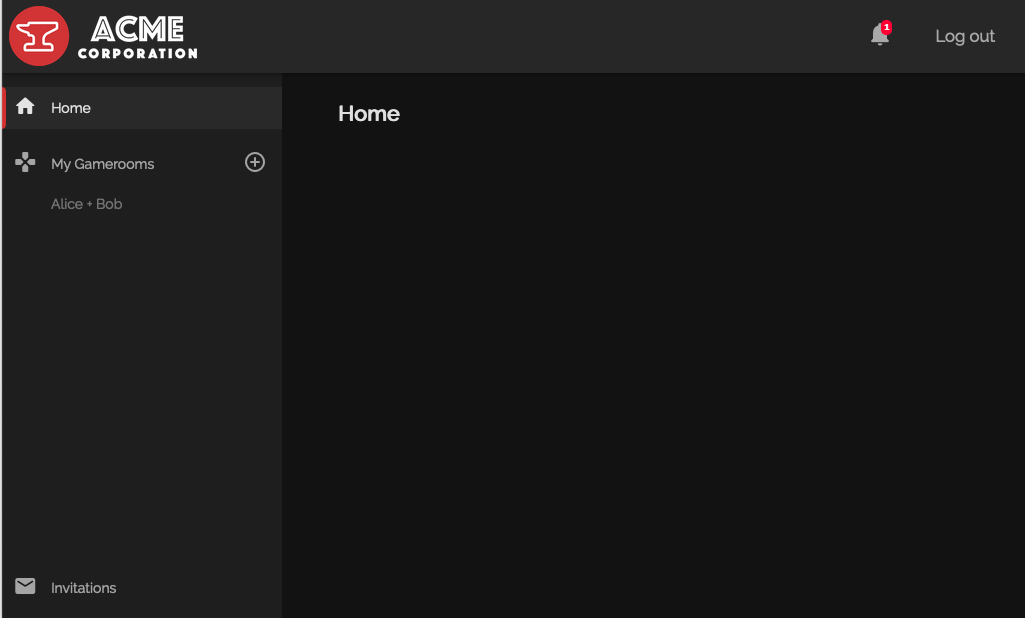
When Alice clicks on the notification, she sees the details page for the new gameroom. (See Behind Scene 4, Bob Checks his Notifications)
Act II: Alice and Bob Play XO
Scene 1: Alice creates a new XO game
Alice returns from lunch and unlocks her computer. The GAMEROOM TAB is still displayed.
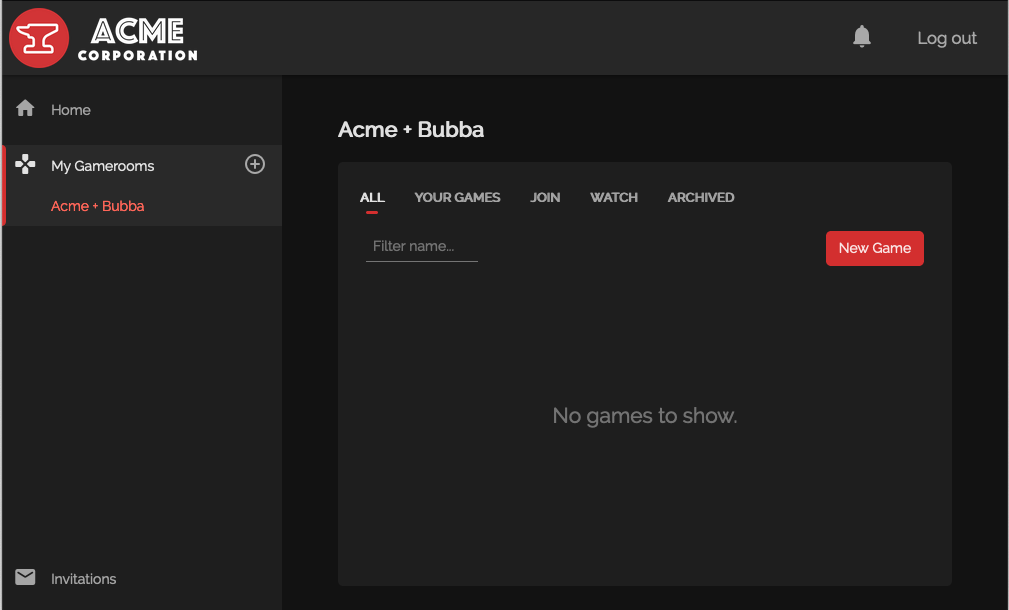
Alice wants to play an XO game. She clicks New Game. Alice sees the NEW GAME DIALOG.
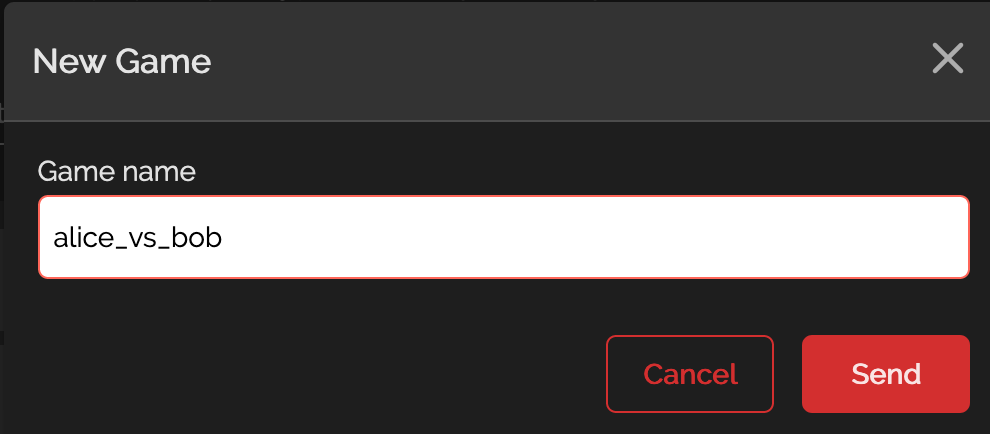
Alice enters “alice_vs_bob” as the game name. She clicks the SEND BUTTON.
The Gameroom application starts creating the game. Alice sees a new
alice_vs_bob entry with a SPINNER and the message “CREATING GAME”.
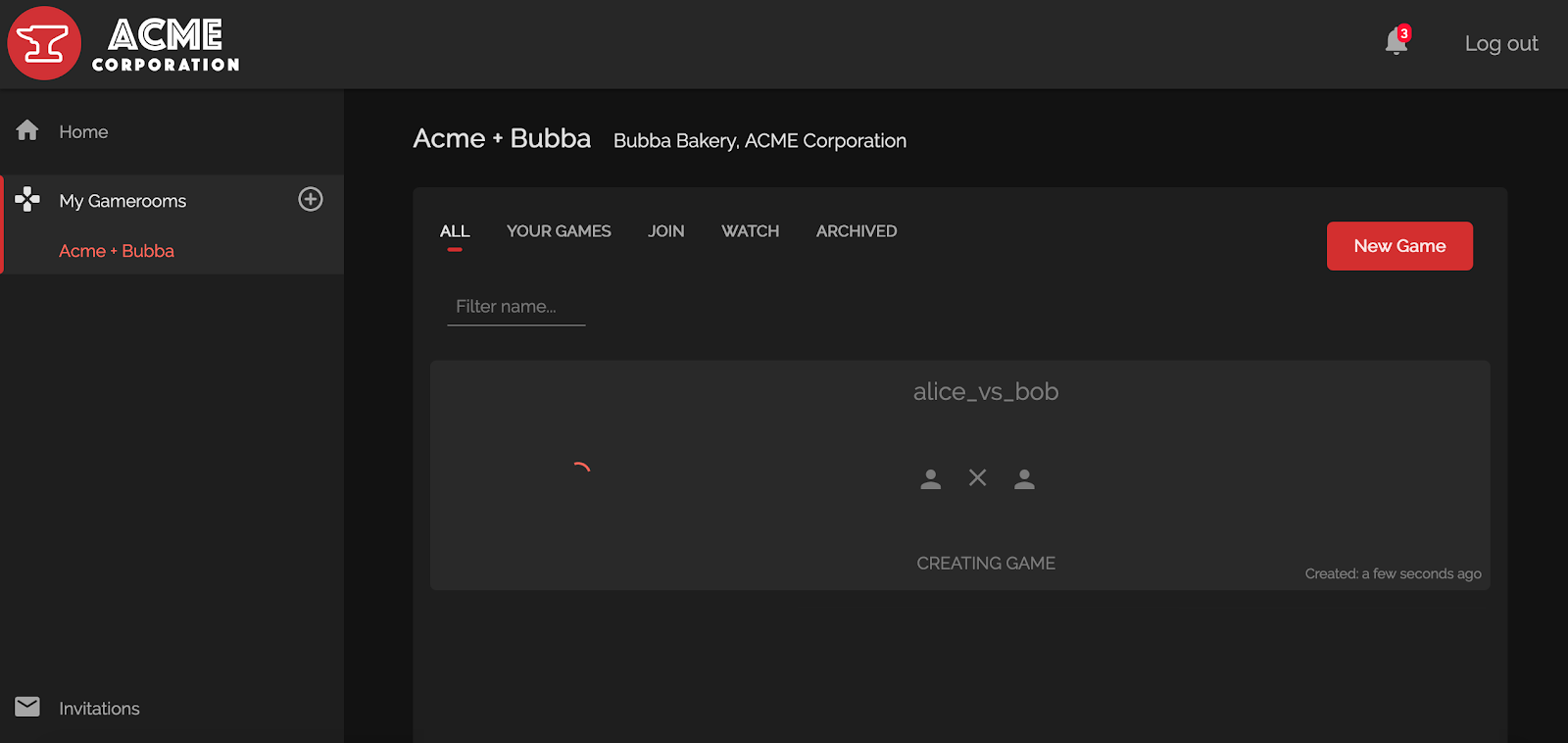
A short period of time passes. When the game has been fully created, Alice sees a blank game board and the message “JOIN GAME”.
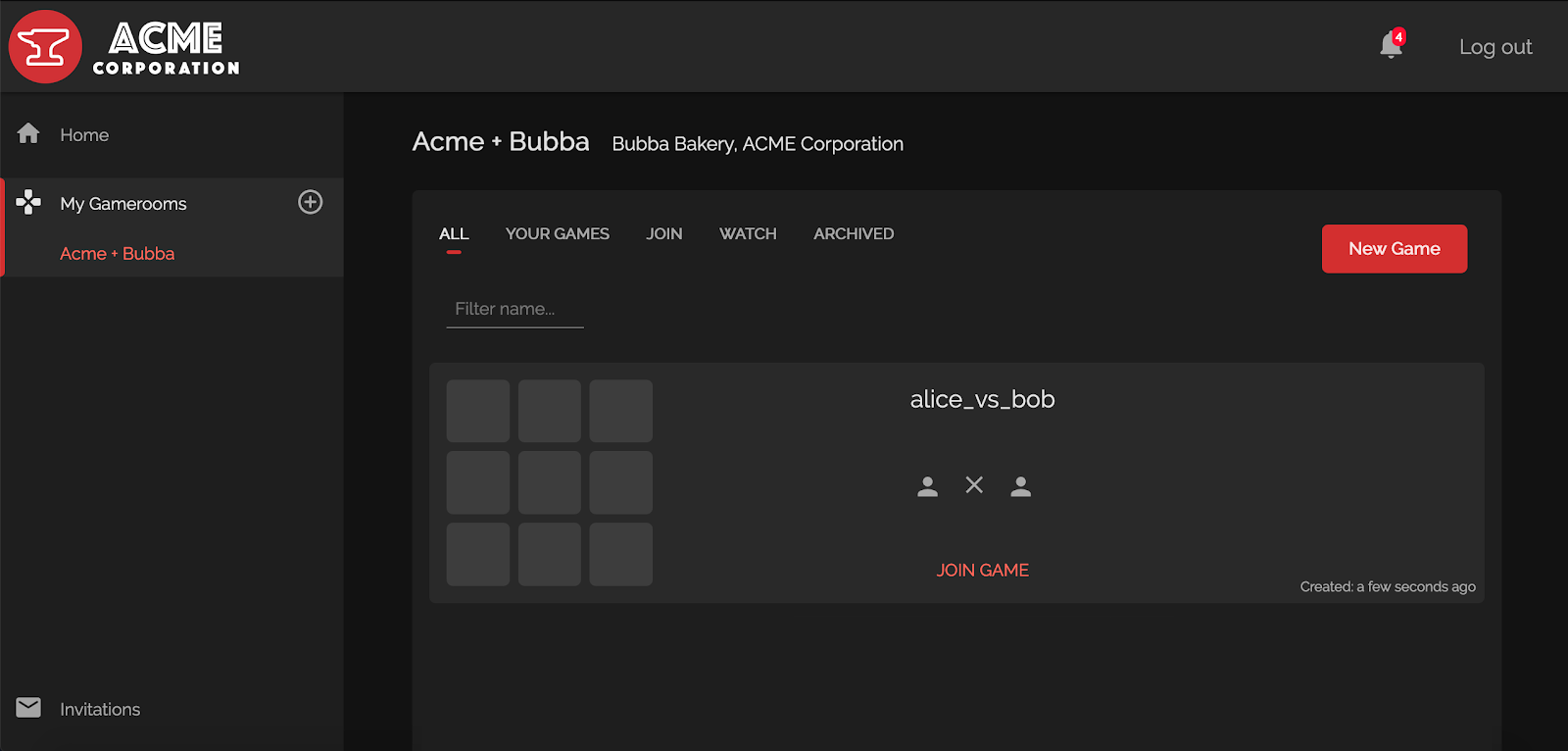
Scene 2: Alice makes the first move
Alice clicks JOIN GAME on the newly created game. The alice_vs_bob
game board appears.
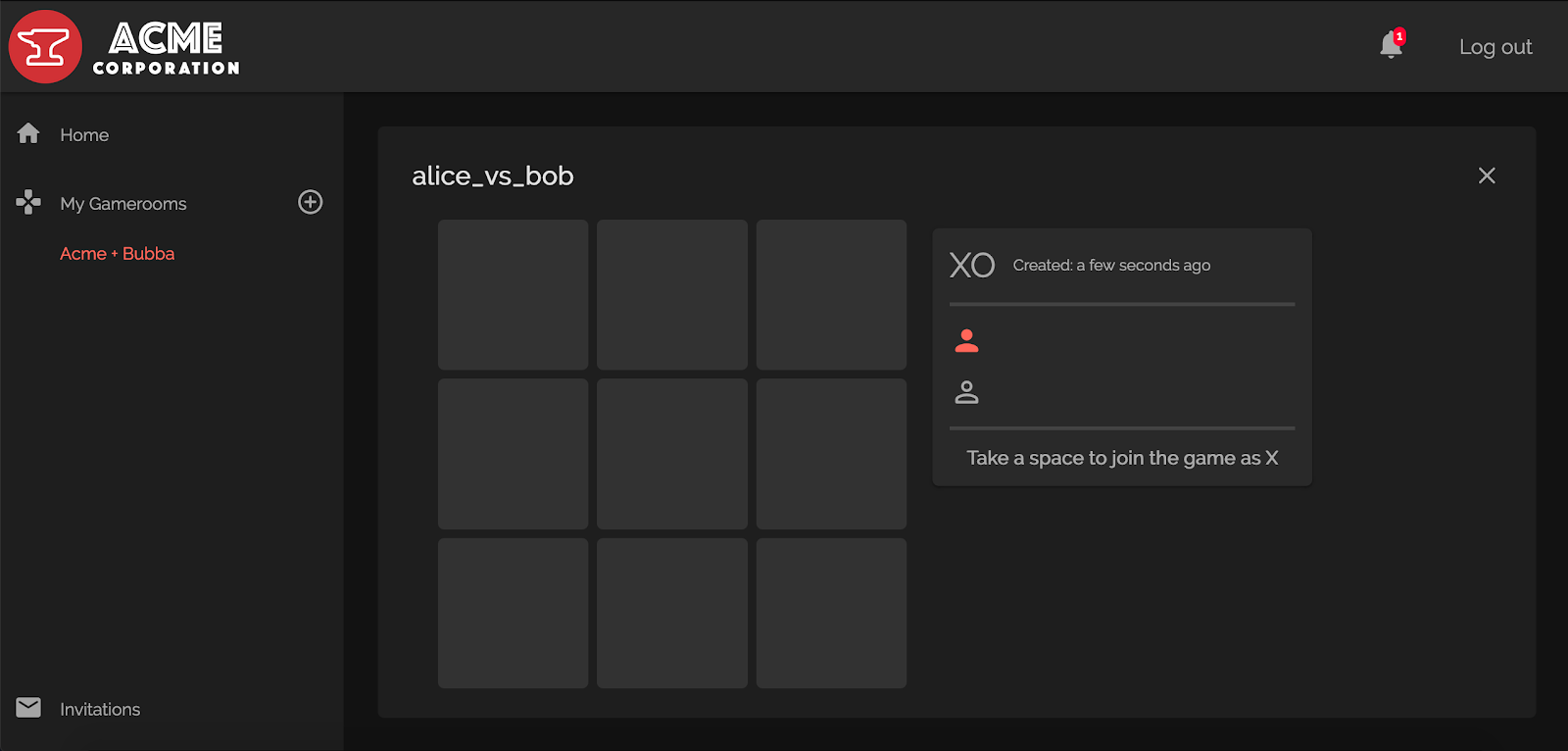
Alice stretches her hands and rubs her neck, preparing for her first move.
She clicks the center spot on the board.
While the Gameroom application processes her move, Alice sees a spinner in the center spot.
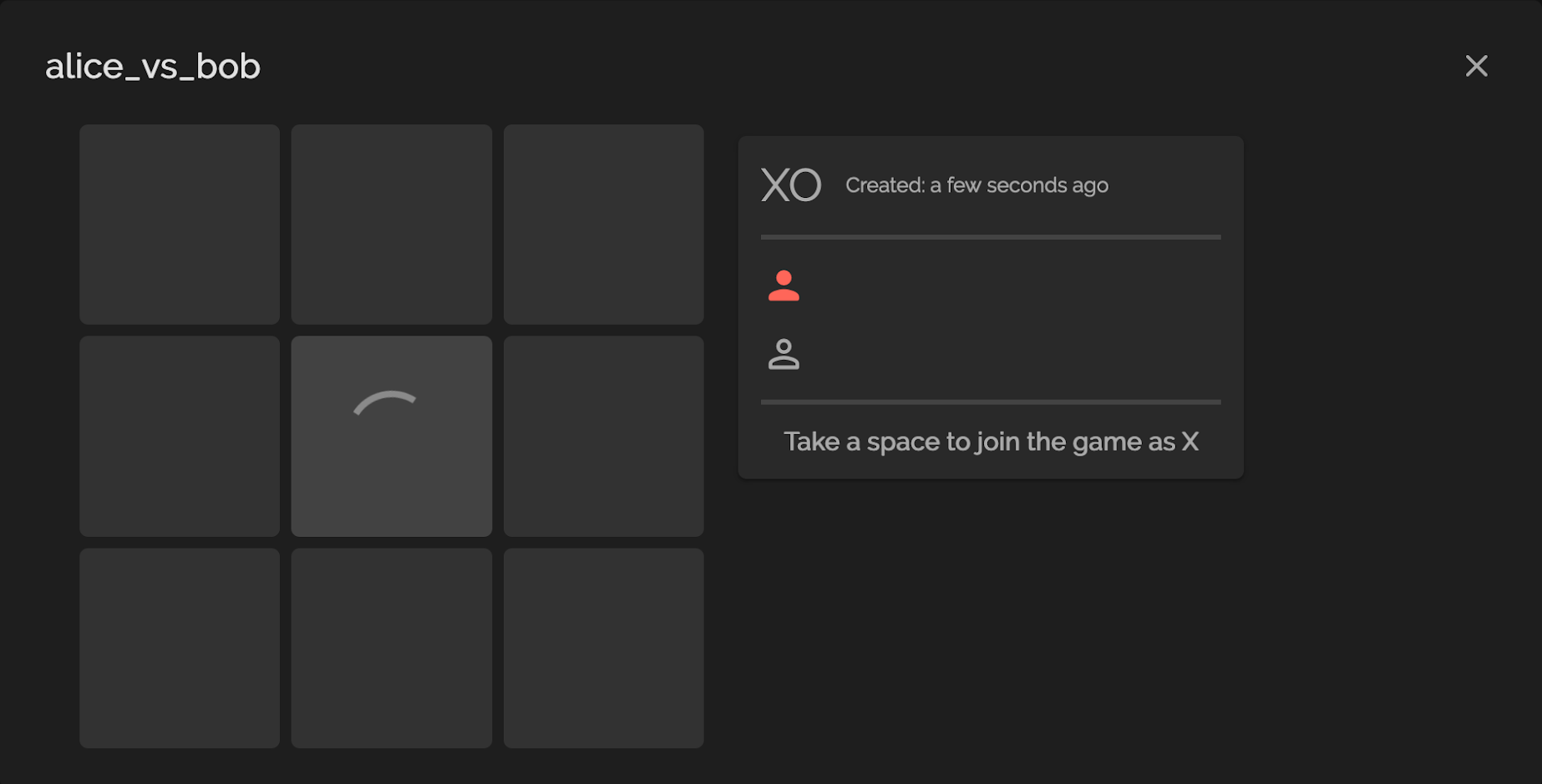
Time passes. The spinner disappears and an X appears in its place. Alice’s
first move has been accepted.
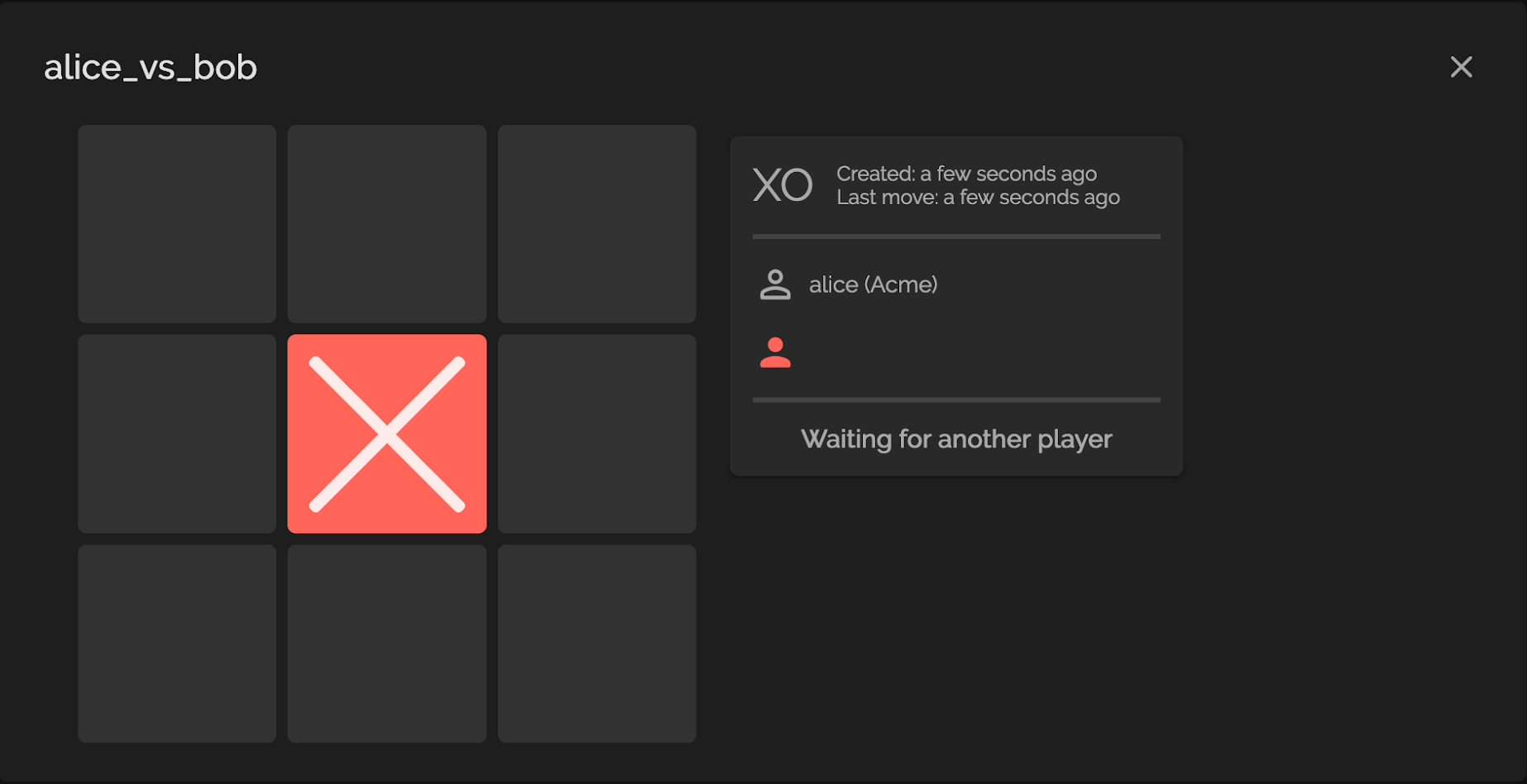
Now she must wait for Bob’s first move.
Scene 3: Bob takes a turn
Eventually, Bob sees a RED NUMBER 1 on his bell icon, which means that he has a notification.

Bob clicks on the bell icon. He sees that the game alice_vs_bob is available
in the Acme + Bubba gameroom.
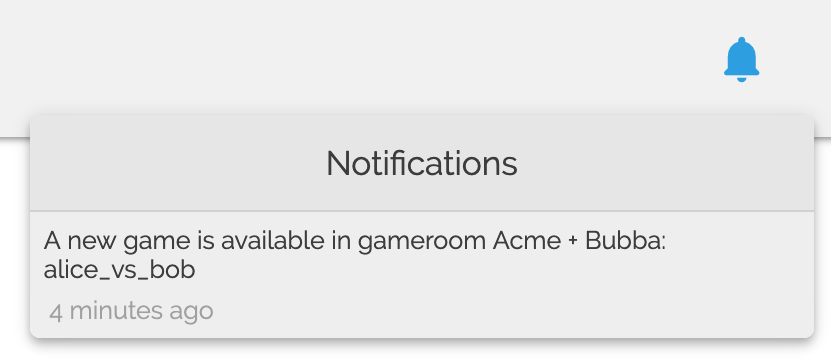
He clicks on the notification text. The alice_vs_bob game board is displayed.
Bob sees that Alice has taken the center space.
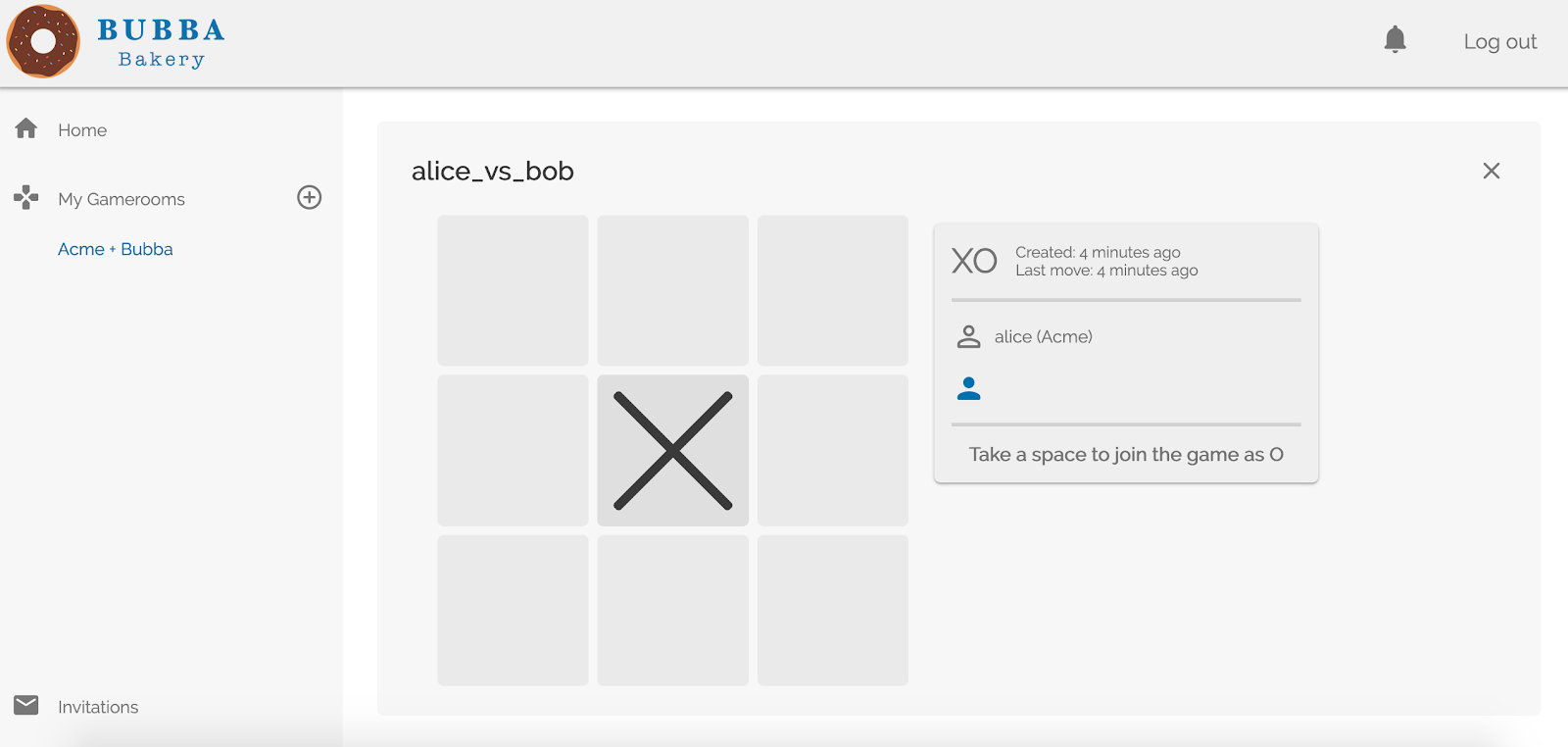
Muttering to himself, Bob makes his first move: he takes the top right corner.
While the Gameroom application processes his move, Bob sees a spinner in that space.
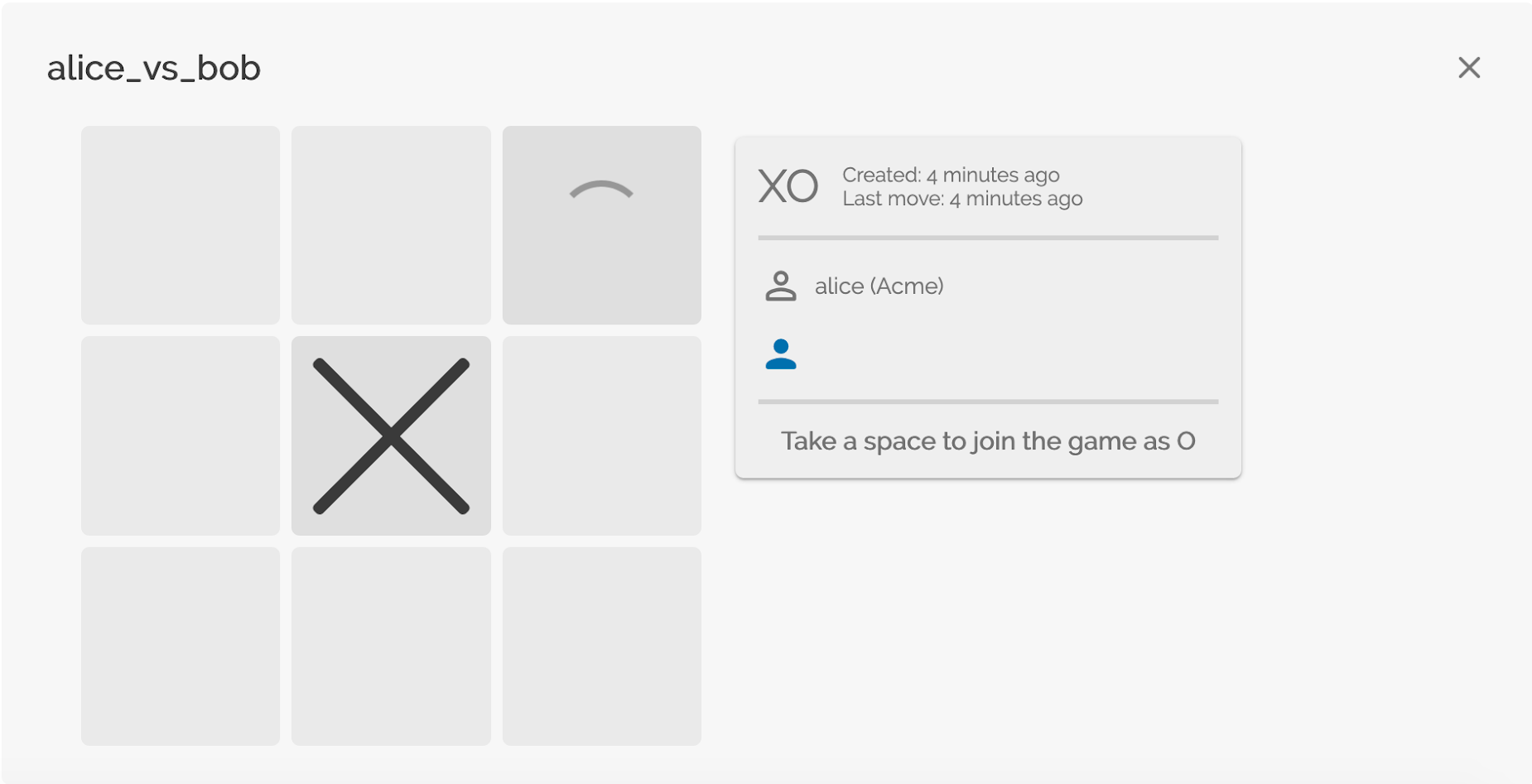
Soon, the spinner disappears. Bob’s first move has been accepted.
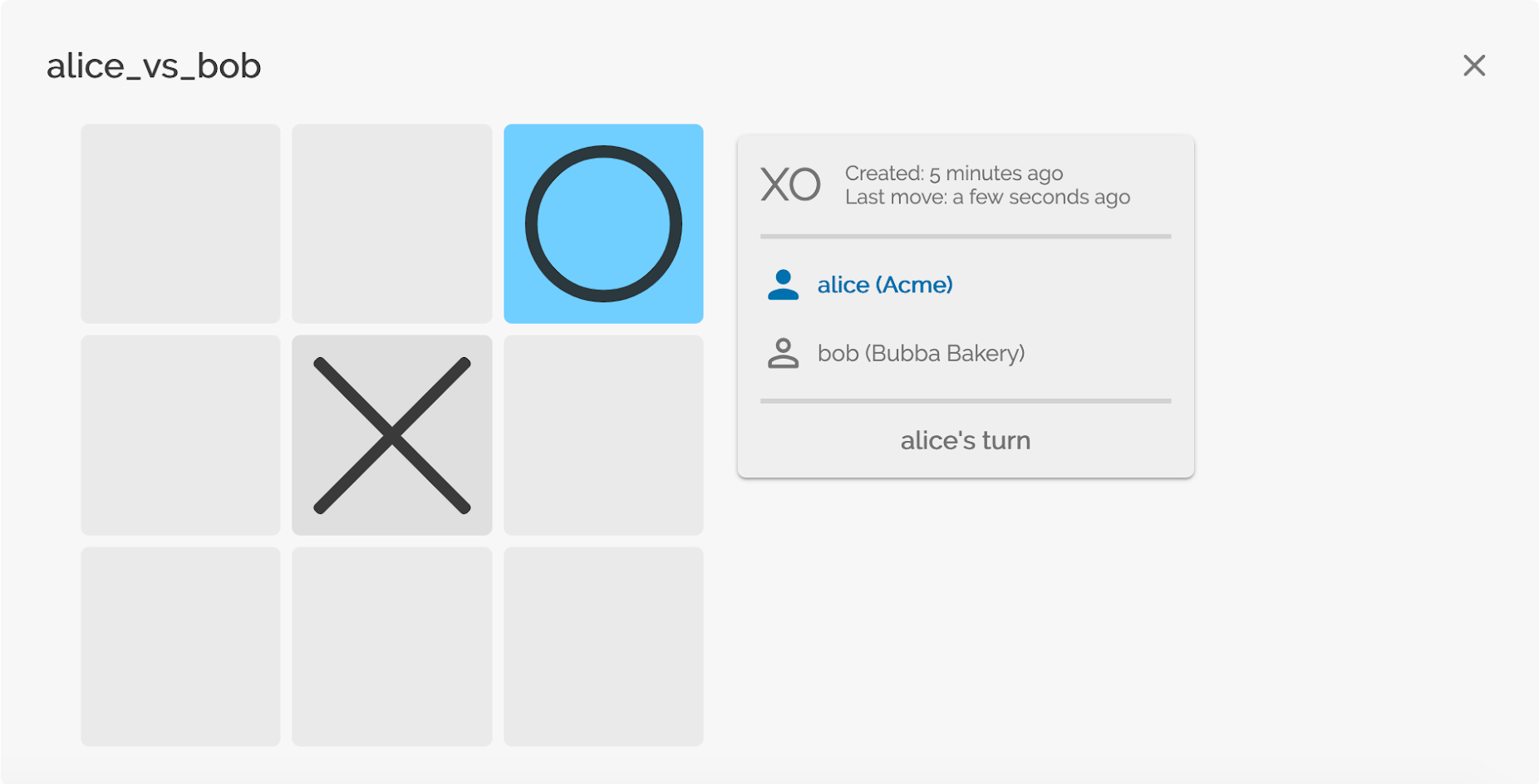
The game continues, slowly, as Alice and Bob carefully analyze each move.
Scene 4: Alice wins the game
It’s the last move of the game.
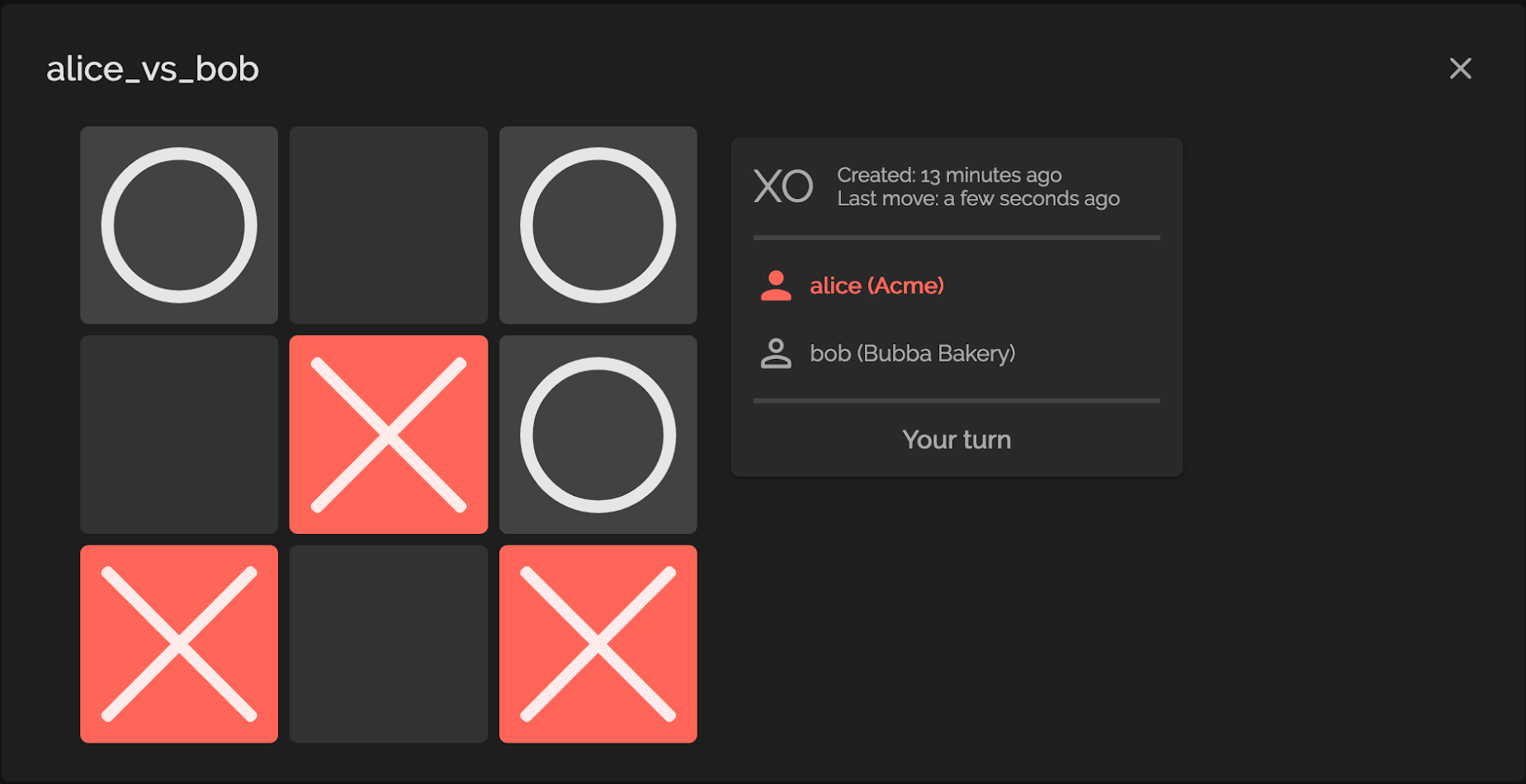
Alice is biting her nails. Bob wipes his forehead.
Alice clicks on the winning spot. Suspense builds while she watches the spinner.
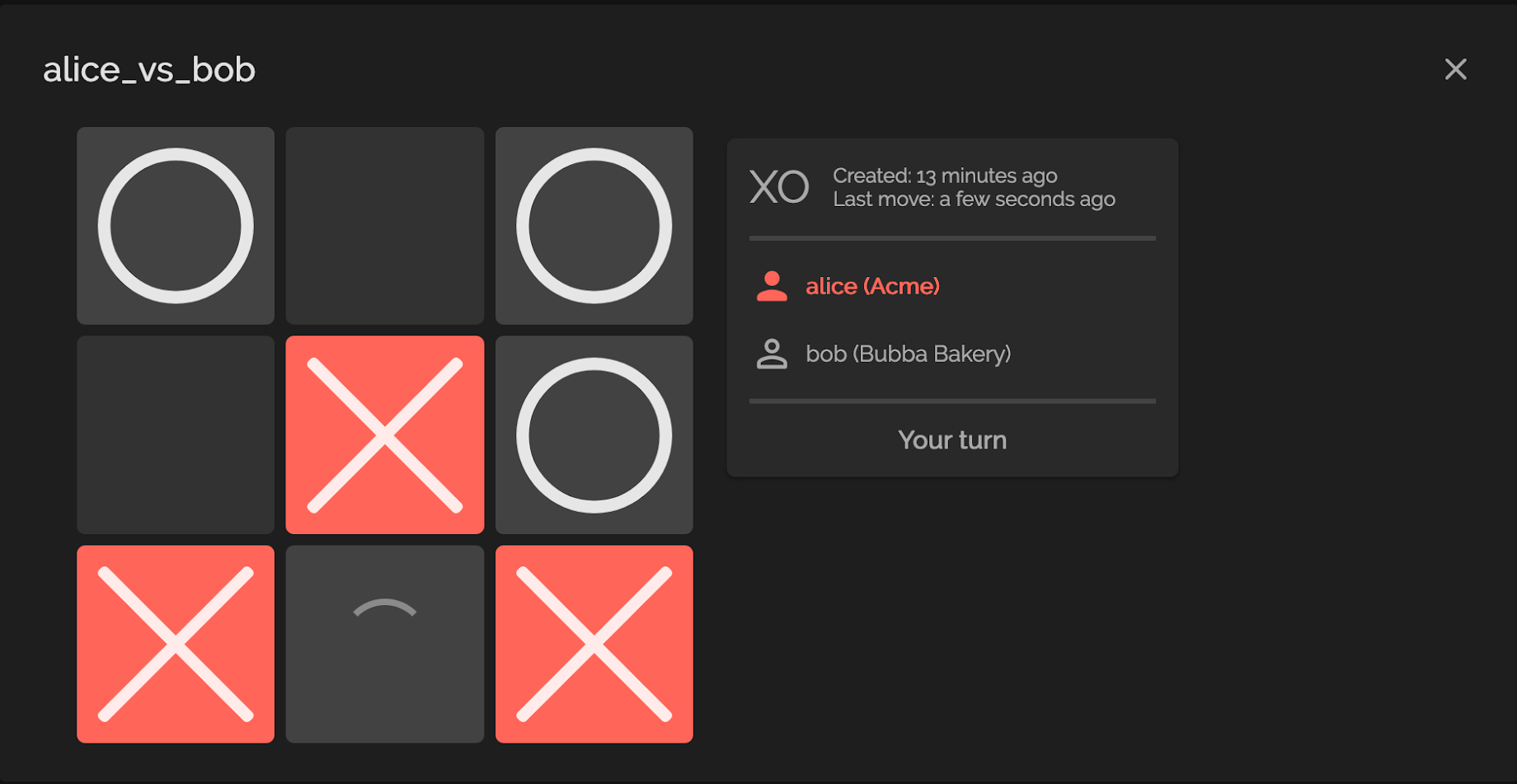
The spinner disappears. Alice wins the game!
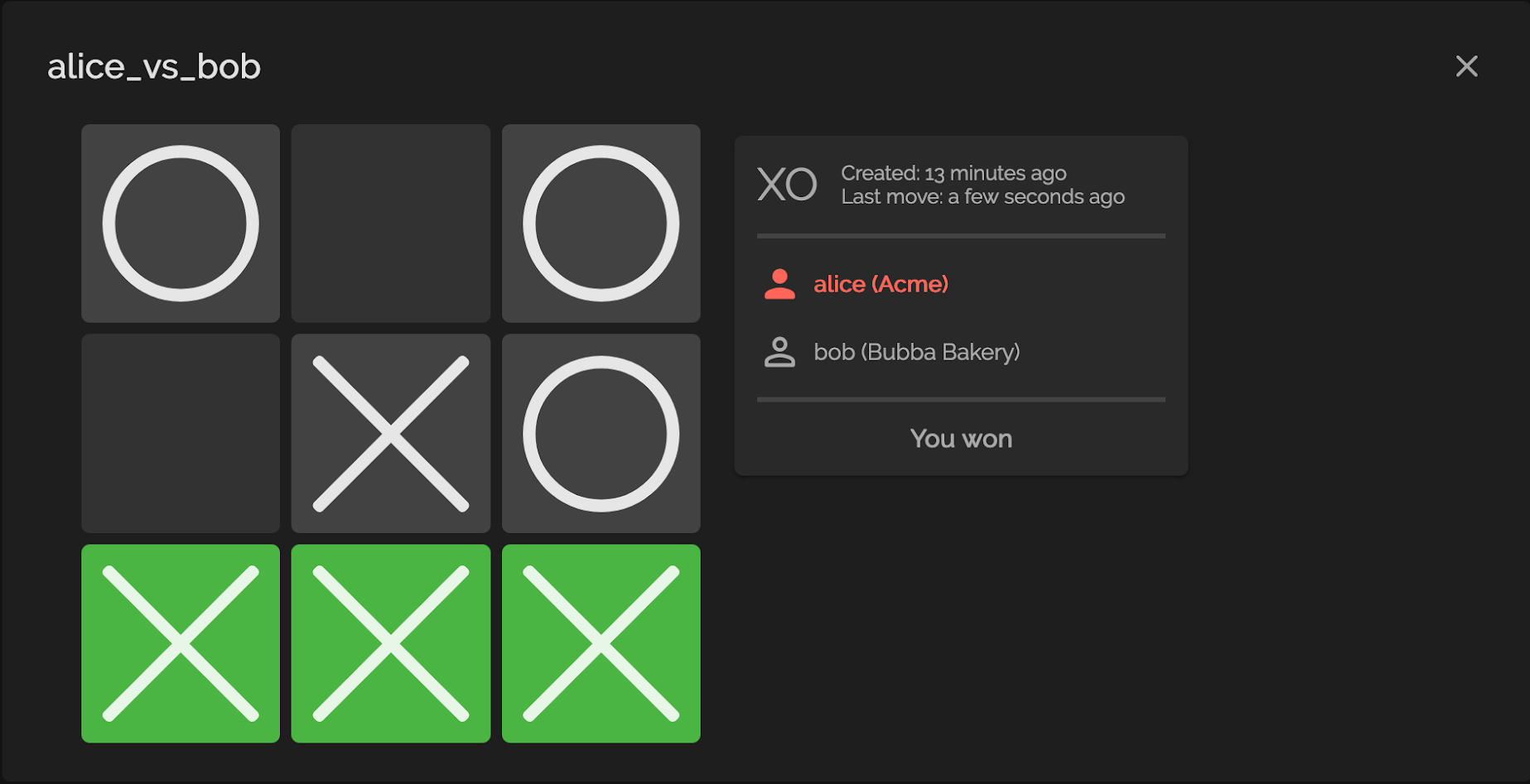
Bob sees Alice’s winning move as a row of red Xs.
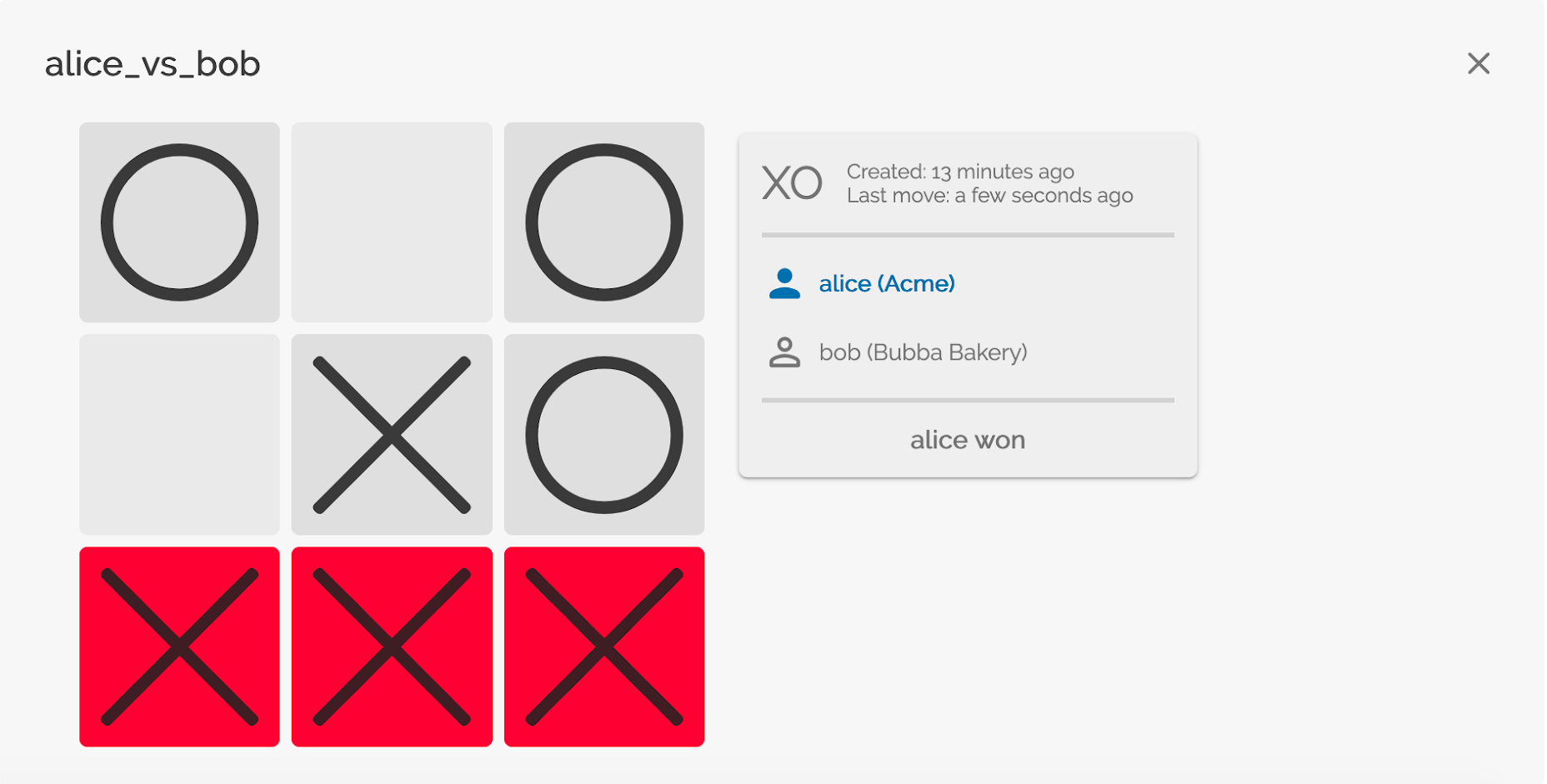
Scene 5: The triumph of Alice
In Alice’s office, we hear CHEERS IN THE BACKGROUND.
Alice turns around and sees a crowd of co-workers who are celebrating her win.
Scene 6: The tragedy of Bob
In Bob’s office, there’s a loud crash, then a scream. CUT TO BLACK.
Behind the Scenes: A Look at Act II, Alice and Bob Play XO
This section describes what really happens during Act II. Although the actions of creating a game and making moves are different, the underlying functions are similar to the process of creating a gameroom.
II-1. Behind scene 1: Alice creates a new XO game
In Scene 1, Alice uses the Gameroom UI to create a new game named
alice_vs_bob in the Acme + Bubba gameroom. This section explains how the
new game request is handled.
II-1.1. Acme client sends ‘create game’ request to Gameroom REST API
-
When Alice clicks
Createin the New Game screen, the Acme client creates an XO transaction request payload for the creation request. (See Appendix D.2 for information about the XO transaction request format.)alice_vs_bob,create, -
The Acme client wraps this transaction request payload in a
sabre_payloadmessage.--- sabre_payload: action: "EXECUTE_CONTRACT" execute_contract: name: xo version: 0.3.3 inputs: - 5b7349 - 00ec00 - 00ec01 - 00ec02 outputs: - 5b7349 payload: b"alice_vs_bob,create," -
The Acme client bundles the Sabre payload into a batch, then serializes the batch into an array of bytes. (For more information, see “Transactions and Batches” in the Sawtooth Architecture documentation.)
-
The Acme client sends the batch to the Acme Gameroom REST API.
POST /gamerooms/<circuid_id>/batches Content-Type: application/octet-stream <bytes of the batch containing the Sabre XO transaction> -
After the transaction is sent, the Acme Gameroom UI displays a spinner and the message “Creating Game”, which shows that the game is in a pending state.

This state continues until the UI is notified that the new game has been committed to state (described in section II-1.6).
II-1.2. Acme Gameroom REST API sends ‘create’ transaction to Acme scabbard service
The Acme gameroom daemon passes the serialized batch (which contains the XO transaction) to the Acme scabbard service, using the scabbard service’s existing REST API route (as described in section Ⅰ-6.6, step 4).
POST /scabbard/<circuit_id>/<service_id>/batches
<serialized batch>
II-1.3. Scabbard services use consensus to commit the new game
When the Acme scabbard service receives this batch, it commits the batch using a similar process as adding the XO smart contract (described in section Ⅰ-6.6, step 5).
-
The first steps are the same: The Acme scabbard service deserializes the batch, then shares the batch with the Bubba Bakery scabbard service so that both nodes can use consensus to agree to commit the new game.
-
Next, the scabbard services use the Sabre transaction handler to use the XO smart contract to execute the transactions in the batch.
-
The remaining steps are the same as before: After the nodes agree on state using two-phase commit consensus, both scabbard services commit the new XO game to scabbard state in their local database.
II-1.4. Scabbard services use consensus to commit the new game
After the new XO game has been committed to scabbard state, both scabbard services send the new XO game state to their gameroom daemon via a WebSocket connection.
An XO game state is defined as a string of comma-separated values:
“<game-name>,<board-state>,<game-state>,<player1-key>,<player2-key>”
The message to the gameroom daemon looks like this:
{
“eventType”: “Set”,
“message”: {
“key”: “<xo game address>”,
“value”: b“alice_vs_bob,---------,P1-NEXT,,”
}
}
Note that the values for <player1-key> and <player2-key> are empty. These
fields are not set until a player makes the first move. (This is a design
choice for the XO smart contract; it’s not an inherent limitation of Splinter
or the Gameroom application.)
II-1.5. Gameroom daemons update gameroom status in database
When a Gameroom daemon receives the message from its scabbard service, the daemon stores the state change in its local database.
-
Because this is a new game, the Gameroom daemon creates a new entry in the
xo_gamestable in the database.The
xo_gamestable has this definition:xo_games ( id BIGSERIAL PRIMARY KEY, circuit_id TEXT NOT NULL, game_name TEXT NOT NULL, player_1 TEXT NOT NULL, player_2 TEXT NOT NULL, game_status TEXT NOT NULL, game_board TEXT NOT NULL, created_time TIMESTAMP NOT NULL, updated_time TIMESTAMP NOT NULL, FOREIGN KEY (circuit_id) REFERENCES gameroom(circuit_id) ON DELETE CASCADE );At the end of this operation, the
xo_gamestable has the following entry:id circuit_id game_name player_1 player_2 <auto generated id> 01234-ABCDE alice_vs_bob game_status game_board created_time updated_time P1-NEXT --------- <time entry was created> <time entry was updated> -
The gameroom daemon also adds a new notification to the
gameroom_notificationtable, which indicates that a new game was created.id notification_type requester requester_node_id <auto generated id> new_game_created:alice_vs_bob <Alice's public key> acme-node-000 target created_time read 01234-ABCDE <time entry was created> f
II-1.6. Gameroom REST APIs tell clients that XO game is committed
-
After the Acme and Bubba Bakery Gameroom daemons fill in the
gameroom_notificationtables, the Gameroom REST API uses a WebSocket connection to tell each UI about the new notification.{ "namespace": "notifications", "action": "listNotifications" } -
When the UI receives that message, it sends a request to the Gameroom REST API to fetch a list of unread notifications from the database tables.
GET /notifications -
The Gameroom REST API responds with the list of unread notifications.
{ "data": [ { "id": <auto generated id>, "notification_type": "new_game_created:alice_vs_bob", "requester": <Alice’s public key>, “node_id”: “acme-node-000”, "target": "gameroom::acme-node-000::bubba-node-000::<UUIDv4>", "timestamp": <time entry was created>, "read": false } ], "paging": { "current": "api/notifications?limit=100&offset=0", "offset": 0, "limit": 100, "total": 1, "first": "api/notifications?limit=100&offset=0", "prev": "api/notifications?limit=100&offset=0", "next": "api/notifications?limit=100&offset=0", "last": "api/notifications?limit=100&offset=0" } } -
Once the UI receives this notification, it asks the Gameroom REST API to fetch the list of games in the
Acme + Bubbagameroom.GET /xo/01234-ABCDE/games -
The Gameroom REST API responds with a list of games that includes the status of each game. At this point, only the new
alice_vs_bobgame exists; no moves have been made.{ "data": [ { "circuit_id": "01234-ABCDE", "game_name": "alice_vs_bob", "player_1": "", "player_2": "", "game_status": "P1-NEXT", "game_board": "---------", "created_time": <time entry was created>, "updated_time": <time entry was created> } ], "paging": { "current": "api/xo/01234-ABCDE/games?limit=100&offset=0", "offset": 0, "limit": 100, "total": 0, "first": "api/xo/01234-ABCDE/games?limit=100&offset=0", "prev": "api/xo/01234-ABCDE/games?limit=100&offset=0", "next": "api/xo/01234-ABCDE/games?limit=100&offset=0", "last": "api/xo/01234-ABCDE/games?limit=100&offset=0" } } -
The Acme Gameroom UI checks that the
alice_vs_bobgame is present in the list of games received from the REST API. Because the game is in the list, the UI can now show the game in a “committed” state (ready to play because the “create game” transaction has been committed). -
The Acme Gameroom UI replaces the spinner with a blank game board.

Alice can now click on the game board to start playing XO.
II-2. Behind scene 2: Alice makes the first move
Each game move is handled the same way as the “create game” process described in section II-1. This section summarizes these steps.
-
The Acme client submits the “take a space” transaction.
a. When Alice clicks the middle square in the XO board, the Acme client creates an XO transaction request payload for taking the 5th space. See Appendix D.2 for information on XO game moves and the game board.
``` alice_vs_bob,take,5, ```b. As with game creation, the Acme client wraps this transaction request payload in a
sabre_payloadmessage (see section II-1.1, step 2 for the message details).c. The Acme client bundles the Sabre payload into a batch, then serializes the batch into an array of bytes. (For more information, see “Transactions and Batches” in the Sawtooth Architecture documentation.)
d. The Acme client posts the batch to the Acme Gameroom REST API (see the details in section II-1.1, step 4).
e. After the transaction is sent, the Acme Gameroom UI displays a spinner in the center square until it is notified that the game has been updated in state.

-
The Acme Gameroom REST API forwards the XO
taketransaction to the scabbard service (see the details in section II-1.2). -
The Acme and Bubba Bakery scabbard services use consensus (defined in Appendix B) to commit the move (as described in section II-1.3).
-
After Alice’s first move has been committed to scabbard state, the scabbard services send the new state to their gameroom daemons via a WebSocket connection (as described in section II-1.4).
This message includes an updated game board that has Alice’s
Xin the center square of the game board and Alice’s public key in theplayer1field.{ “eventType”: “Set”, “message”: { “key”: “<xo game address>”, “value”: b“alice_vs_bob,----x----,P2-NEXT,<Alice’s public key>,” } }Note that the last field (the key for
player2) is empty. That field will be set when Bob makes his first move. -
When each Gameroom daemon receives the message, it updates the
alice_vs_bobentry in thexo_gamestable in the database (this entry was created in section II-1.5).At the end of the operation, the
xo_gamestable looks like this:id circuit_id game_name player_1 player_2 <auto generated id> 01234-ABCDE alice_vs_bob <Alice's public key> game_status game_board created_time updated_time P2-NEXT ----X---- <time entry was created> <time entry was updated> The gameroom daemon also adds a new notification to the
gameroom_notificationtable to indicate that the game was updated.id notification_type requester requester_node_id <auto generated id> game_updated:alice_vs_bob <Alice's public key> acme-node-000 target created_time read 01234-ABCDE <time entry was created> f -
The Gameroom REST APIs tell the clients that Alice’s move has been committed and the XO game state has been updated. This process is the same as in section II-1.6, but the notification details contain information about Alice’s move.
a. After the Acme Gameroom daemon handler fills in the
gameroom_notificationtable, the Acme Gameroom REST API uses a WebSocket connection to tell the Acme UI about the new notification (see the details in section II-1.6, step 1).b. When the Acme UI receives that message, it asks the Gameroom REST API to fetch a list of unread notifications from the database tables (using the same
GET /notificationsrequest as in section II-1.6, step 2).c. The Acme Gameroom REST API responds with the list of unread notifications, as described in section II-1.6, step 3. At this point, however, the notification type is
game_updated.{ "data": [ { "id": <auto generated id>, "notification_type": "game_updated:alice_vs_bob", "requester": <Alice’s public key>, “node_id”: “acme-node-000”, "target": "01234-ABCDE", "timestamp": <time entry was created>, "read": false } ], "paging": { … [SNIP] … } }d. Once the UI receives this notification, it sends a request to the Acme Gameroom REST API to fetch the list of games in the
Acme + Bubbagameroom (using the same GET request as in section Ⅰ-6.6, step 4).e. The Acme Gameroom REST API returns the list of games and game data. At this point, the alice_vs_bob game data shows that Alice is
player_1,player_2must move next, and Alice’sXis in the center square of the game board.{ "data": [ { "circuit_id": "01234-ABCDE", "game_name": "alice_vs_bob", "player_1": "<Alice’s public key>", "player_2": "", "game_status": "P2-NEXT", "game_board": "----x----", "created_time": <time entry was created>, "updated_time": <time entry was updated> } ], "paging": { … [SNIP] … } }f. The Acme Gameroom UI now shows that Alice’s move has been committed by replacing the spinner in the center square with a red X.
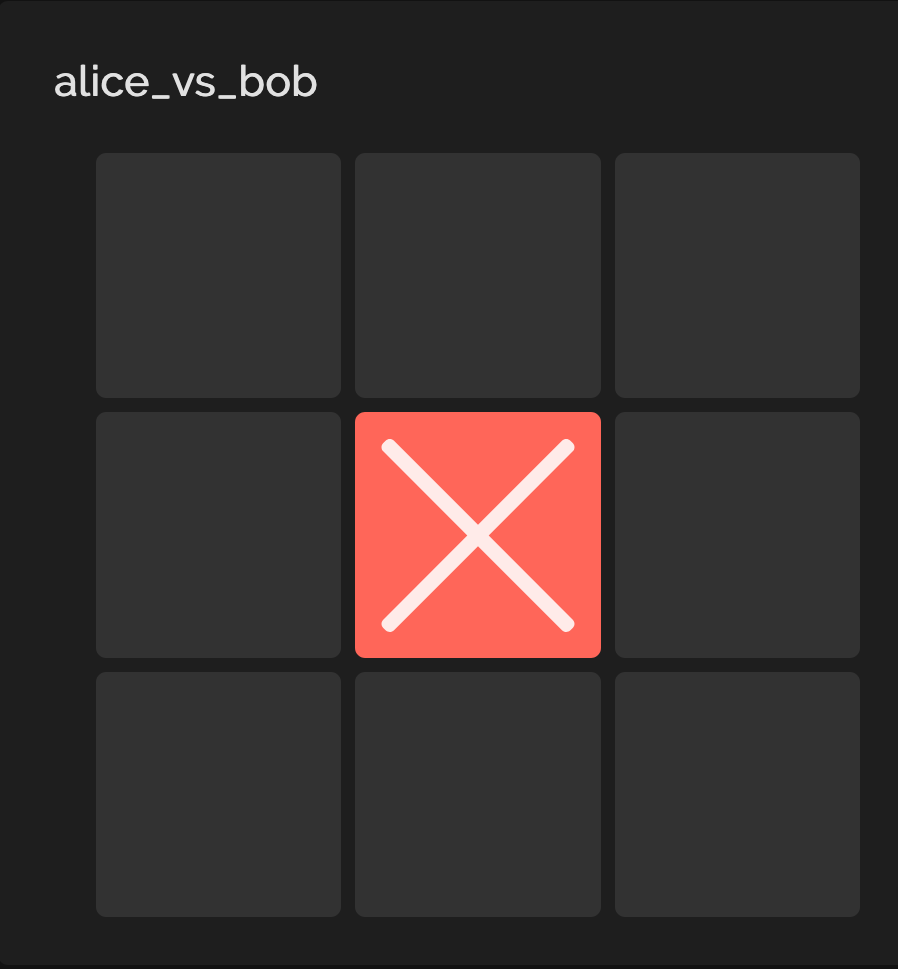
II-3. Behind scene 3: Bob takes a turn
In Act II, Scene 3, Bob notices his “new game” notification, clicks on it, and is redirected to the game page. The notification process is the same as in Act Ⅰ, section Ⅰ-3, when Bob saw Alice’s invitation for the new gameroom. When Bob joins the game, the process is similar to Alice’s first move in Act II, section II-2. This section summarizes the process and highlights the differences.
-
The Bubba Bakery client gets a notification of a new game in the Acme + Bubba gameroom (see the details in section I-3.6)
-
Bob checks his notifications as described in section Ⅰ-4.
-
When Bob clicks on his “alice_vs_bob” game notification, he joins the XO game with Alice.
a. The Bubba Bakery UI makes a call to the Gameroom REST API for the list of existing games in the Acme + Bubba gameroom.
GET /xo/<circuitID>/gamesb. The Bubba Bakery Gameroom REST API responds with a list of games. The game data shows the status after Alice’s first move, as described in section II-2, step 6e.
{ "data": [ { "circuit_id": "01234-ABCDE", "game_name": "alice_vs_bob", "player_1": "<Alice’s public key>", "player_2": "", "game_status": "P2-NEXT", "game_board": "----x----", "created_time": <time entry was created>, "updated_time": <time entry was updated> } ], "paging": { … [SNIP] … } }c. The Bubba Bakery UI then displays the game board and related information for the
alice_vs_bobgame. Bob sees Alice’sXin the center square.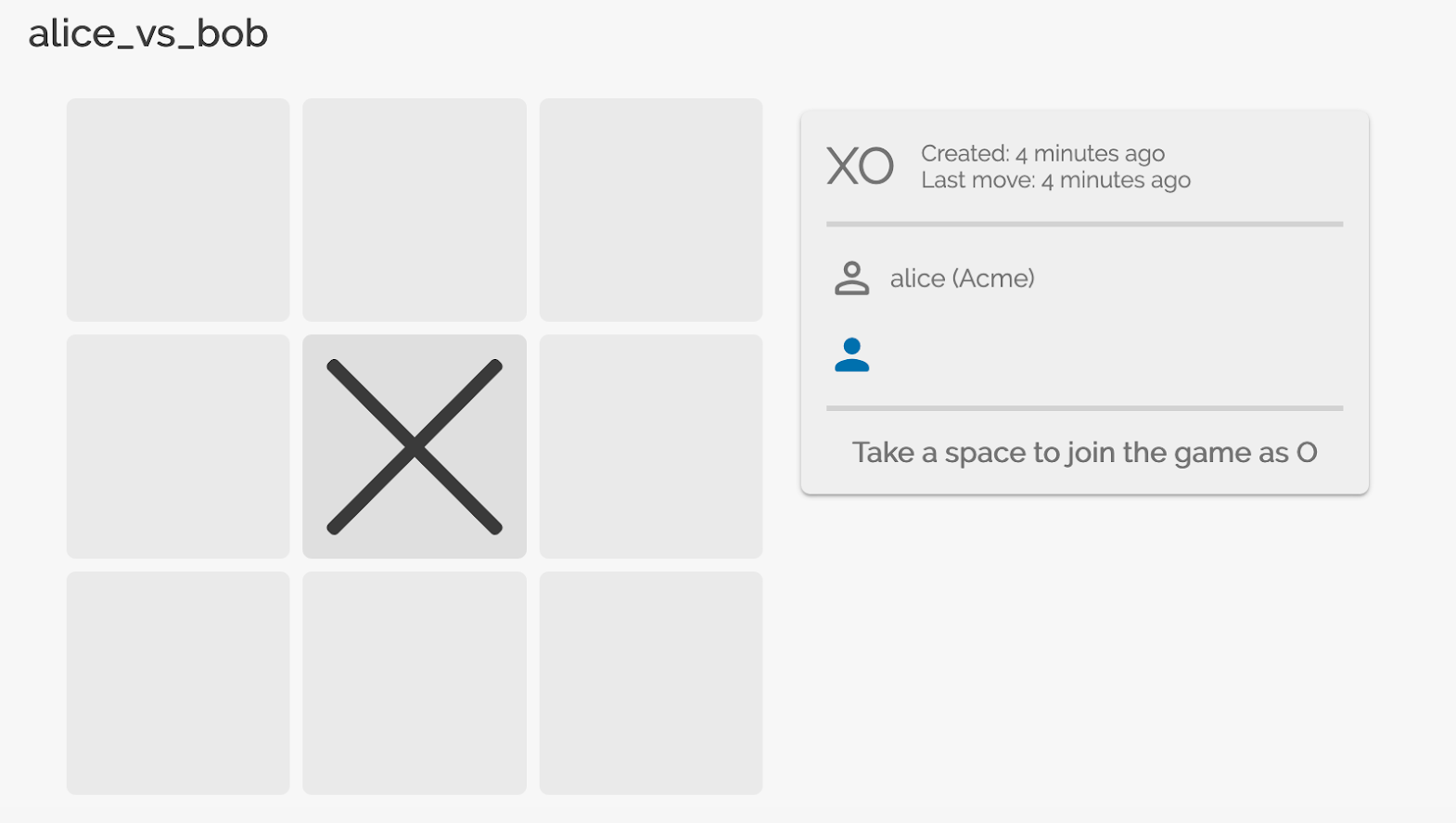
-
When Bob clicks the top right square on the XO board, the Bubba Bakery client starts the process of handling his “take a square” request.
a. The Bubba Bakery client creates an XO transaction request payload for taking the 3rd square.
alice_vs_bob,take,3b. The Bubba Bakery client wraps this transaction request payload in a
sabre_payloadmessage (as described in section section II-1.1, step 2), bundles the Sabre payload into a batch and serializes it (see section II-1.1, step 3), then posts it to the Bubba Bakery Gameroom REST API (see section II-1.1, step 4).After the transaction is sent, the Bubba Gameroom UI displays a spinner until it is notified that the game has been updated in state. {:height="35%" width="35%"} -
The Bubba Bakery REST API forwards the XO ‘take’ transaction to the scabbard service (see the details in section II-1.2).
-
The Bubba Bakery and Acme scabbard services use consensus (defined in Appendix B) to commit the move, as described in section II-1.3. For Bob’s move, Bubba Bakery’s scabbard service starts the process.
-
After Bob’s move has been committed to scabbard state, the scabbard services send the new state to the gameroom daemon via a WebSocket connection (as described in section II-1.4).
This message includes an updated game board that has Bob’s
Oin the top right square (3rd space) of the game board and Bob’s public key in theplayer_2field.{ “eventType”: “Set”, “message”: { “key”: “<xo game address>”, “value”: b“alice_vs_bob,--o-x----,P2-NEXT,<Alice’s public key>,<Bob’s public key>” } } -
When each Gameroom daemon receives the message, it updates the
alice_vs_bobentry in thexo_gamestable in the database (this entry was created in section II-1.5).At the end of the operation, the
xo_gamestable looks like this:id circuit_id game_name player_1 player_2 <auto generated id> 01234-ABCDE alice_vs_bob <Alice's public key> <Bob's public key> game_status game_board created_time updated_time P1-NEXT --O-X---- <time entry was created> <time entry was updated> As with Alice’s first move, the gameroom daemon also adds a “game updated” notification to the
gameroom_notificationtable (see section II-2, step 5). -
The Gameroom REST APIs notify the Gameroom daemons that the XO game’s state has been updated. This process is the same as for Alice’s first move (see section II-2, step 6), but the notification details contain information about Bob’s move.
When the Gameroom REST APIs return the list of games and game data, the
alice_vs_bobgame data shows that Bob isplayer_2, Alice has the next move, and each player has made one move on the game board.{ "data": [ { "circuit_id": "01234-ABCDE", "game_name": "alice_vs_bob", "player_1": "<Alice’s public key>", "player_2": "<Bob’s public key>", "game_status": "P1-NEXT", "game_board": "--o-x----", "created_time": <time entry was created>, "updated_time": <time entry was updated> } ], "paging": { … [SNIP] … } } -
The Bubba Bakery UI now shows that Bob’s move has been committed by replacing the spinner in the upper right corner with a blue
O.
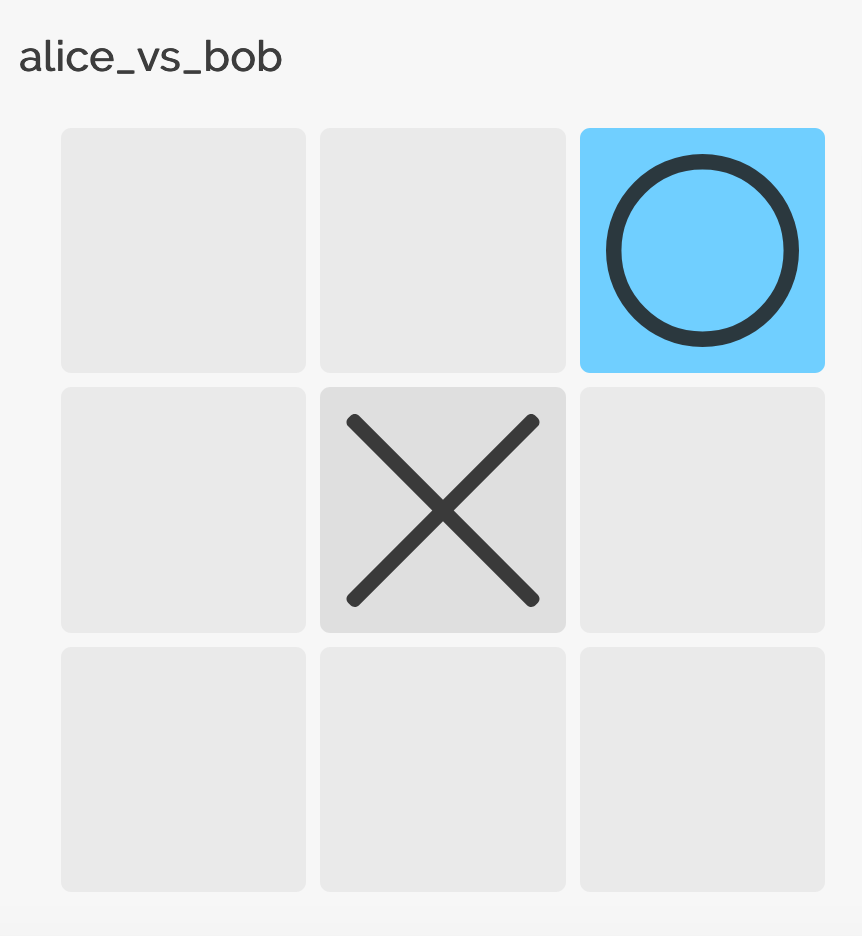
II-4. Behind Scene 4: Alice wins the game
After each move in the XO game, the XO smart contract checks the current game state to determine if the move resulted in a win or a tie. If not, the game state is updated to show which player moves next. (See Appendix D for the XO execution rules and game state values.)
-
Before Alice’s last move, the
xo_gamestable in the database looks like this:id circuit_id game_name player_1 player_2 <auto generated id> 01234-ABCDE alice_vs_bob <Alice's public key> <Bob's public key> game_status game_board created_time updated_time P1-NEXT O-O-XOX-X <time entry was created> <time entry was updated> After Alice clicks the winning spot, the move is approved and committed to state, and the Gameroom daemons update the game state. Now, the
xo_gamestable in the database looks like this:id circuit_id game_name player_1 player_2 <auto generated id> 01234-ABCDE alice_vs_bob <Alice's public key> <Bob's public key> game_status game_board created_time updated_time P1-WIN O-O-XOXXX <time entry was created> <time entry was updated> The
P1-WINgame status means that neither player can make any more moves. -
Each Gameroom daemon receives the notification of the game state change, as described for Alice’s first move (see section II-2) and Bob’s first turn (see section II-3).
-
Each Gameroom daemon notifies the Gameroom UI to update the game board with Alice’s winning move on the game board, as described in those earlier sections.
The Acme UI shows a green row to indicate that Alice has won. The Bubba Bakery UI shows the row in red to let Bob know that he has lost.
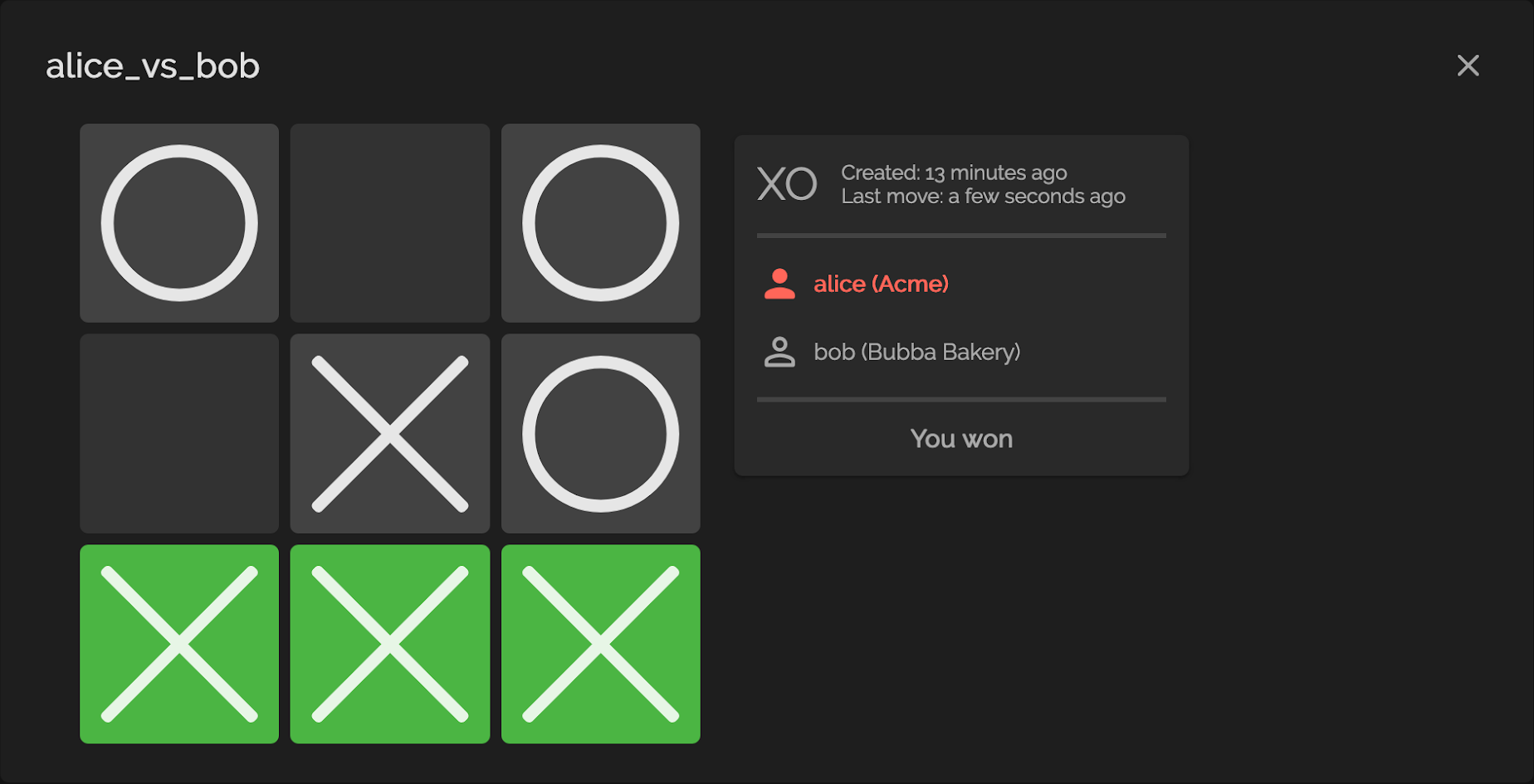
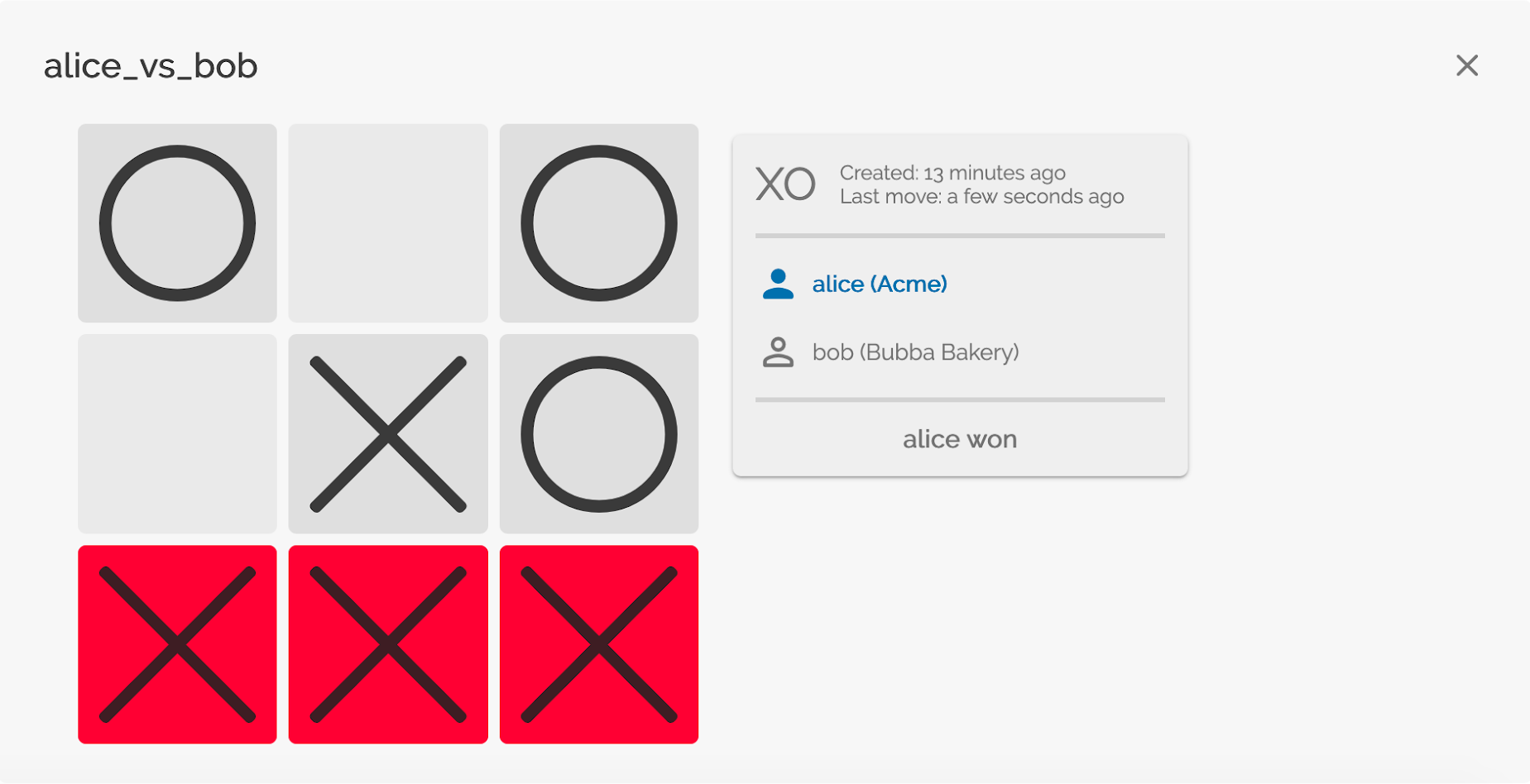
Act III: Alice creates gamerooms with Yoda and Zixi
Scene 1: The ketchup packet
[The scene starts at the cliffhanger ending of ACT II.]
NARRATOR (voice-over)
Bob is furious that he lost the XO game to Alice. He stands up -- jumps up, really -- and puts his foot on a KETCHUP PACKET on the floor. He stumbles into a MOBILE WHITEBOARD, grabbing the whiteboard as he falls and pulling it on top of himself. The whiteboard breaks his nose and his computer.
Bob screams in pain.
Scene 2: Alice and Yoda set up a gameroom
NARRATOR (voice-over)
Alice doesn't want to stop playing tic tac toe. She asks her friend Yoda, the VP of Yoyodyne Systems, to set up the Gameroom application at his company. They start a competitive series of XO games in the "Alice vs Yoda" gameroom, playing from early morning until when Yoda leaves work.
IMAGE: Alice, hunched over her computer at sunset. CUT TO BLACK.
Scene 3: Alice sets up a gameroom with Zixi
NARRATOR (voice-over)
Alice decides that she needs more gamerooms. She arranges for Zixi, who works at Zymogen Industries, to install the Gameroom application and join the "Alice vs Zixi" gameroom. They play XO from dinner time until midnight. Zixi has no idea that Alice has multiple gamerooms. She can only sees the "Alice vs Zixi" gameroom in her view of the Gameroom application.
FADE OUT: Alice, hunched over her computer in a dark office.
Scene 4: Alice’s addiction
FADE IN: Alice, hunched over her computer at dawn.
NARRATOR (voice-over)
Alice can't stop playing XO. She sets up gamerooms with people all over the globe. She lives in her office. She starts stealing other people's lunches from the office refrigerator. She drinks vending machine coffee at all hours. She doesn't sleep.
Finally, her co-workers stage an intervention. Alice goes to an addiction rehab center for a month.
When Alice returns to work, she never plays online games. She also has an uncontrollable twitch when she sees an X.
CUT TO BLACK.
Behind the Scenes: A Look at Act III, Alice creates Gamerooms with Yoda and Zixi
At the end of Act III, Alice has three gamerooms. Her gamerooms with Yoda and Zixi are created the same way as the first gameroom with Bob in Act Ⅰ. The game creation and XO gameplay transactions are the same as in Act II.
This section summarizes how Splinter manages circuits, services, and shared state to keep each gameroom private and confidential.
A Splinter application, such as Gameroom, provides a set of distributed services that can communicate with each other across a Splinter circuit. In Gameroom, the Splinter software manages two-party private communication and network-wide multi-party shared state, all managed with consensus.
-
A circuit is a virtual network within the broader Splinter network that defines a visibility domain and securely enforces privacy scope boundaries.
-
Services provide applications with a REST API to dynamically create new circuits, based on business need. A service is an endpoint within a circuit that sends and receives private messages.
-
Connections are dynamically constructed between nodes as circuits are created.
The existence of a circuit is confidential: Participants can see only the gamerooms that they have been invited to or have joined.
(Note: The example Gameroom application handles gameroom access at the node level. For example, any user on the Acme node can view and join an Acme gameroom, including Alice’s three gamerooms with Bob, Yoda, and Zixi. However, other applications could choose to restrict participation at the user level.)
Alice sees her three gamerooms, but the other participants see only their one gameroom with Alice. If Yoda and Zixi set up a Yoyodyne + Zymogen gameroom, Alice wouldn’t see it in her list of gamerooms.
Likewise, participant actions are private to the circuit. The transactions to create a gameroom, start a new game, or make an XO move are private to the participants in a gameroom. Shared state (a database updated by smart contracts) is visible only to the services within a circuit.
The Prequel: Setting Up the Gameroom Application
Before Act I starts, sysadmins installed the Gameroom application on Alice and Bob’s corporate networks, and both people are registered as Gameroom users.
This section describes the installation and user-registration process. It also describes how the Gameroom application registers the Gameroom daemon for admin service events.
P.1: Running the Gameroom Demo with Docker
Gameroom is a demo Splinter application that allows you to set up dynamic two- party circuits (called “gamerooms”) and play tic tac toe with shared state, as managed by two-phase commit consensus between the parties.
Note: This demo uses the Sabre smart contract engine provided in Sawtooth Sabre and the XO smart contract provided in the Sawtooth Rust SDK.
This example application includes a docker-compose file that sets up Splinter nodes for two imaginary organizations: Acme Corporation and Bubba Bakery. Both nodes are created on the same system so that this example is easy to run. For a proof-of-concept or production network, however, each node should be on a separate system.
Prerequisites: This demo requires Docker Engine and Docker Compose.
-
Clone the splinter repository.
-
To start Gameroom, run the following command from the Splinter root directory:
$ docker-compose -f examples/gameroom/docker-compose.yaml up -
Get Alice’s and Bob’s private keys to use in the web application. To display these keys, run bash using the
generate-key-registryimage, then read the private key.For example, to get Alice’s private key, use these commands:
$ docker-compose -f examples/gameroom/docker-compose.yaml \ run generate-key-registry bash root@<container-id>:/# cat /key_registry/alice.priv; echo "" Alice's-private-key-value root@<container-id>:/# -
In a browser, navigate to the Gameroom web application UI for each organization:
-
Acme UI: http://localhost:8080
-
Bubba Bakery UI: http://localhost:8081
-
-
When you are finished, shut down the demo.
a. Enter CONTROL-C in the terminal window where you ran
docker-compose.yaml up.``` ^C Gracefully stopping... (press Ctrl+C again to force) Stopping gameroomd-acme ... done Stopping gameroomd-bubba ... done Stopping gameroom-app-acme ... done Stopping splinterd-node-acme ... done Stopping splinterd-node-bubba ... done Stopping db-acme ... done Stopping db-bubba ... done Stopping gameroom-app-bubba ... done $ ```b. Then shut down the docker containers with the following command:
``` $ docker-compose -f examples/gameroom/docker-compose.yaml down ```
P.2: Registering a User in the Gameroom UI
Each new user must register with the Gameroom application by specifying an email address, providing their private key, and setting a password to use when logging in.
When Alice navigates to the Gameroom application in her browser, the UI welcome page includes an option to register.
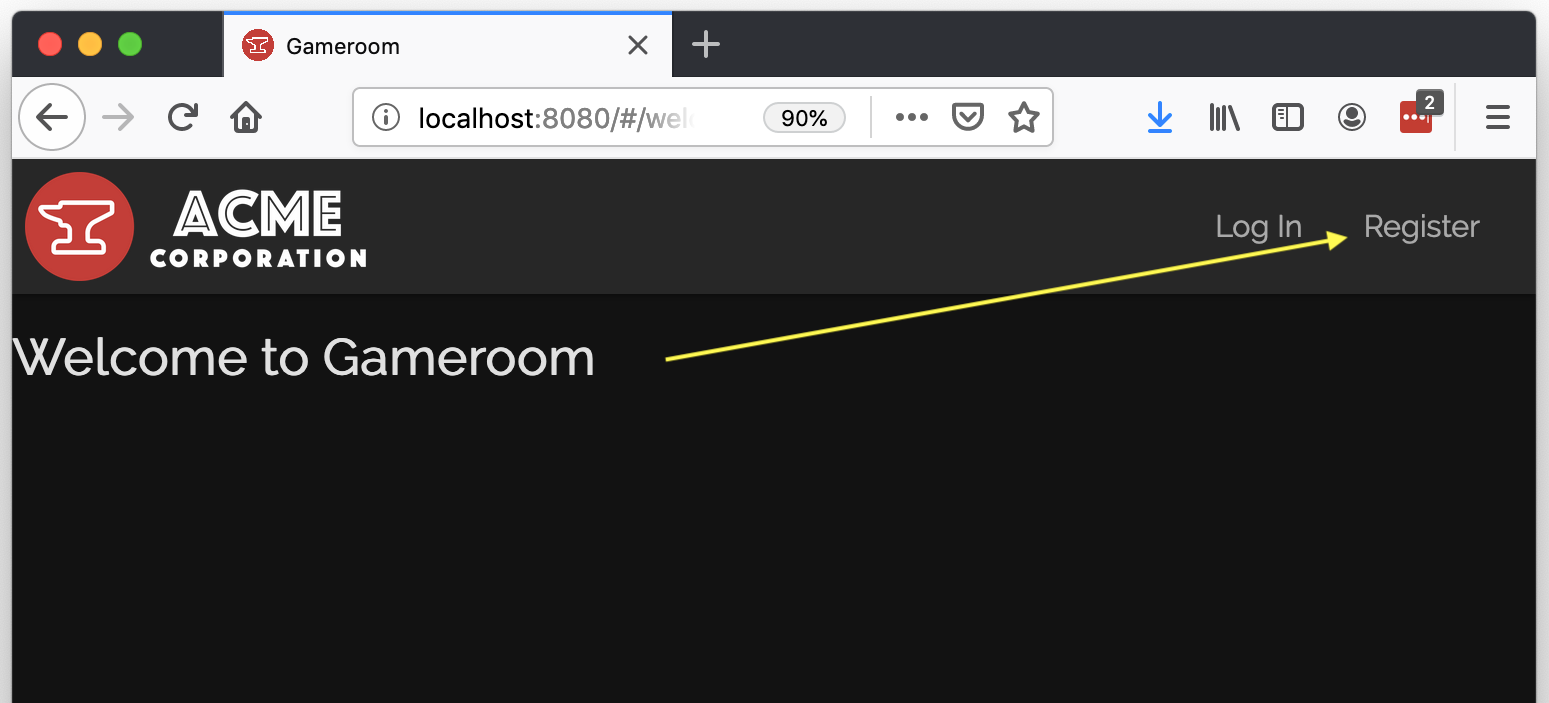
The Register page lets Alice enter her email address, private key, and password. The Gameroom demo docker-compose file generates private keys for Alice and Bob. See section P.1, step 3 to learn how to display these private keys.
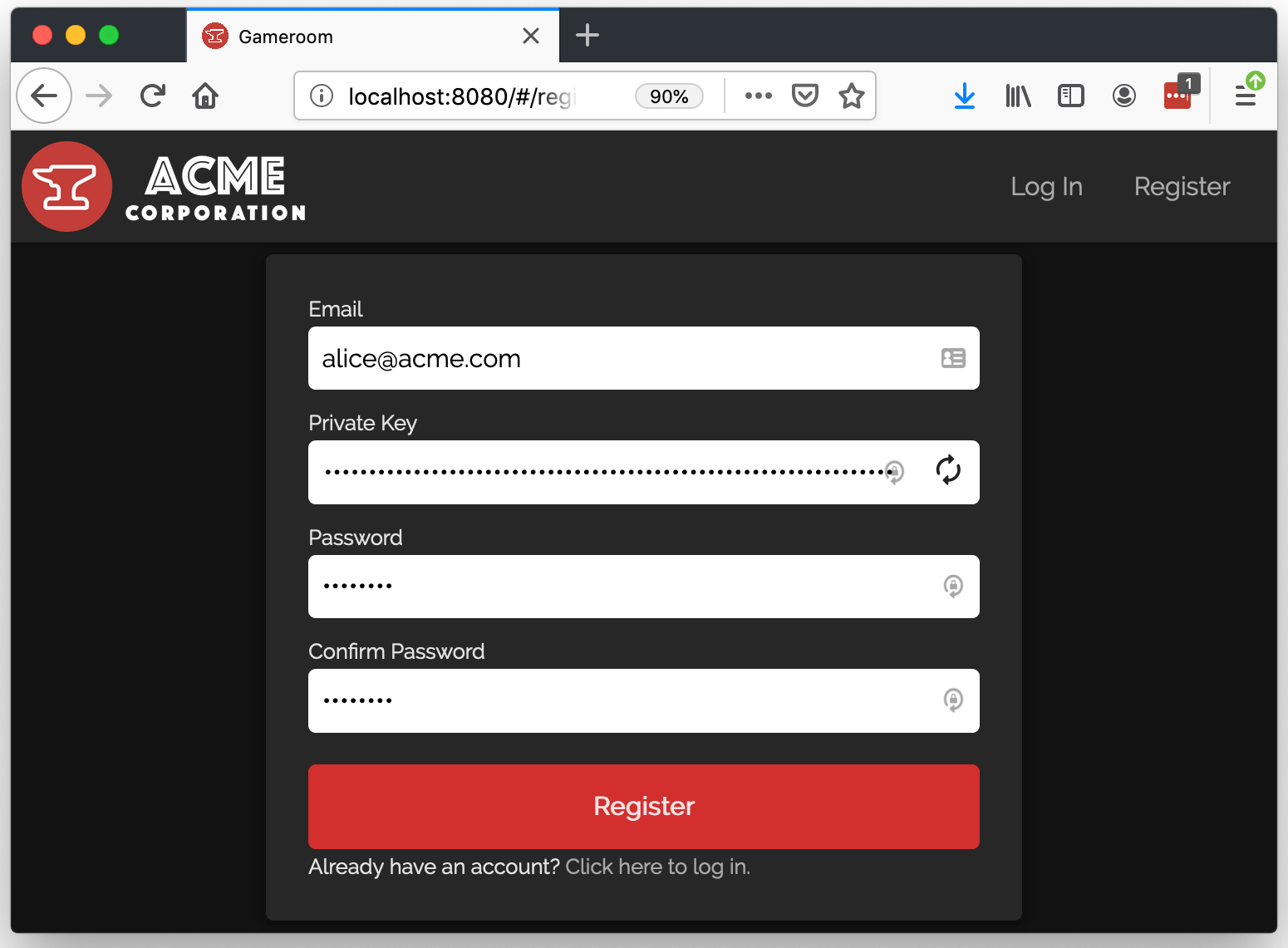
After Alice registers, she is automatically logged in. The Acme Gameroom UI displays the home page.
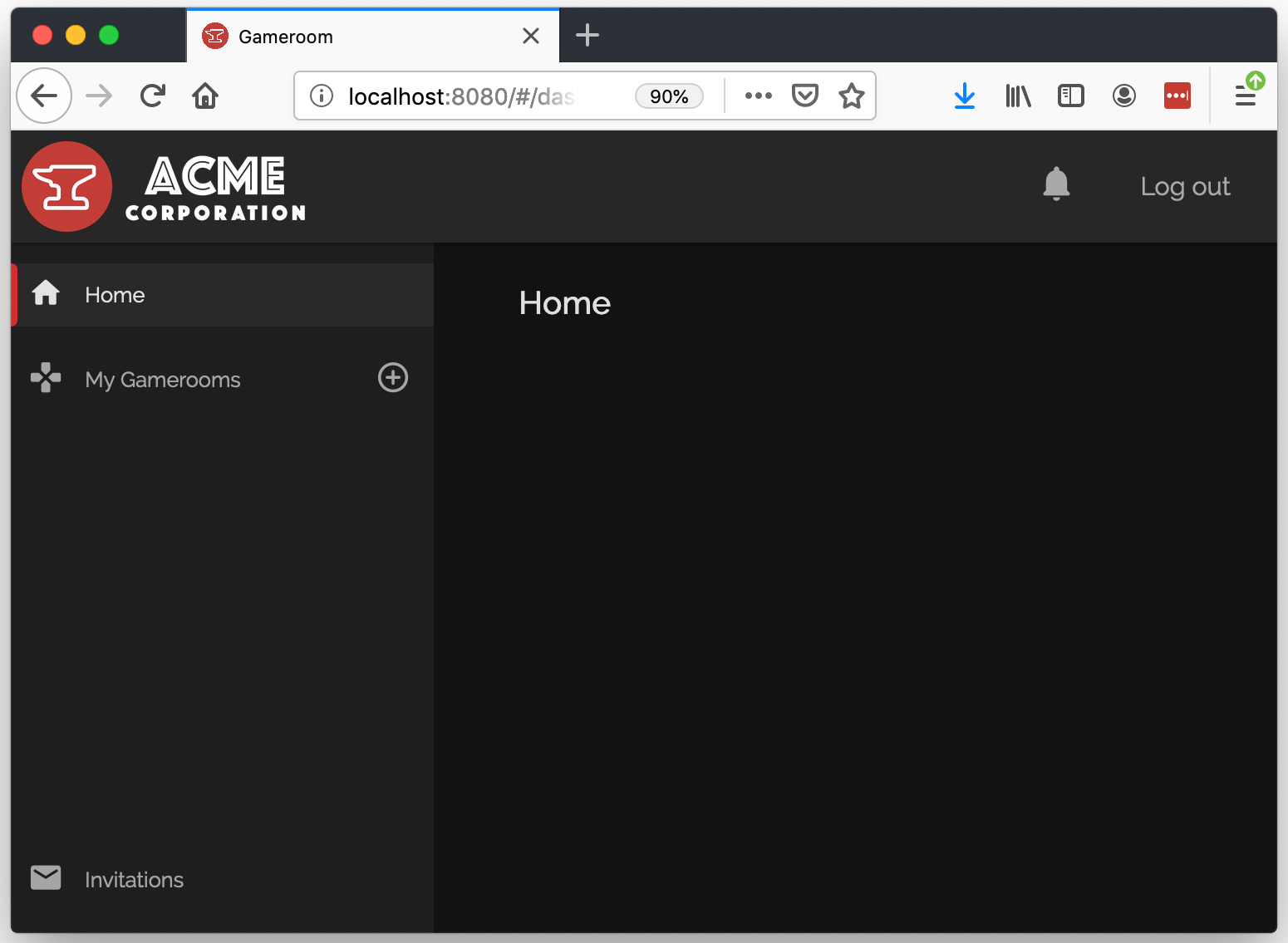
When a new user registers, the Gameroom daemon adds a new entry for that user
to the gameroom_user table in the local Gameroom database. The gameroom_user
table has the following schema:
CREATE TABLE IF NOT EXISTS gameroom_user (
email TEXT PRIMARY KEY,
public_key TEXT NOT NULL,
encrypted_private_key TEXT NOT NULL,
hashed_password TEXT NOT NULL
);
For example, an entry for a new user looks like this:
| hashed_password | public_key | encrypted_private_key | |
|---|---|---|---|
| user@example.com | 56ec82cb...480cad32 | 0384781f...5a7e4998 | {\"iv\":...cgXrm\"} |
P.3: Registering the Gameroom daemon for admin service events
The Gameroom application needs to receive notifications for admin service events (described in Appendix C) so that it can react appropriately to circuit proposal events and other admin events.
To see these events, the Gameroom daemon (gameroomd) must register an
application authorization handler for circuits with a specific circuit
management type. This handler manages the voting strategy for the application
and notifies the application of any events received from the admin service on
the local Splinter node.
As part of the event registration, the application authorization handler must
specify the circuit management type. The circuit_management_type string in
the circuit definition briefly describes the purpose of the circuit. For
example, the Gameroom application uses the type gameroom for its circuits (see
the CircuitManagementPayload definition in
section I-2.3).
When an event occurs (such as a new circuit proposal or vote), each admin service uses a WebSocket connection to notify its application authorization handler about the event. In order to receive WebSocket notifications, each application authorization handler must send a registration request to its Splinter node’s REST API.
For example, the Acme and Bubba Bakery Gameroom daemons would send this registration request:
GET /ws/admin/register/gameroom
See Appendix C for more information on circuit events.
Appendix A: Peer Authorization
This appendix describes the peer authorization process that occurs as part of creating a circuit.
To be able to communicate on a Splinter network, each node and service involved in the proposed circuit must go through authorization. Each node must authorize with the other node (or nodes) involved in the circuit; each service must authorize with its own node. After the node or service is authorized, its peer ID (the node ID or service ID) is used to prove its identity.
Before a node or service is authorized, it can send only authorization messages (in a specific order). If it sends any other messages before the connection is authorized, those messages will be dropped.
A.1: The Authorization Process
When the admin service on the first node (the node where the circuit request originated) requests connections with the other members’ nodes and services (as described in section I-2.4), it starts the process of authorizing the nodes and services on those nodes.
-
First, the node or service requesting authorization is given a temporary peer ID with the following format:
temp-<UUID> -
Next, the node or service sends a
ConnectRequestmessage wrapped in anAuthorizationMessage.The
ConnectRequestspecifies whether the authorization should be bidirectional (both sides) or unidirectional (one side only).-
Connecting Splinter nodes should use bidirectional authorization, because each node must be authorized with the other node.
-
A Splinter service can use unidirectional authorization if it does not require the node to authorize itself with the service.
The following example shows a bidirectional authorization request from a node.
--- ConnectRequest: handshake_mode: BIDIRECTIONAL --- AuthorizationMessage: message_type: CONNECT_REQUEST payload: <bytes of connect request> -
-
When a Splinter node receives a
ConnectRequest, it responds with aConnectResponsethat includes a list of supported authorization types. Currently, the only supported authorization type isTrust, which means that the specified node or service (as identified by the peer ID) will be accepted as valid without any proof.--- ConnectResponse: accepted_authorization_types: [Trust] -
When the node or service requesting authorization receives the
ConnectResponse, it checks the list of accepted authorization types for a matching, supported authorization type. If both sides supportTrustauthorization, this node or service will send aTrustRequestmessage that includes its peer ID (either a node ID or service ID).--- TrustRequest: identity: <ID for the node or service> -
When the node that is being connected to receives the
TrustRequest, it changes the temporary peer ID to the actual peer ID (the node or service ID). -
Next, this node sends an empty
AuthorizedMessageto the connecting node or service to signify that it is now authorized to communicate on the Splinter network.
A.2: Authorization Callbacks
When a new circuit is being created, the admin service may need to create a new
connection to Splinter nodes that are not currently connected. This is done
using the PeerConnector, as described in
section I-2.4. Before the admin
service completes authorization, any AdminDirectMessage it sends will be
dropped. This section describes how authorization callbacks are used to notify
a node or service (such as the admin service) when the authorization process is
complete.
The AuthorizationInquisitor interrogates the authorization status for a given
peer ID, and includes a callback registration function to notify the caller of
changes in peer authorization.
The AuthorizationInquisitor provides two methods:
-
is_authorizedchecks whether a specific peer ID is registered -
register_callback, which takes a boxedAuthorizationCallback, requests notification when a peer’s authorization status changes
pub trait AuthorizationInquisitor: Send {
/// Register a callback to receive notifications about peer
/// authorization statuses.
fn register_callback(
&self,
callback: Box<dyn AuthorizationCallback>,
) -> Result<(), AuthorizationCallbackError>;
/// Indicates whether or not a peer is authorized.
fn is_authorized(&self, peer_id: &str) -> bool;
}
An AuthorizationCallback is a trait that must implement an
on_authorization_change function that is called by the
AuthorizationInquisitor when a peer’s authorization status change. It takes
the peer ID of the node or service whose authorization status has changed and
the new PeerAuthorizationState (either Authorized or Unauthorized).
pub enum PeerAuthorizationState {
Authorized,
Unauthorized,
}
/// A callback for changes in a peer's authorization state.
pub trait AuthorizationCallback: Send {
/// This function is called when a peer's state changes to Authorized
/// or Unauthorized.
fn on_authorization_change(
&self,
peer_id: &str,
state: PeerAuthorizationState,
) -> Result<(), AuthorizationCallbackError>;
}
The admin service is passed an AuthorizationInquisitor on startup. Then the
admin service registers an AuthorizationCallback that will remove pending
payloads from the unpeered_payload queue and move them the pending circuit
payload queue once all required members have successfully peered and authorized.
Appendix B: Consensus
Consensus is used to reach agreement between multiple parties.
Within Splinter, consensus refers to a library that contains consensus algorithm implementations (called “consensus engines”) and a single interface for using those algorithms. Splinter services are typically the consumers of this interface.
In the Gameroom application, both the admin service and the scabbard service use a consensus algorithm called two-phase commit, which is a basic consensus algorithm that requires all participating parties to agree. If any party disagrees, the consensus proposal (the item being considered) is rejected. The Gameroom example uses two-phase commit for items such as circuit proposals, proposal validation, and transactions to add a smart contract.
B.1: Consensus Interface
The consensus interface defines the relationship between a service and a consensus engine.
A Proposal is the entity that consensus agrees on; it contains a summary of
the underlying data that a service would like to commit, as well as information
that may be useful to consensus. The Proposal is defined as a protobuf:
message Proposal {
// The proposal’s identifier, which is a hash of `previous_id`,
// `proposal_height`, and `summary`
bytes id = 1;
// The identifier of the proposal’s immediate predecessor
bytes previous_id = 2;
// The number of proposals preceding this one (used for ordering
// purposes)
uint64 proposal_height = 3;
// A summary of the data this proposal represents
bytes summary = 4;
// Opaque data that is provided by the consensus algorithm
bytes consensus_data = 5;
}
A message sent between consensus engines is called a ConsensusMessage, and is
defined by the following protobuf:
message ConsensusMessage {
// An opaque message that is interpreted by the consensus algorithm
bytes message = 1;
// ID of the service that created this message
bytes origin_id = 2;
}
A service that uses consensus must implement two Rust traits for the consensus
engine to interact with: the ProposalManager trait, which manages the
Proposals that consensus decides on, and the ConsensusNetwork trait, which
an engine uses to send messages to other nodes’ consensus engines.
The consensus algorithm itself is implemented using the ConsensusEngine trait.
B.2: Two-Phase Commit
Two-phase commit (2PC) is a basic consensus algorithm that requires agreement from all parties in order to accept a proposal.
The following diagram summarizes the operation of this algorithm. It shows the activities on two nodes for the consensus engines (2PC-1 and 2PC-2), the proposal managers (PM-1 and PM-2), and the consensus network senders (NS-1 and NS-2).
B.2.1: TwoPhaseMessage Types
Two-phase commit has three message types that are sent between its consensus
engines: PROPOSAL_VERIFICATION_REQUEST, PROPOSAL_VERIFICATION_RESPONSE, and
PROPOSAL_RESULT. The following TwoPhaseMessage protobuf defines these
message types.
message TwoPhaseMessage {
enum Type {
UNSET_TYPE = 0;
PROPOSAL_VERIFICATION_REQUEST = 1;
PROPOSAL_VERIFICATION_RESPONSE = 2;
PROPOSAL_RESULT = 3;
}
enum ProposalVerificationResponse {
UNSET_VERIFICATION_RESPONSE = 0;
VERIFIED = 1;
FAILED = 2;
}
enum ProposalResult {
UNSET_RESULT = 0;
APPLY = 1;
REJECT = 2;
}
Type message_type = 1;
bytes proposal_id = 2;
ProposalVerificationResponse proposal_verification_response = 3;
ProposalResult proposal_result = 4;
}
To send a message to one of its peers, the two-phase commit engine constructs
the TwoPhaseMessage protobuf, serializes it into bytes, and passes it to the
ConsensusNetworkSender, which will then wrap it in a ConsensusMessage and
relay it to one or more peers.
When a two-phase engine receives a consensus message, it extracts and
deserializes the TwoPhaseMessage protobuf, then handles the message.
B.2.2: Startup
When a service using two-phase commit starts up, it creates the consensus engine and runs it in a new thread.
B.2.3: Proposal Creation
The two-phase commit consensus engine can create new proposals when it is not
already performing consensus on a proposal. To create a new proposal, the
consensus engine requests a new proposal from the Splinter service using the
ProposalManager.create_proposal() method.
-
If the service has data for consensus to agree on, it will create a proposal for that data and send it to consensus as a
ProposalCreated(Some(Proposal))update. -
If the service does not have data for consensus, it will send a
ProposalCreated(None)update to consensus, and consensus will ask again after a brief timeout.
After sending the new proposal to the consensus engine, the service sends the
data (the item to be decided on) to the other services in the circuit. The
other services send the new proposal to their respective consensus engines as
a ProposalReceived(Proposal, PeerId) update, where the PeerId is the ID of
the consensus engine that created the proposal.
B.2.4: Coordinator and Initial Verification
A ProposalManager is a Rust trait that must be implemented for a Splinter
service and is used by the consensus engine to create, check, accept, and
reject proposals
When a two-phase commit engine determines that it is the coordinator for a new
proposal, it first asks its service to verify the proposal using the
ProposalManager.check_proposal() method.
If the proposal is valid, the proposal manager replies with a
ProposalValid(ProposalId) update; if it is invalid, it will reply with a
ProposalInvalid(ProposalId) update.
-
In the case of an invalid proposal, the coordinator will simply reject the proposal by calling
ProposalManager.reject_proposal()and instruct its peers to do the same by broadcasting aProposalResult::REJECTmessage. -
In the case of a valid proposal, the coordinator will request verification from the other verifying peers.
B.2.5: Verification
To request verification from the verifying peers, the coordinator broadcasts a
PROPOSAL_VERIFICATION_REQUEST for the proposal using the service’s
ConsensusNetworkSender.broadcast() method.
When each verifying consensus engine receives the
PROPOSAL_VERIFICATION_REQUEST from the coordinator, it verifies the proposal
itself by calling its service’s ProposalManager.check_proposal() method and
waiting for a response.
-
If the verifier receives a
ProposalValidupdate from its proposal manager, it will send aProposalVerificationResponse::VERIFIEDmessage to the coordinator using its service’sConsensusNetworkSender.send_to()method. -
If the verifier receives a
ProposalInvalidupdate, it will send aProposalVerificationResponse::FAILEDmessage to the coordinator.
B.2.6: Proposal Result and Commit/Reject
If the coordinator receives a ProposalVerificationResponse::FAILED response,
the consensus engine tells the ProposalsManager.reject_proposal, which will
roll back any changes being stored in the service.
If the coordinator receives a ProposalVerificationResponse::VERIFIED, the
consensus engine checks whether it has received a verification response from
every peer. If the engine has received all verification requests, it accepts
the proposal and calls ProposalsManager.accept_proposal, which will commit
the pending changes in the Splinter service.
The coordinator then sends a message about the ProposalResult to its peers,
with either an APPLY or REJECT result. This notifies the other peers they
should also accept or reject the proposals.
Appendix C: Circuit Proposal Events
During Gameroom setup (see The Prequel), each node’s Gameroom application authorization handler is registered as an authorization handler for the Gameroom application. This handler receives messages (via a WebSocket connection) about circuit proposal events.
-
The application authorization handler, which is part of the Gameroom daemon, sends a request to the Splinter REST API to register as an authorization handler for the Gameroom application. The request is a WebSocket handshake request that looks like this:
GET /ws/admin/register/gameroom Upgrade: websocket Connection: Upgrade Sec-Websocket-Version: 13 Sec-Websocket-key: 13 -
If the request is successful, the server sends a response indicating that the protocol will change from HTTP to WebSocket. The response looks like this:
HTTP/1.1 101 Switching Protocols Upgrade: websocket Connection: Upgrade Sec-WebSocket-Accept: s3pPLMBiTxaQ9kYGzzhZRbK+xOo= -
After the protocol has been upgraded, the Gameroom Application Authorization Handler receives messages (via the WebSocket connection) about circuit proposal events related to the Gameroom application. The event types include:
ProposalSubmittedProposalRejectedProposalAcceptedProposalVoteCircuitReady
These event messages are serialized JSON.
C.1: ProposalSubmitted event
The serialized JSON message for a ProposalSubmitted event looks like this:
{
"eventType": "ProposalSubmitted",
"message": {
"proposal_type": "Create",
"circuit_id": "my_circuit",
"Circuit_hash": "8e066d41911817a42ab098eda35a2a2b11e93c753bc5ecc3ffb3e99ed99ada0d",
"circuit": {
"circuit_id": "my_circuit",
"roster": [
{
"service_id": "scabbard_123",
"service_type": "scabbard",
"allowed_nodes": [
"acme_corp"
]
}
],
"members": [
{
"node_id": "Node-123",
"endpoint": "127.0.0.1:8282”
}
],
"authorization_type": "Trust",
"persistence": "Any",
"routes": "Any",
"circuit_management_type": "gameroom",
"application_metadata": []
},
"votes": [],
"requester": "<requester public key>"
"requester_node_id": <node id of the node the requester is registered"
}
}
C.2: ProposalRejected event
The serialized JSON message for a ProposalRejected event looks like this:
{
"eventType": "ProposalRejected",
"message": {
"proposal_type": "Create",
"circuit_id": "my_circuit",
"circuit_hash": "8e066d41911817a42ab098eda35a2a2b11e93c753bc5ecc3ffb3e99ed99ada0d",
"circuit": {
"circuit_id": "my_circuit",
"roster": [
{
"service_id": "scabbard_123",
"service_type": "scabbard",
"allowed_nodes": [
"acme_corp"
]
}
],
"members": [
{
"node_id": "Node-123",
"endpoint": "127.0.0.1:8282”
}
],
"authorization_type": "Trust",
"persistence": "Any",
"routes": "Any",
"circuit_management_type": "gameroom",
"application_metadata": []
},
"votes": [{
“public_key”: “<publickeyofvoter>”,
“vote”: “Rejected”
"voter_node_id": “ <node id of the node the requester is registered>”
}],
"requester": "<requester public key>"
"requester_node_id": <node id of the node the requester is registered>"
}
}
C.3: ProposalAccepted event
The serialized JSON message for a ProposalAccepted event looks like this:
{
"eventType": "ProposalAccepted",
"message": {
"proposal_type": "Create",
"circuit_id": "my_circuit",
"circuit_hash": "8e066d41911817a42ab098eda35a2a2b11e93c753bc5ecc3ffb3e99ed99ada0d",
"circuit": {
"circuit_id": "my_circuit",
"roster": [
{
"service_id": "scabbard_123",
"service_type": "scabbard",
"allowed_nodes": [
"acme_corp"
]
}
],
"members": [
{
"node_id": "Node-123",
"endpoint": "127.0.0.1:8282”
}
],
"authorization_type": "Trust",
"persistence": "Any",
"routes": "Any",
"circuit_management_type": "gameroom",
"application_metadata": []
},
"votes": [{
“public_key”: “<publickeyofvoter>”,
“vote”: “Accepted”
"voter_node_id": “ <node id of the node the requester is registered>”
}],
"requester": "<requester public key>"
"requester_node_id": <node id of the node the requester is registered>"
}
}
C.4: ProposalVote event
The serialized JSON message for a ProposalVote event looks like this:
{
"eventType": "ProposalVote",
"message": {
"proposal_type": "Create",
"circuit_id": "my_circuit",
"circuit_hash": "8e066d41911817a42ab098eda35a2a2b11e93c753bc5ecc3ffb3e99ed99ada0d",
"circuit": {
"circuit_id": "my_circuit",
"roster": [
{
"service_id": "scabbard_123",
"service_type": "scabbard",
"allowed_nodes": [
"acme_corp"
]
}
],
"members": [
{
"node_id": "Node-123",
"endpoint": "127.0.0.1:8282”
}
],
"authorization_type": "Trust",
"persistence": "Any",
"routes": "Any",
"circuit_management_type": "gameroom",
"application_metadata": []
},
"votes": [{
“public_key”: “<publickeyofvoter>”,
“vote”: “Accepted”
"voter_node_id": “ <node id of the node the requester is registered>”
}],
"requester": "<requester public key>"
"requester_node_id": <node id of the node the requester is registered>"
},
}
Appendix D: XO Smart Contract Specification
The XO smart contract allows users to play the simple board game tic tac toe (also known as “Noughts and Crosses” or “X’s and O’s”).
D.1: XO State Entries
An XO state entry consists of the UTF-8 encoding of a string with exactly four commas, which has the following format:
<game-name>,<game-board>,<game-state>,<player1-key>,<player2-key>
-
<game-name>is the name of the game, as a non-empty string that does not contain the character|. -
<game-board>represents the game board as a 9-character string (called “the board string”) that contains onlyO,X, or-. -
<game-state>is one of the following:P1-NEXT,P2-NEXT,P1-WIN,P2-WIN, orTIE. (P1andP2stand for “player 1” and “player 2”.) -
<player1-key>and<player2-key>are the (possibly empty) public keys associated with the game’s players.
In the event of a hash collision (two or more state entries sharing the same address), the colliding state entries are stored as the UTF-8 encoding of the following string, with entries sorted alphabetically:
<a-entry>|<b-entry>|...
D.1.1: State Adressing
XO data is stored in state using addresses generated from the XO “family name” (explained below) and the name of the game being stored.
In particular, an XO address consists of the first 6 characters of the SHA-512
hash of the UTF-8 encoding of the string “xo” (which is “5b7349”), plus the
first 64 characters of the SHA-512 hash of the UTF-8 encoding of the game name.
For example, the XO address for a game called “mygame” could be generated as follows:
>>> hashlib.sha512('xo'.encode('utf-8')).hexdigest()[:6] +
hashlib.sha512('mygame'.encode('utf-8')).hexdigest()[:64]
'5b7349700e158b598043efd6d7610345a75a00b22ac14c9278db53f586179a92b72fbd'
D.2: XO Transaction Payload
An XO transaction request payload consists of the UTF-8 encoding of a string with exactly two commas, which is formatted as follows:
<name>,<action>,<space>
-
<name>is the game name, as a non-empty string not containing the character|. If<action>is create, the new name must be unique. -
<action>is the game action:create,take, ordelete. -
<space>is the location on the board, as an integer between 1-9 (inclusive), if<action>istake.
D.3: XO Transaction Header
Each XO transaction must include a header with the required inputs and outputs, plus the XO “family name” and version.
D.3.1: Inputs and Outputs
The inputs and outputs for an XO transaction are just the state address generated from the transaction game name.
D.3.2: Dependencies
XO transactions have no explicit dependencies.
D.3.3: Family Name and Version
Each smart contract has a “family name”, which identifies the smart contract type, and a version number. The term “family” comes from the XO transaction family (and transaction processor) in Sawtooth, which is an off- chain version of the XO business logic.
-
family_name: "xo" -
family_version: "1.0"
D.4: XO Execution
When a running XO smart contract receives a transaction request and a state
dictionary, it checks the validity of the request. A valid transaction request
payload has a game name, an action, and (if the action is take) a space.
Next, the XO smart contract checks whether the transaction (the requested action) is valid, then updates the state entry according to the specified action.
-
If the action is
create, the transaction is invalid if the game name is already in state dictionary. Otherwise, the smart contract will store a new state entry with board---------(a blank board), game stateP1-NEXT, and empty strings for both player keys. -
If the action is
delete, the transaction is invalid if the game name is not in the state dictionary. Otherwise, the smart contract will delete the state entry for the game. -
If the action is
take, the transaction is invalid if the game name is not in the state dictionary. Otherwise, there is a state entry under the game name with a board, game state, player-1 key, and player-2 key.
When the action is take, the smart contract updates the game’s state entry
as follows:
-
If the game name is in the state dictionary, the transaction is invalid if one of the following is true:
-
The game state is
P1-WIN,P2-WIN, orTIE -
The game state is
P1-NEXT, the player-1 key is not null, and the player-1 key is different from the transaction signing key -
The game state is
P2-NEXT, the player-2 key is not null, and the player-2 key is different from the transaction signing key -
The specified (“space-th”) character in the board string has already been claimed (is not
-).
-
-
Otherwise, the smart contract will update the state entry as follows:
a. Player keys: If the player-1 key is null (the empty string), it will be updated to the key with which the transaction was signed. If the player-1 key is not null and the player-2 key is null, the player-2 key will be updated to the signing key. Otherwise, the player keys will not be changed.
b. Board: If the game state is
P1-NEXT, the board will be updated with anX(player 1’s character) in the specified space. That is, the updated board will be the same as the initial board, except with the “space-th” character replaced by the character X. If the game state isP2-NEXT, the same action occurs with anO(player 2’s character).c. Game state: The smart contract updates the game state based on the contents of the board string. In this description, the first three characters of the board string represent the first row, the next three characters are the second row, and the last three characters are the third row.
A character has a win on the board if any of the following is true:
-
If any row consists of the same character.
-
If the same character appears in a column (all the rows have the same first or second or third character).
-
If the same character appears in a diagonal line (the first character/first row, second character/second row, and third character/third row are the same; or the third character /first row, second character/second row, and first character/third row are the same).
-
-
Then the smart contract checks for a tie:
-
If
Xhas a win on the board andOdoesn’t, the updated state will beP1-WINS. -
If
Ohas a win on the board andXdoesn’t, the updated state will beP2-WINS. -
Otherwise, if the updated board has no empty spaces (does not contain
-), the updated state will beTIE. -
Otherwise, the game continues and the other player takes a turn. If the initial state was
P1-NEXT, the updated state will beP2-NEXT. Conversely, if the initial state wasP2-NEXT, the updated state will beP1-NEXT.
-
Glossary
admin circuit
Splinter circuit that automatically includes the admin services of all connected nodes. This circuit is used to send administrative messages for operations such as circuit creation.
admin service
Splinter service that handles administration tasks. In the Gameroom
application, the admin service is part of the Splinter daemon
(splinterd) that runs on each node.
Each admin service has a service ID in the form admin::{nodeID}.
For example, the service ID for Gameroom's Acme admin service is
admin::acme-node-000.
alias
User-supplied name for a circuit. The Gameroom UI calls this a "gameroom name".
application authorization handler
Part of an application that handles notifications for pending circuit proposals and commit protocol updates. The application authorization handler also determines how voting is handled for the application, such as waiting for the client to submit a manual vote or accepting all received proposals. The application authorization handler must register with the admin service (using the Splinter REST API) for a specific circuit management type, so that the admin service knows which circuit proposals are controlled by this handler.
circuit
Splinter connection between organizations (nodes) that provides private communication, as managed by services on each node. A client application might use a different term; for example, the Gameroom application calls this a "gameroom". In addition, all nodes can connect to an admin circuit that handles administration functions.
circuit management type
String (stored in a circuit definition) that indicates which application authorization handler will handle this circuit's change proposals. An application authorization handler uses this string when registering as a handler with the node's admin service.
circuit proposal
Circuit that has been requested but is not final. A circuit proposal, which is stored in the admin service, contains the pending circuit definition and the votes for or against the proposal. The pending circuit in the proposal cannot be used for communication until the circuit is approved and the accepted proposal is committed.
circuit roster
Set of services that are authorized to communicate over the circuit.
client
Short term for a client application for Splinter. A client application usually includes a user interface (UI) and a server-side daemon with application- specific handlers. For example, the Gameroom client has a web-based browser interface and a Gameroom daemon, gameroomd.
consensus
Splinter component that is used by services to agree on shared state.
consensus proposal
Encapsulation of data that services want to agree on (like a transaction), plus consensus-specific information such as ID and ordering information.
Gameroom
Example multi-party Splinter application (also called a "distributed application") that creates circuits with specific members. Note that the capital G marks the application name; an individual circuit is called a gameroom (with a lower-case g).
gameroomd
Gameroom daemon; part of the example Gameroom application that provides the Gameroom REST API and Gameroom application authorization handler.
invitation
Gameroom application's term for a circuit proposal that contains a pending circuit.
member
Splinter node that is a proposed or actual participant in a circuit.
peer nodes
Splinter nodes that have an authorized (authenticated) connection to each other. Peering is a trusted connection between nodes.
peer services
Splinter services that share an isolated portion of state on a circuit.
pending circuit
Proposed circuit (defined in a circuit proposal) that is waiting for approval and is not yet ready for use. The Gameroom application uses the term "invitation" and marks proposed gamerooms with the status "Pending".
scabbard
Splinter service that includes the Sawtooth Sabre transaction handler and Transact, using two-phase commit consensus to agree on state. This application-specific service is specifically configured to work with the example Gameroom application.
scabbard REST API
Endpoints exposed by the Splinter REST API that allow interactions with a scabbard service (for operations such as adding batches).
service
Portion of a daemon that handles administration or application-specific functions, such as the Splinter daemon's admin service or the Gameroom daemon's scabbard service. A service has a service ID that is specified in the circuit definition.
service orchestrator
Splinter component that is used by the admin service to initialize new services when a circuit is created.
splinterd
Splinter daemon that includes a Splinter REST API and an admin service.
state delta export
Process of reading state-change updates from Splinter and uploading them to a
local database. An application provides this functionality in a state delta
processor (or state delta export process). For example, the Gameroom
application registers for XO smart contract updates and uses the
XoStateDeltaProcessor to process the information.
two-phase commit
Basic consensus algorithm that requires all participating parties to agree. If any party disagrees, the consensus proposal (the item being considered) is rejected.




















